Samsung Electronics Co ML1250 Laser Printer User Manual Part1
Samsung Electronics Co Ltd Laser Printer Users Manual Part1
Contents
- 1. Users Manual Part1
- 2. Users Manual Part2
Users Manual Part1
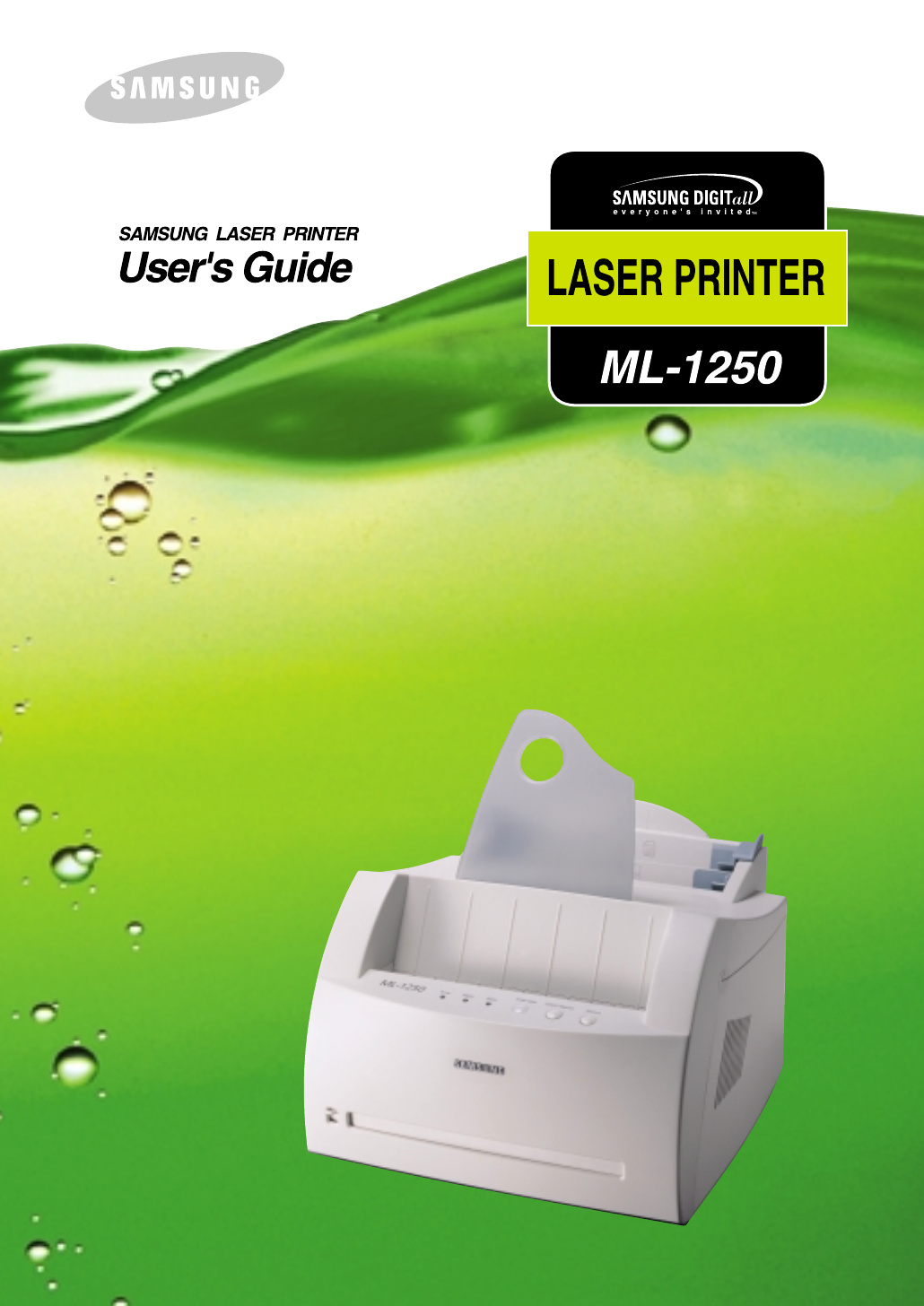

This manual is provided for information purposes only. All information included herein is
subject to change without notice. Samsung Electronics is not responsible for any damages, direct
or indirect, arising from or related to use of this manual.
© 2001 Samsung Electronics Co., Ltd. All rights reserved.
• ML-1250 and Samsung logo are trademarks of Samsung Electronics Co., Ltd.
• IBM and IBM PC are trademarks of International Business Machines Corporation.
• Microsoft, Windows, Windows 9x, Windows Me, Windows NT and Windows 2000 are
trademarks of Microsoft Corporation.
• PCL6 are trademarks of Hewlett-Packard Company.
• Apple, Macintosh, Power Macintosh, iMac and iBook are trademarks of Apple Computer, Inc.
• GNU Ghostscript software, Copyright (C) 1999. Aladdin Enterprise, Menlo Park, California,
and other authors as indicated in its documentation.
• All other brand or product names are trademarks of their respective companies or
organizations.
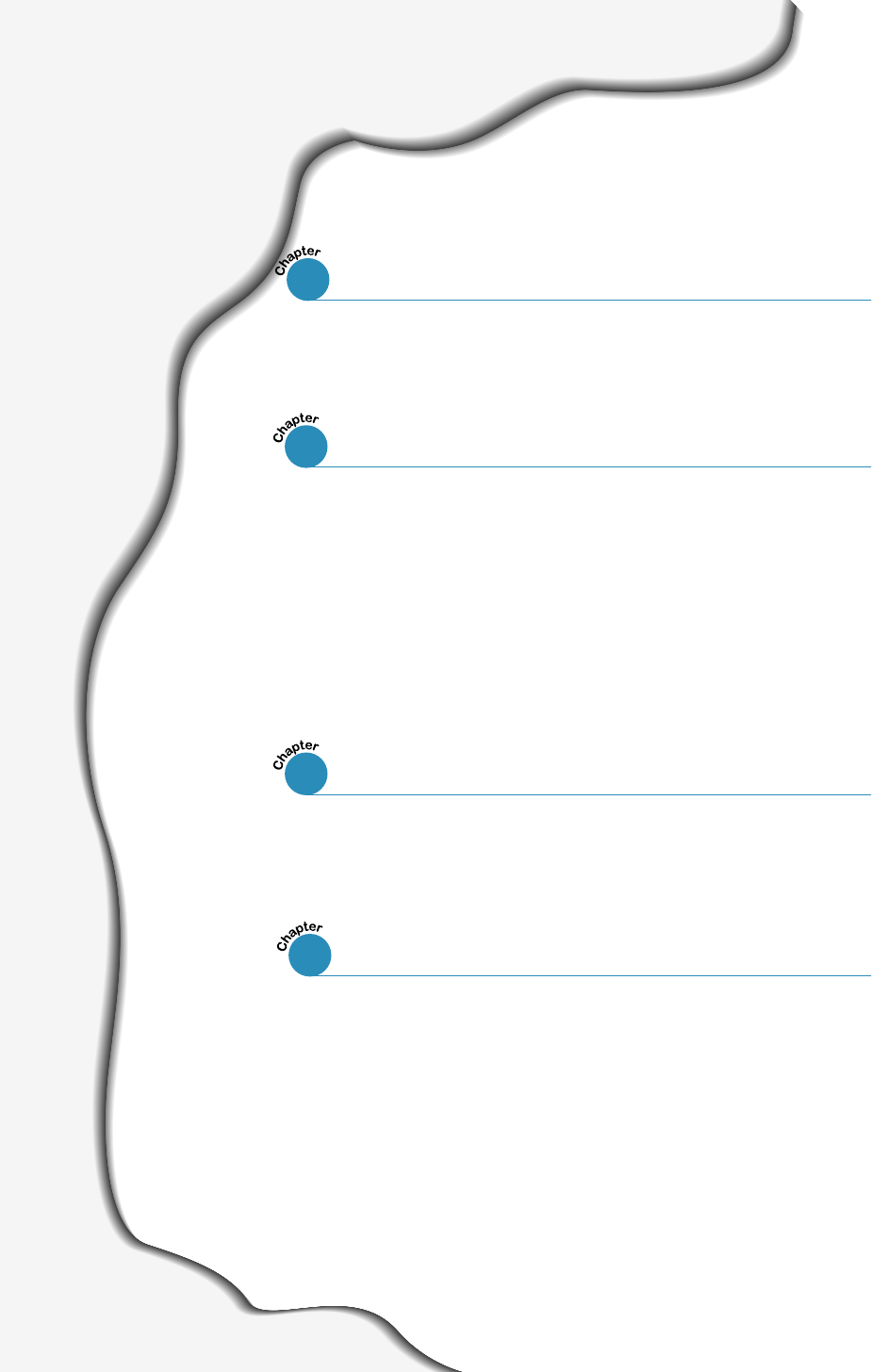
I
Special Features
–––––––––––––––––––––––––––––––––
1.1
Printer Components
––––––––––––––––––––––––––––––
1.3
Control Panel Buttons –––––––––––––––––––––––––––––– 3.1
Control Panel Lights ––––––––––––––––––––––––––––––– 3.3
Contents
Introduction
STEP 1:Unpack Your Printer –––––––––––––––––––––––––– 2.1
STEP 2:Install the Toner Cartridge ––––––––––––––––––––– 2.2
STEP 3:Load Paper ––––––––––––––––––––––––––––––––– 2.4
STEP 4:Connect to the Computer with a Parallel Cable ––––– 2.6
STEP 5:Turn on the Printer ––––––––––––––––––––––––––– 2.7
STEP 6:Print a Demo Page! ––––––––––––––––––––––––––– 2.7
STEP 7:Install the Printer Software ––––––––––––––––––––– 2.8
Installing Software from Diskette –––––––––––––––––––– 2.13
Choosing Paper and Other Media ––––––––––––––––––––– 4.1
Selecting the Output Location ––––––––––––––––––––––– 4.4
Loading Paper –––––––––––––––––––––––––––––––––––– 4.5
Printing on Envelopes –––––––––––––––––––––––––––––– 4.7
Printing on Heavy Paper –––––––––––––––––––––––––––– 4.9
Printing on Labels –––––––––––––––––––––––––––––––– 4.10
Printing on Transparencies ––––––––––––––––––––––––– 4.11
Printing on Preprinted Paper ––––––––––––––––––––––– 4.12
Printing on Card Stock or Custom-sized Media –––––––––– 4.13
1
2
Setting Up Your Printer
3
Using Control Panel
4
Print Media
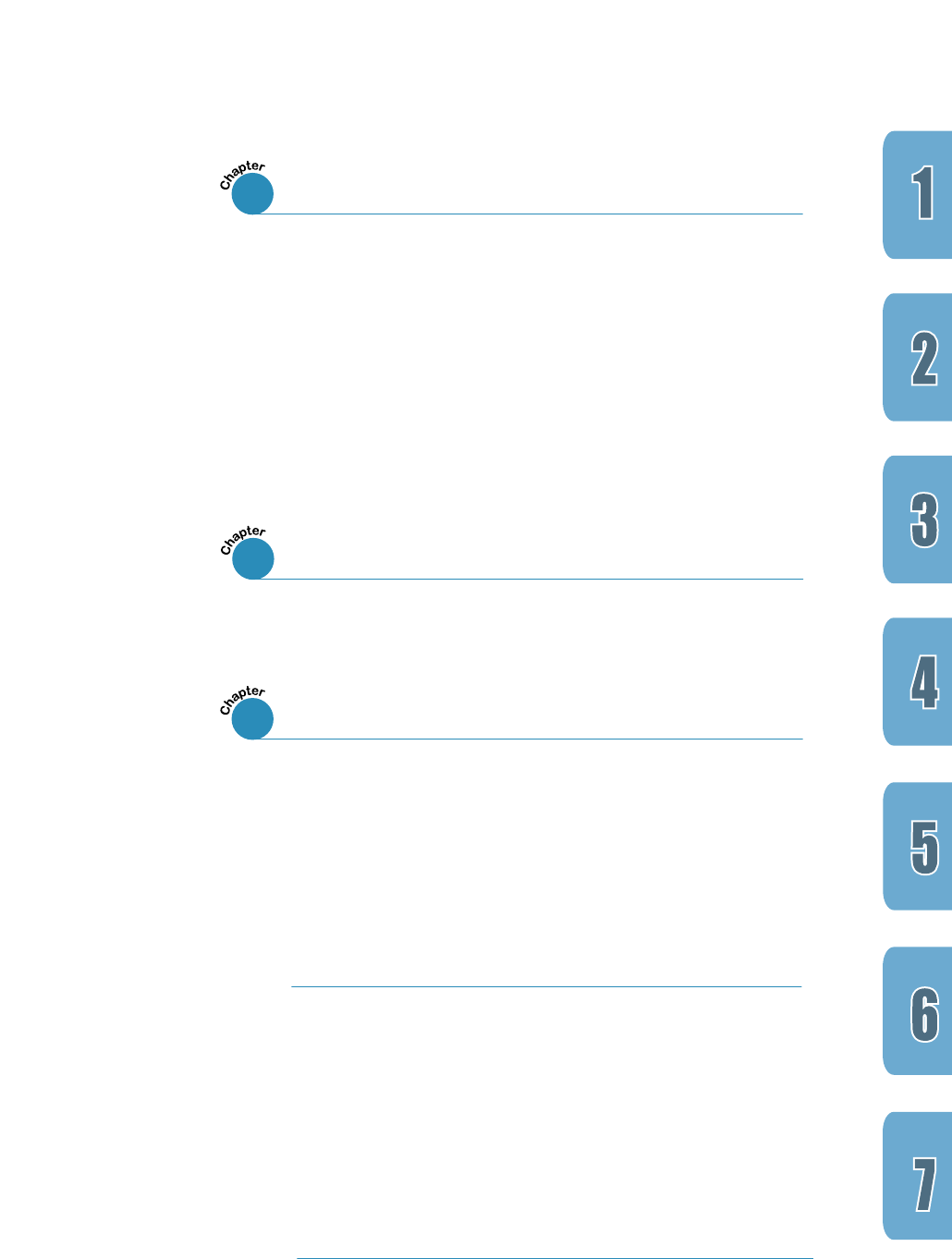
II
Maintaining Toner Cartridge ––––––––––––––––––––––––– 6.1
Cleaning the Printer ––––––––––––––––––––––––––––––– 6.4
Maintaining Your Printer
6
Printing a Document ––––––––––––––––––––––––––––––– 5.1
Using Toner Save Mode –––––––––––––––––––––––––––– 5.6
Printing Multiple Pages on One Sheet of Paper
––––––––––
5.7
Fitting Your Document to a Selected Paper Size ––––––––– 5.8
Printing Posters ––––––––––––––––––––––––––––––––––– 5.9
Setting Graphic Properties ––––––––––––––––––––––––– 5.11
Printing Watermarks –––––––––––––––––––––––––––––– 5.14
Using Page Overlay ––––––––––––––––––––––––––––––– 5.17
Reprinting the Last Page –––––––––––––––––––––––––– 5.21
Printing on a Network Environment ––––––––––––––––––– 5.22
Printing Tasks
5
Troubleshooting Checklist ––––––––––––––––––––––––––– 7.1
Solving General Printing Problems –––––––––––––––––––– 7.2
Clearing Paper Jams ––––––––––––––––––––––––––––––– 7.6
Solving Print Quality Problems –––––––––––––––––––––– 7.11
Troubleshooting Error Messages ––––––––––––––––––––– 7.17
Common Windows Problems –––––––––––––––––––––––– 7.19
Problem Solving
7
Printer Specifications ––––––––––––––––––––––––––––––– A.1
Paper Specifications –––––––––––––––––––––––––––––––– A.2
Using Your Printer with a USB Cable ––––––––––––––––– A.10
Using Your Printer with Macintosh ––––––––––––––––––– A.16
Printing from DOS Applications ––––––––––––––––––––– A.23
Linux Driver Installation ––––––––––––––––––––––––––– A.28
Installing Optional Memory Card ––––––––––––––––––––– A.30
Appendix
INDEX
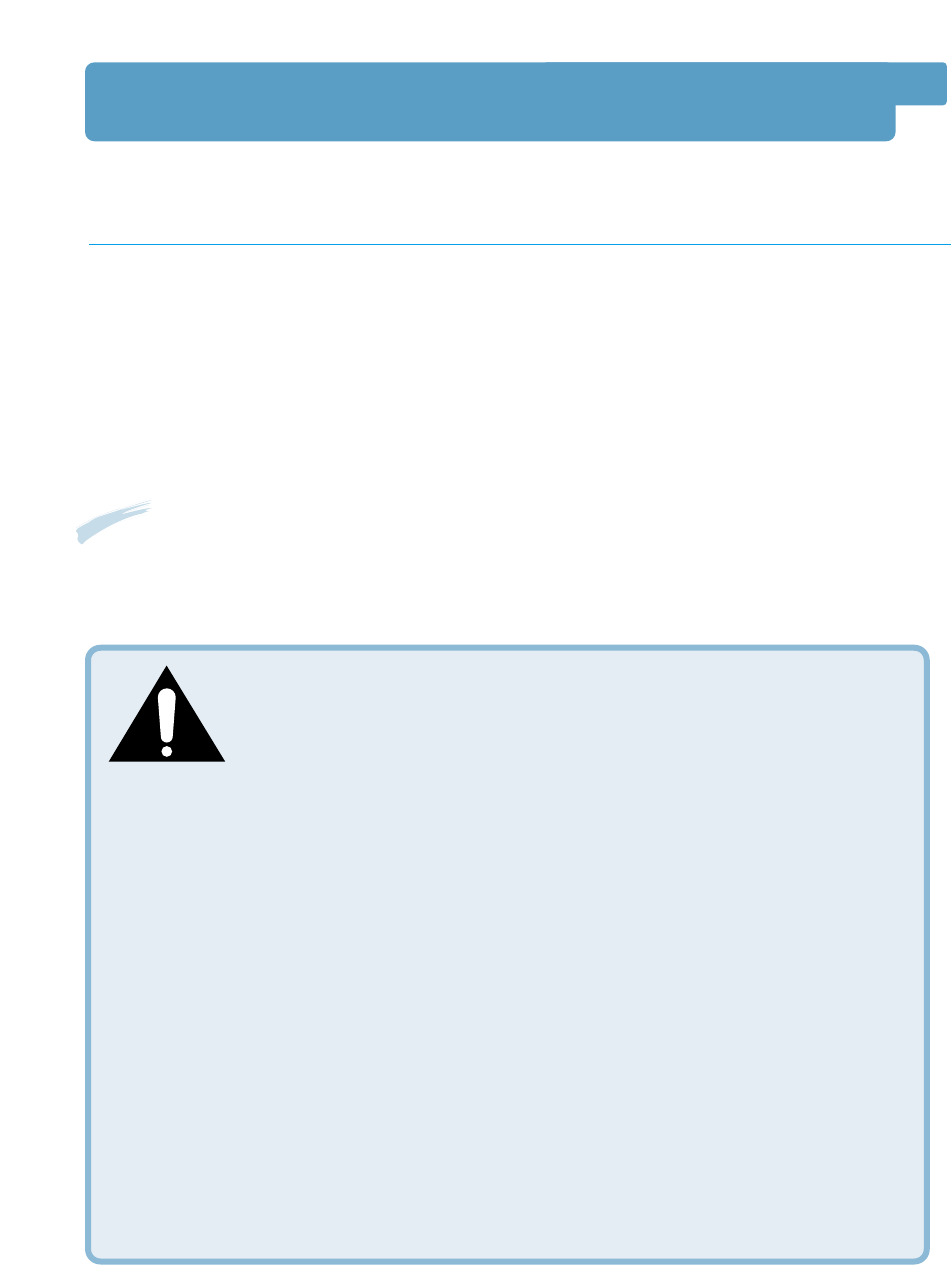
III
Environmental and Safety Consideration
The printer is certified in the U.S. to conform to the requirements of DHHS 21 CFR, chapter 1
Subchapter J for Class I(1) laser products, and elsewhere is certified as a Class I laser product
conforming to the requirements of IEC 825.
Class I laser products are not considered to be hazardous. The laser system and printer are
designed so there is never any human access to laser radiation above a Class I level during
normal operation, user maintenance, or prescribed service condition.
WARNING
Never operate or service the printer with the protective cover removed from Laser/Scanner
assembly. The reflected beam, although invisible, can damage your eyes.
CAUTION - INVISIBLE LASER RADIATION WHEN THIS COVER OPEN. DO
NOT OPEN THIS COVER.
VORSICHT - UNSICHTBARE LASERSTRAHLUNG, WENN ABDECKUNG GEÖFFNET. NICHT
DEM STRAHL AUSSETZEN.
ATTENTION - RAYONNEMENT LASER INVISIBLE EN CAS D’OUVERTURE.EXPOSITION DAN
GEREUSE AU FAISCEAU.
ATTENZIONE -RADIAZIONE LASER INVISIBILE IN CASO DI APERTURA.
EVITARE L’ESPOSIZIONE AL FASCIO.
PRECAUCION -RADIACION LASER IVISIBLE CUANDO SE ABRE. EVITAR EXPONERSE AL
RAYO.
ADVARSEL. - USYNLIG LASERSTRÅLNING VED ÅBNING NÅR SIKKERHEDSBRYDERE ER
UDE AF FUNKTION. UNDGÅ UDSAETTELSE FOR STRÅLNING.
ADVARSER. - USYNLIG LASERSTRÅLNING NÅR DEKSEL ÅPNES. STIRR IKKE INN I
STRÅLEN. UNNGÅ EKSPONERING FOR STRÅLEN.
VARNING - OSYNLIG LASERSTRÅLNING NÄR DENNA DEL ÄR ÖPPAND OCH SPÄRREN ÄR
URKOPPLAD. BETRAKTA EJ STRÅLEN. STRÅLEN ÄR FARLIG.
VARO! - AVATTAESSA JA SUOJALUKITUS OHITETTAESSA OLET ALTTIINA
NÄKYMÄTTÖMÄLLE LASERSÄTEILYLLE ÄLÄ KATSO SÄTEESEEN.
Laser Safety Statement
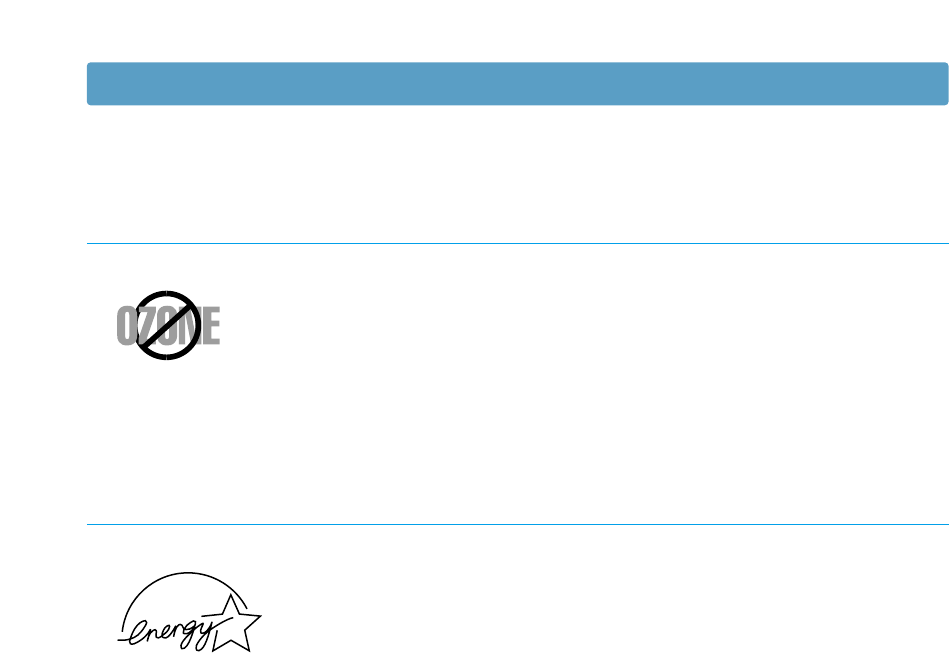
IV
Environmental and Safety Consideration
Ozone Safety
Power Saver
During normal operation, the Samsung ML-1250 Series printer
produces ozone. The ozone produced does not present a hazard to
the operator. However, it is advisable that the machine be operated
in a well ventilated area.
If you need additional information about ozone, please request
your nearest Samsung dealer.
This printer contains advanced energy conservation technology
that reduces power consumption when it is not in active use.
When the printer does not receive data for an extended period of
time, power consumption is automatically lowered.
The energy star emblem does not represent EPA endorsement of
any product or service.

V
Environmental and Safety Consideration
Do not make any changes or modifications to the equipment unless otherwise specified in the
manual. If such changes or modifications should be made, you must first stop operation of the
equipment.
Use of shielded cable is required to comply with Class B limits in Subpart B of Part 15 of FCC
Rules.
This digital apparatus does not exceed the Class B limits for radio noise emissions from digital
apparatus as set out in the interference-causing equipment standard entitled “Digital
Apparatus”, ICES-003 of the Industry and Science Canada.
Cet appareil numérique respecte les limites de bruits radioélectriques applicables aux appareils
numériques de Classe B prescrites dans la norme sur le matériel brouilleur: “Appareils
Numériques”, ICES-003 édictée par l’Industrie et Sciences Canada.
Canadian Radio Interference Regulations
CAUTION: Changes or modifications not expressly approved by the manufacture
responsible for compliance could void the user’s authority to operate the
equipment.
This equipment has been tested and found to comply with the limits for a Class B digital
device, pursuant to Part 15 of the FCC Rules. These limits are designed to provide reasonable
protection against harmful interference in a residential installation. This equipment generates,
uses and can radiate radio frequency energy and, if not installed and used in accordance with
the instructions, may cause harmful interference to radio communications. However, there is
no guarantee that interference will not occur in a particular installation.
If this equipment does cause harmful interference to radio or television reception, which can
be determined by turning the equipment off and on, the user is encouraged to try to correct
the interference by one or more of the following measures:
• Reorient or relocate the receiving antenna.
• Increase the separation between the equipment and receiver.
• Connect the equipment into an outlet on a circuit different from that to which the receiver
is connected.
• Consult the dealer or an experienced radio/TV technician for help.
Fcc Regulations
Radio Frequency Emissions

VI
Environmental and Safety Consideration
Declaration of Conformity (European Countries)
Approvals and Certifications
The CE marking applied to this product symbolises Samsung Electronics Co.,
Ltd. Declaration of Conformity with the following applicable 93/68/EEC
Directives of the European Union as of the dates indicated:
January 1, 1995: Council Directive 73/23/EEC Approximation of the laws of the
member states related to low voltage equipment.
January 1, 1996: Council Directive 89/336/EEC (92/31/EEC), approximation of
the laws of the Member States related to electromagnetic compatibility.
March 9, 1999: Council Directive 1999/5/EC on radio equipment and
telecommunications terminal equipment and the mutual recognition of their
conformity.
A full declaration, defining the relevant Directives and referenced standards can
be obtained from your Samsung Electronics Co., Ltd. representative.
EC Certification
Certification to 1999/5/EC Radio Equipment & Telecommunications Terminal
Equipment Directive (FAX)
This Samsung product has been self-certified by Samsung for pan-European
single terminal connection to the analogue public switched telephone network
(PSTN) in accordance with Directive 1999/5/EC. The product has been designed
to work with the national PSTNs and compatible PBXs of the European
countries:
In the event of problems, you should contact the Euro QA Lab of Samsung
Electronics Co., Ltd. in the first instance.
The product has been tested against TBR21 and TBR 38. To assist in the use
and application of terminal equipment which complies with this standard, the
European Telecommunication Standards Institute (ETSI) has issued an advisory
document (EG 201 121) which contains notes and additional requirements to
ensure network compatibility of TBR21 terminals. The product has been
designed against, and is fully compliant with, all of the relevant advisory notes
contained in this document.
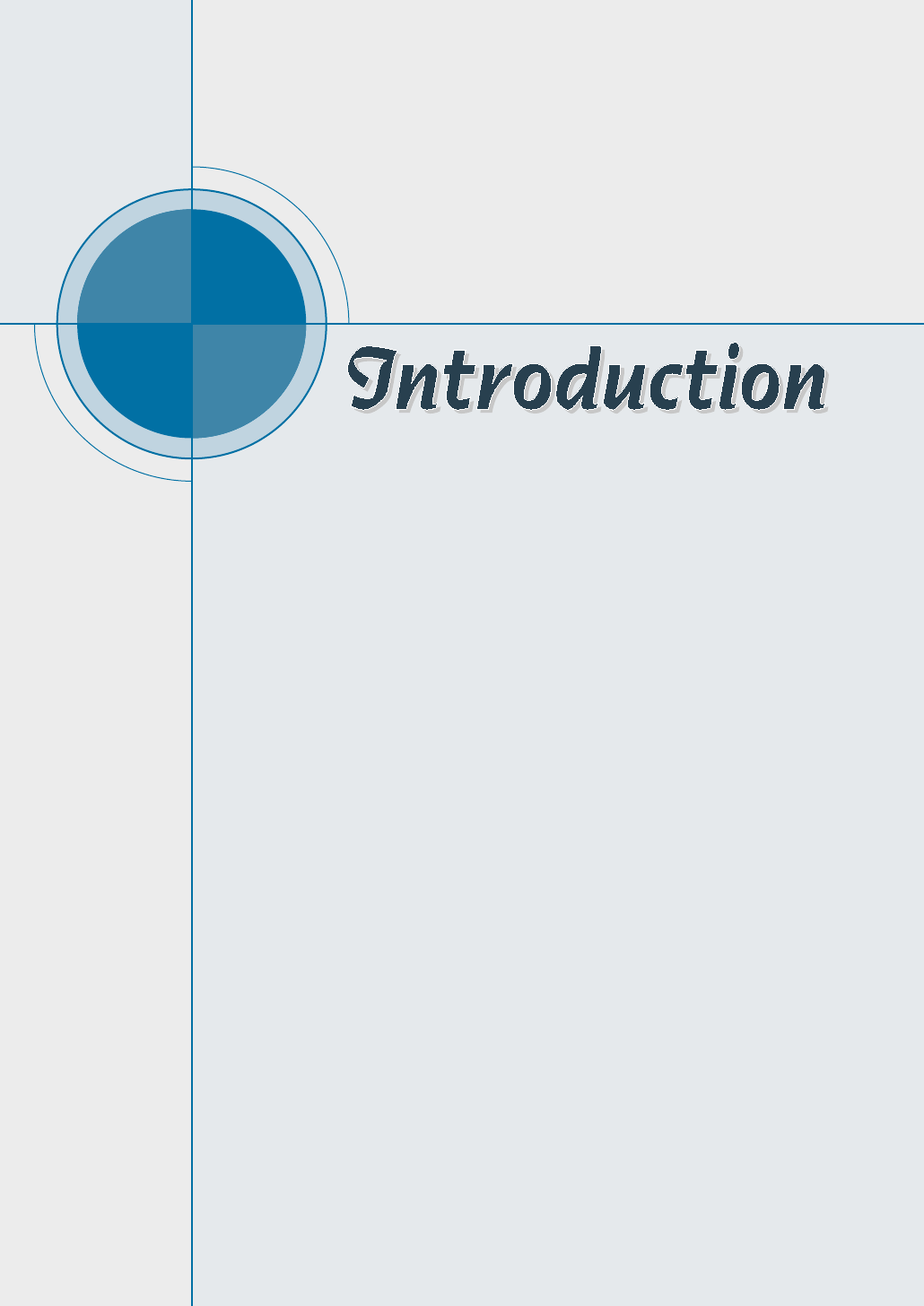
chapter
Congratulations on your purchase of a Samsung ML-1250
printer! This chapter provides information on the
following topics:
◆ Special Features
◆ Printer Components
1
1
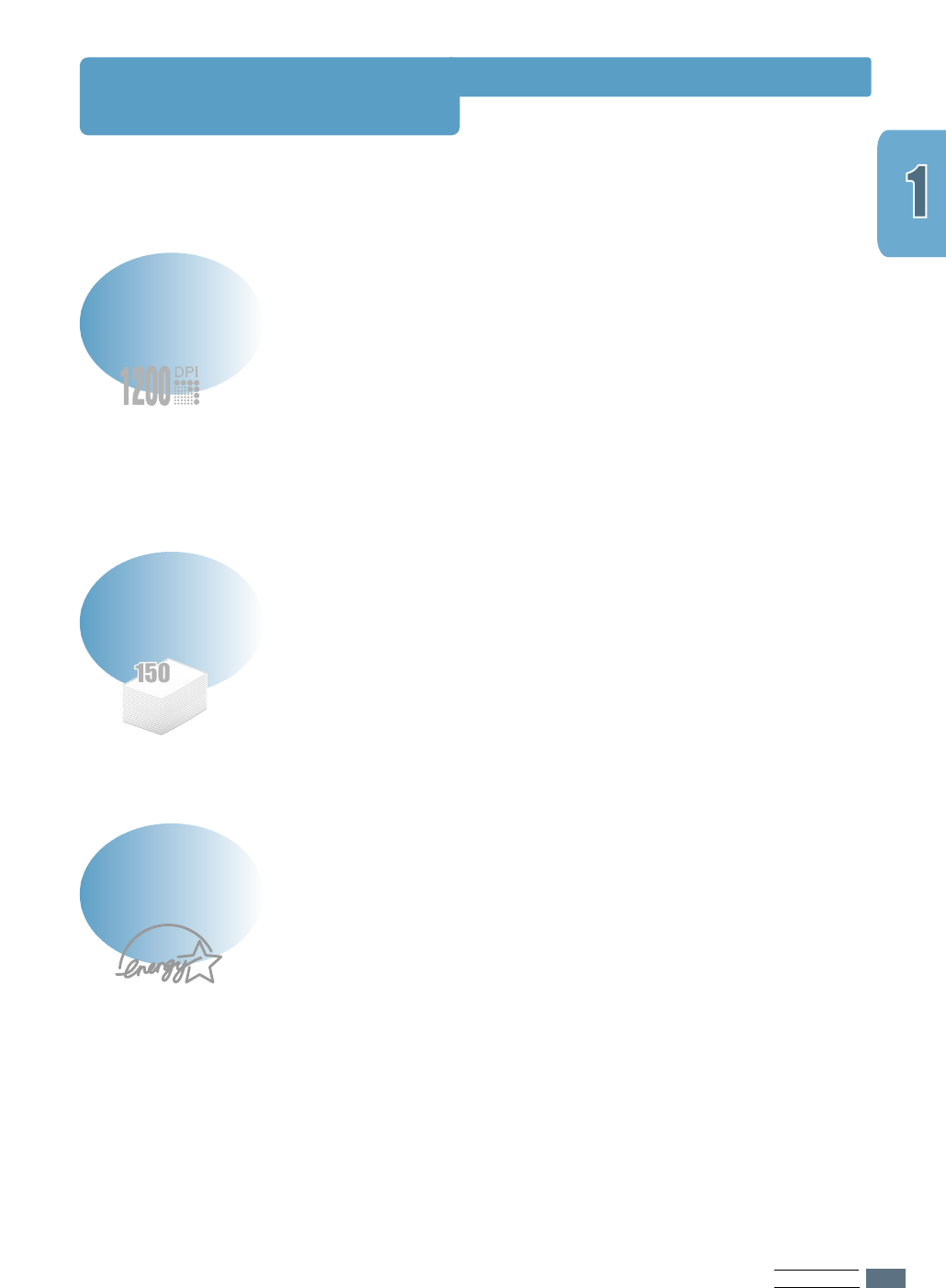
Special Features
INTRODUCTION
1.1
Samsung ML-1250 is a versatile, productive printer equipped
with special features that will improve print quality, giving you
a competitive edge. You can:
• You can print at 1200 dpi class. See page 5.12.
• Your printer prints 12 pages-per-minute.
• The PCL 6 printer language enables fast printing
performance.
Print with excellent quality and high speed
• Standard 150-sheet automatic feeder and a 1-sheet
manual feeder supports various sizes and types of paper.
• Two output locations: Select either the face-down output
tray or the face-up output slot for the most convenient
access.
Flexible paper handling
• If you select Toner Save mode, your printer will use less
toner. See page 5.6.
• Print multiple pages on a single sheet of paper to save paper
(N-up printing). See page 5.7.
• One-touch last page printing is available in the Ready
mode. See page 5.21.
• The printer conserves electricity by automatically reducing
power consumption when it is not active.
• This product meets Energy Star guidelines for energy
efficiency.
Save your time and money
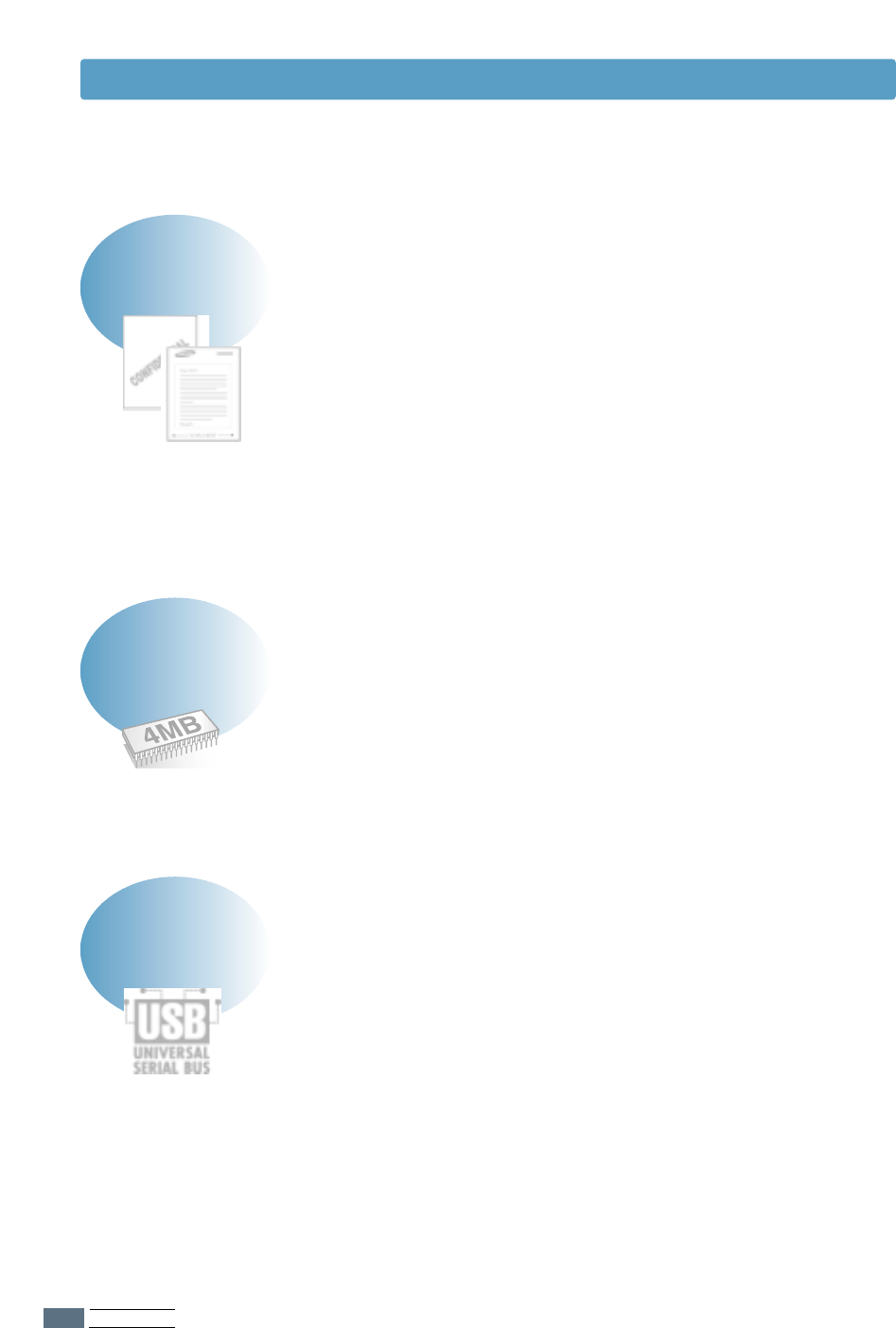
INTRODUCTION
1.2
• You can customize your documents by using Watermarks
such as “Confidential.” See page 5.14.
• Preprinted forms and letterheads can be printed on plain
paper. See page 5.17.
• Print Posters. The text and pictures of each page of your
document are magnified and printed across the selected
sheet of paper. After the document has printed, trim off the
white edges of each sheet. Tape the sheets together to form
a poster. See page 5.9.
Create professional documents
• You can print in Windows 95/98/NT4.0/2000.
• Your printer is compatible with Linux, DOS, and Macintosh.
• The ML-1250 printer comes with both Parallel and USB
interfaces.
Print in various environments
The ML-1250 is shipped with 4 MB of memory included. You
can expand the memory capacity of your printer (up to 68 MB
maximum) by installing optional memory modules. See page
A.30.
Expand the printer capacity
Special Features
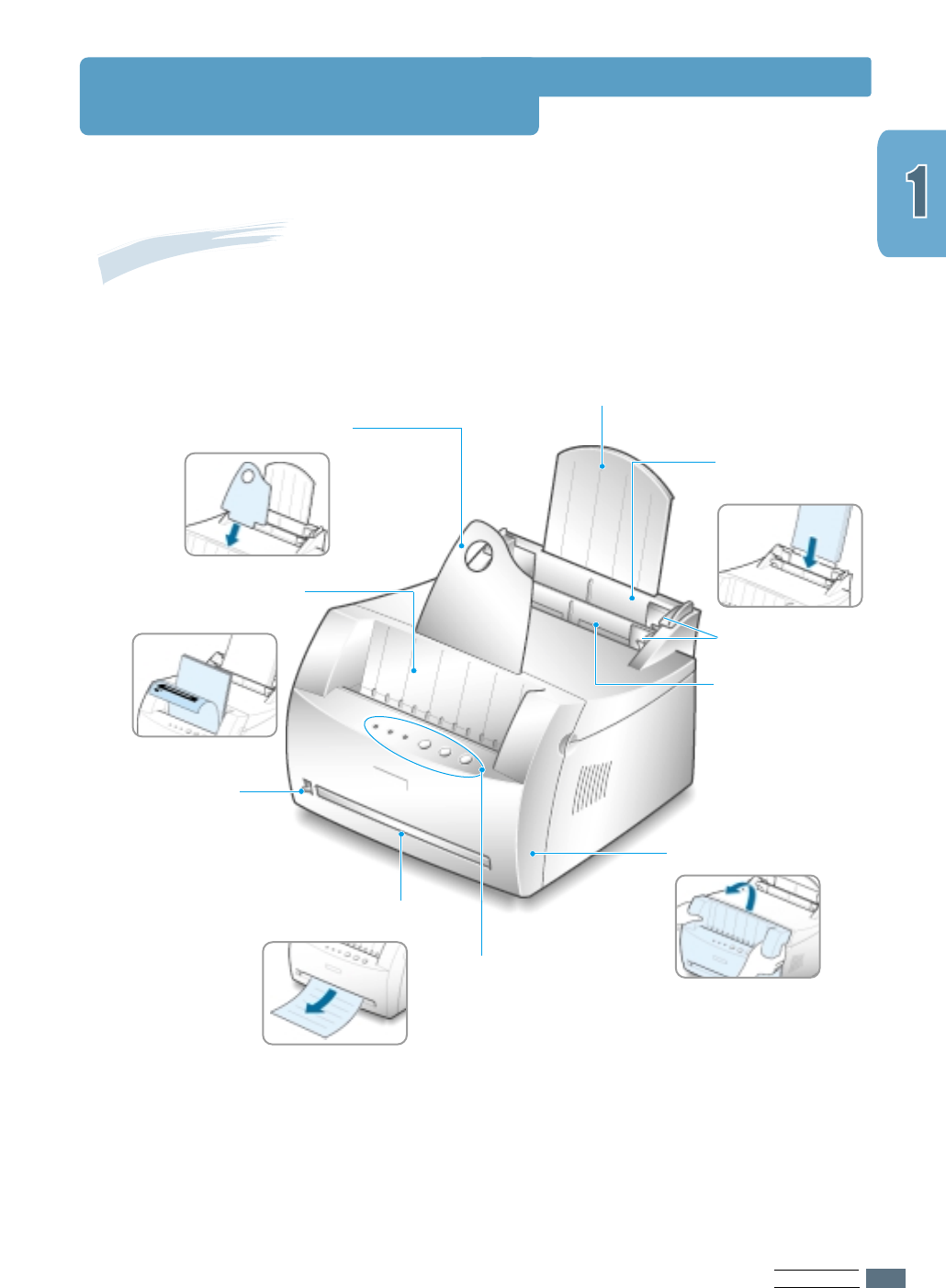
INTRODUCTION
1.3
Printer Components
Front View
Paper support
Face-down output
tray
Output lever
Paper output support
Front cover
Face-up output slot
Control panel
Automatic input
tray
Manual input
tray
Paper guides
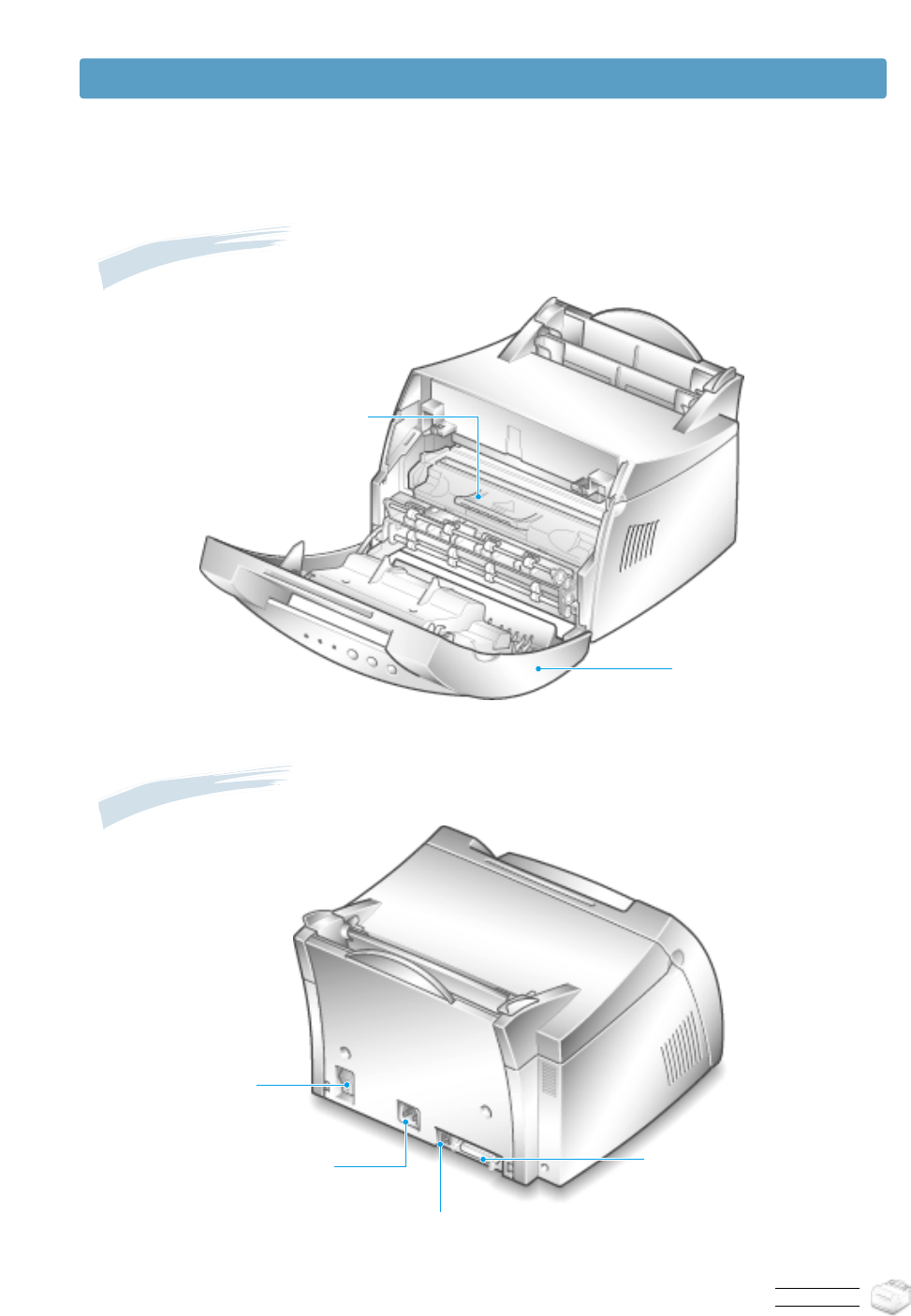
INTRODUCTION
1.4
Inside View
Rear View
Power switch
Power receptacle Parallel port
USB port
Toner cartridge
Printer Components
Front cover
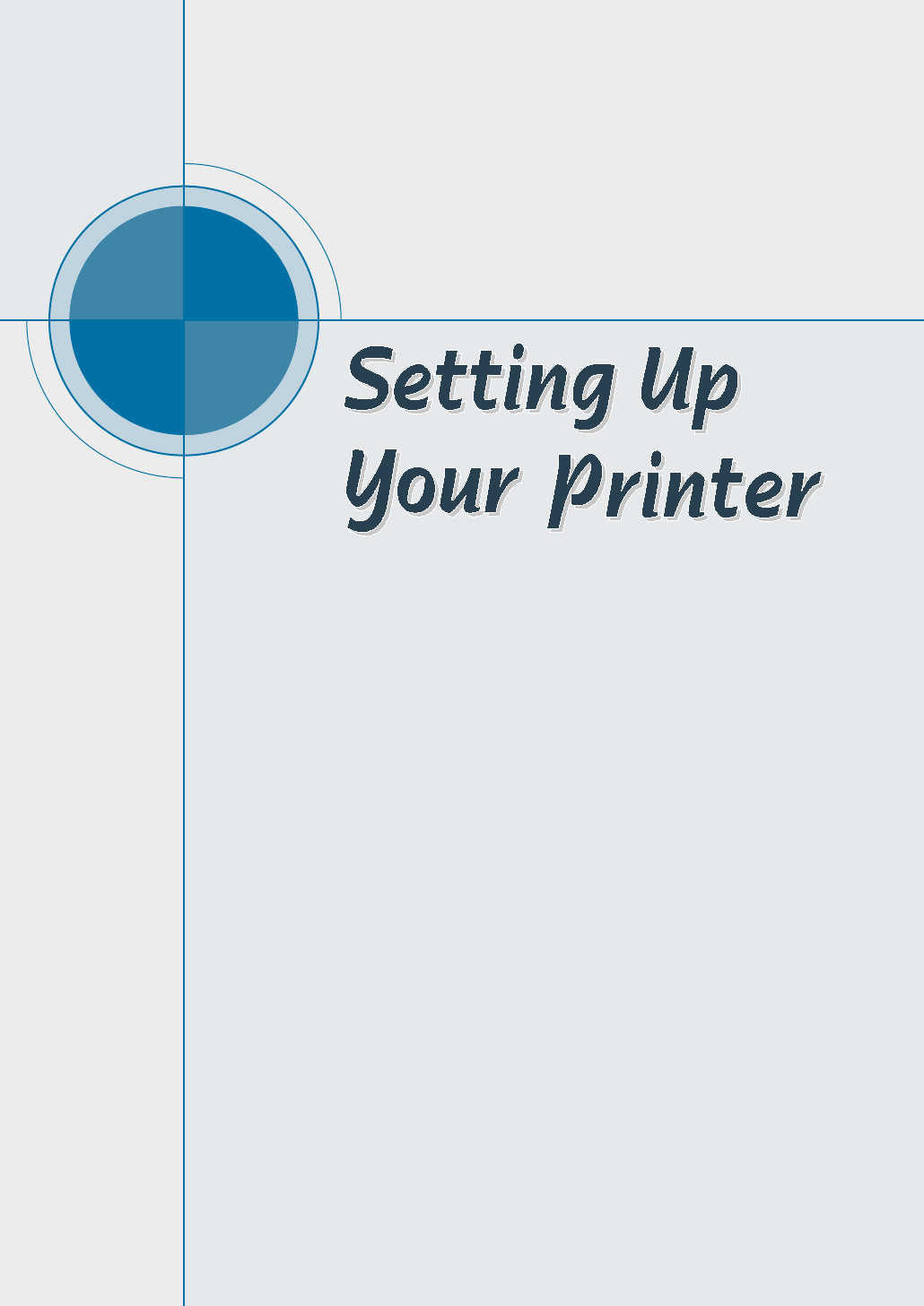
chapter
This chapter provides step by step information on setting up
your printer. Topics included in this chapter are:
◆STEP 1:Unpack Your Printer
◆STEP 2:Install the Toner Cartridge
◆STEP 3:Load Paper
◆STEP 4:Connect to the Computer with a Parallel Cable
◆STEP 5:Turn on the Printer
◆STEP 6:Print a Demo Page!
◆STEP 7:Install the Printer Software
◆Installing Software from Diskette
2
2
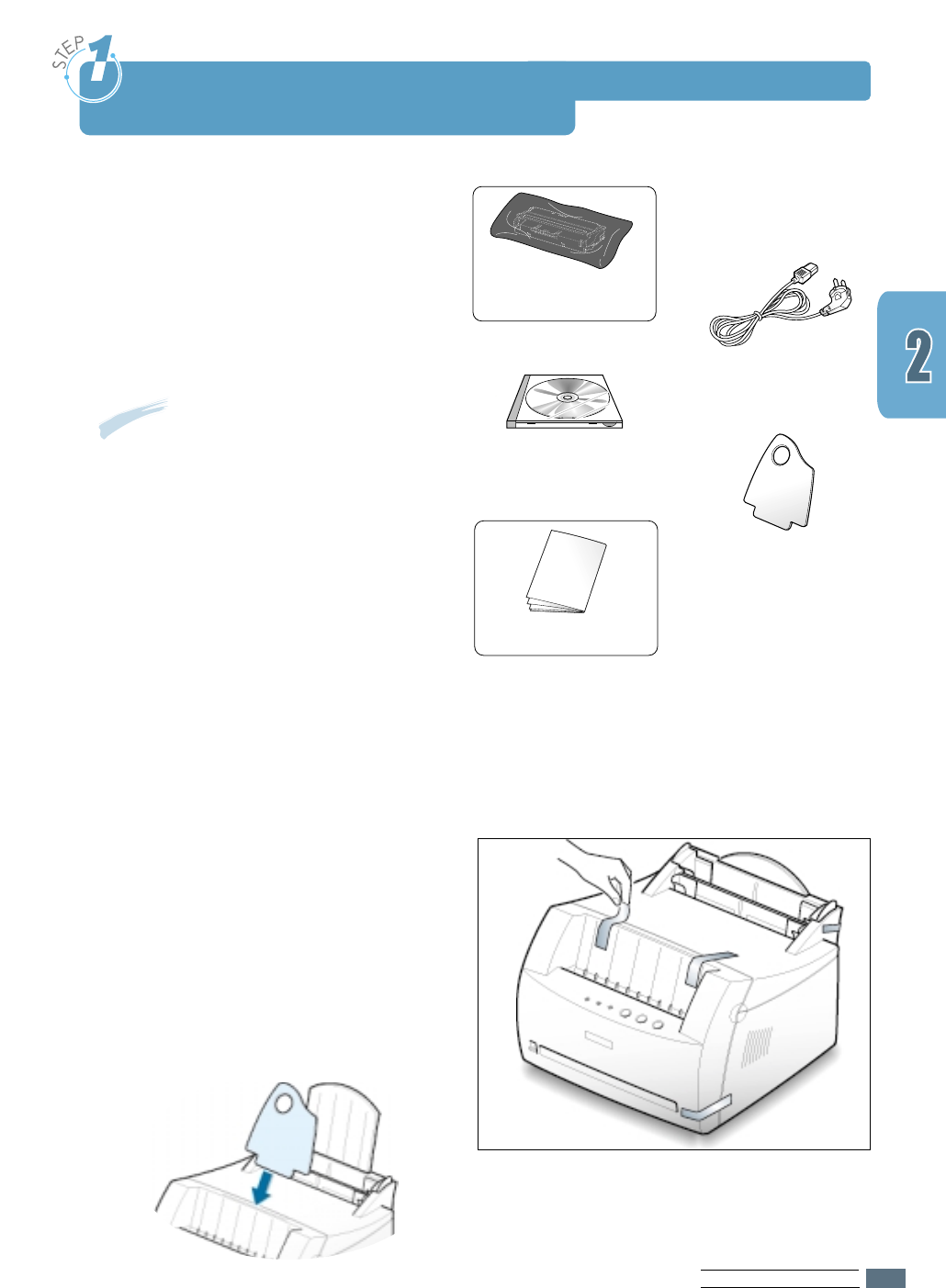
SETTING UPYOUR PRINTER
2.1
Unpack Your Printer
1
Remove the printer and all accessories
from the packing carton. Make sure
that your printer has been packed with
the following items:
Notes:
• If any items are missing or damaged,
notify your dealer immediately.
• Components may differ from one
country to another.
Toner cartridge
Power cord
CD-ROM*
* contains the printer driver, the User’s Guide, the Adobe
Acrobat Reader program, and the Make Your Own Diskette
setup software.
2
Carefully remove all packing tapes from
the printer.
3
Attach the supplied paper output
support as shown.
Setup Guide
Paper Output Support
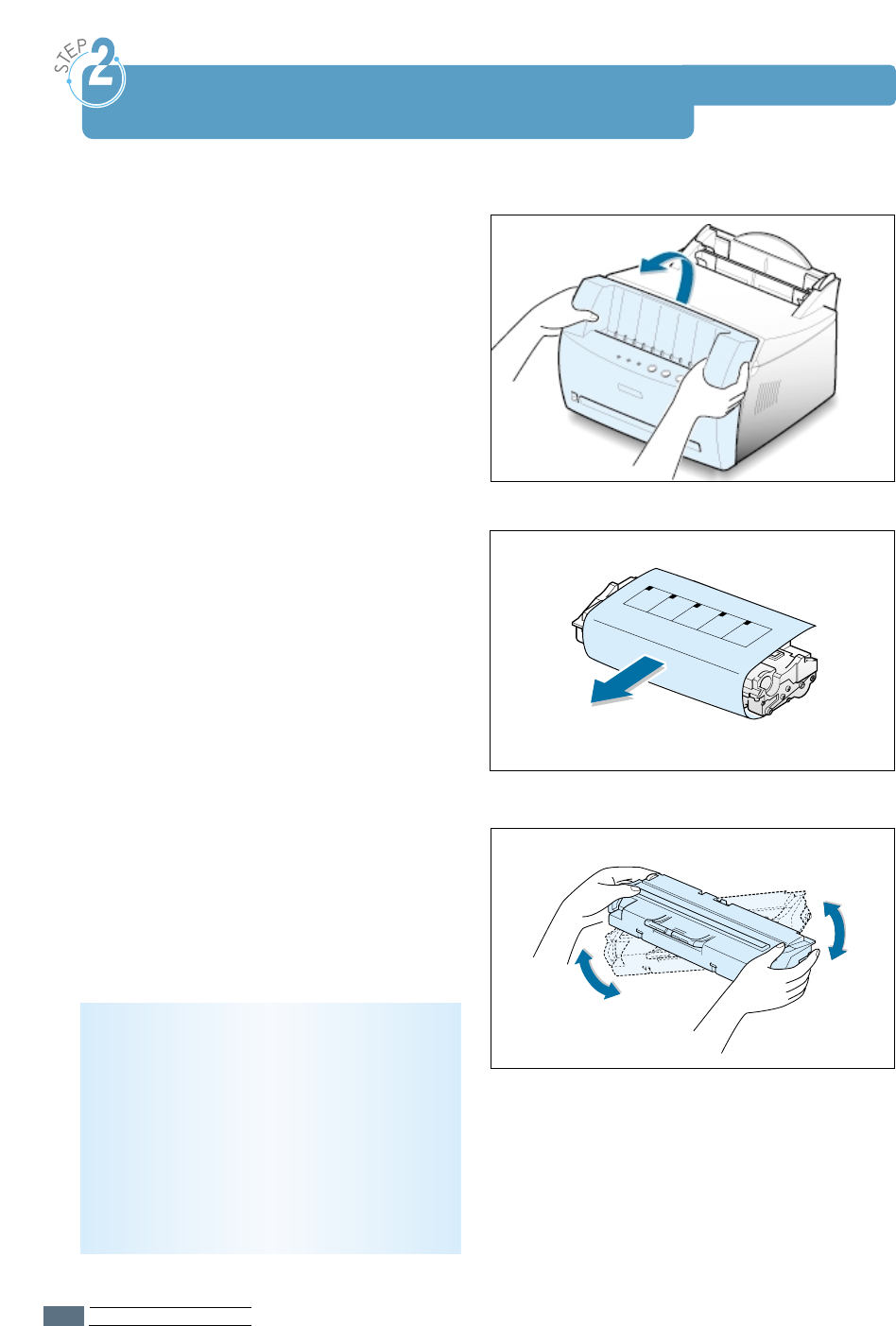
SETTING UPYOUR PRINTER
2.2
1
Grasp both sides of the front cover and
open it by pulling it towards you.
2
Remove the toner cartridge from its bag
and then remove the paper covering it.
Discard the paper.
3
Gently shake the cartridge from side to
side to evenly distribute the toner inside
the cartridge.
CAUTION:
To prevent damage, do not expose the
toner cartridge to light for more than a few
minutes. Cover it with a piece of paper, if
left exposed for more than a few minutes.
If toner gets on your clothing, wipe it off
with a dry cloth and wash clothing in cold
water. Hot water sets toner into fabric.
Install the Toner Cartridge
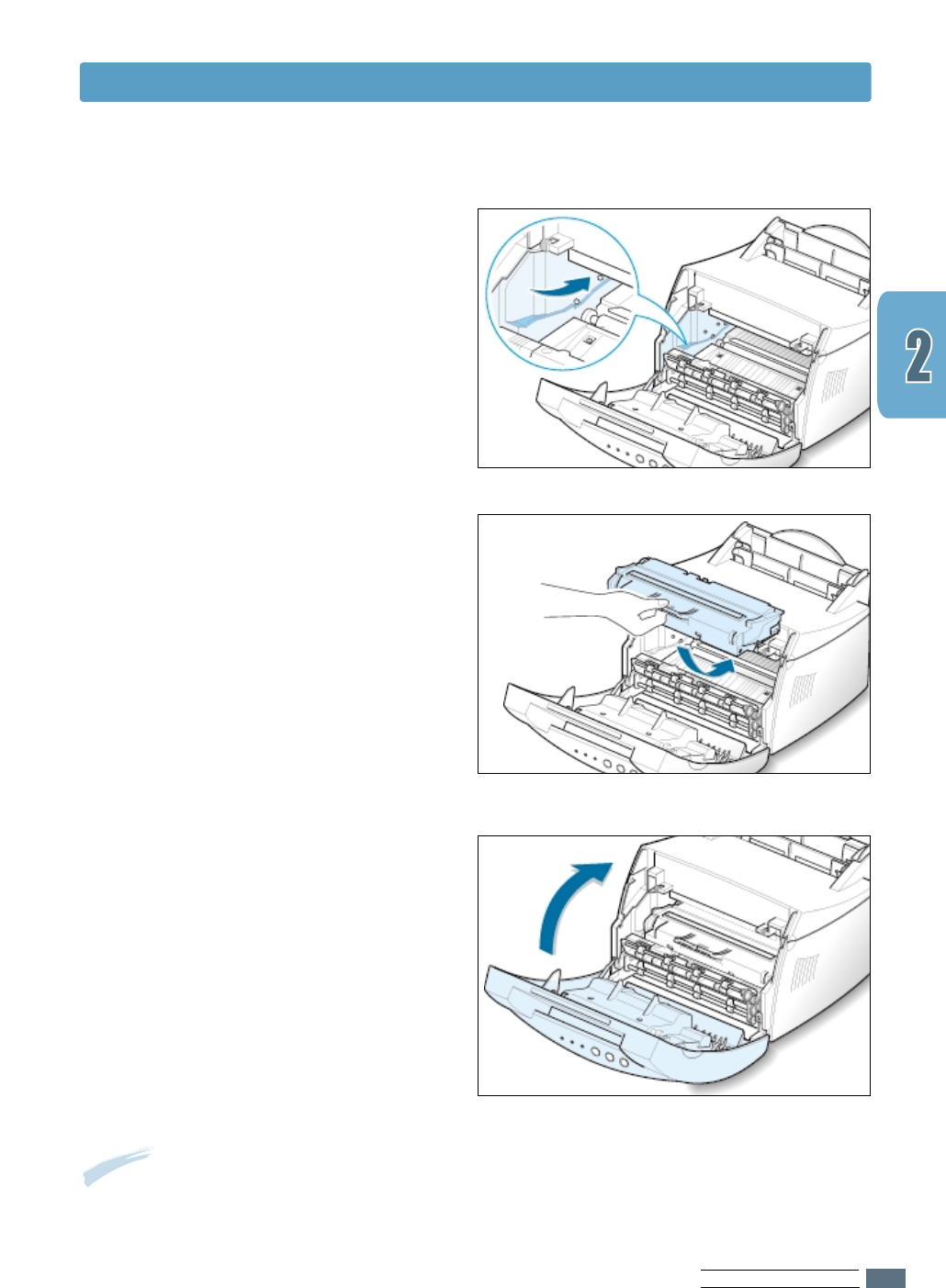
SETTING UPYOUR PRINTER
2.3
Note: When printing text at 5% coverage, you can expect a toner cartridge life of approximately
2,500 pages (1,000 pages for the toner cartridge that is shipped with the printer).
5
Grasp the handle and insert the
cartridge in the printer until it snaps
into place.
6
Close the front cover. Make sure that
the cover is securely closed.
4
Locate the cartridge slots inside the
printer, one on each side.
Install the Toner Cartridge
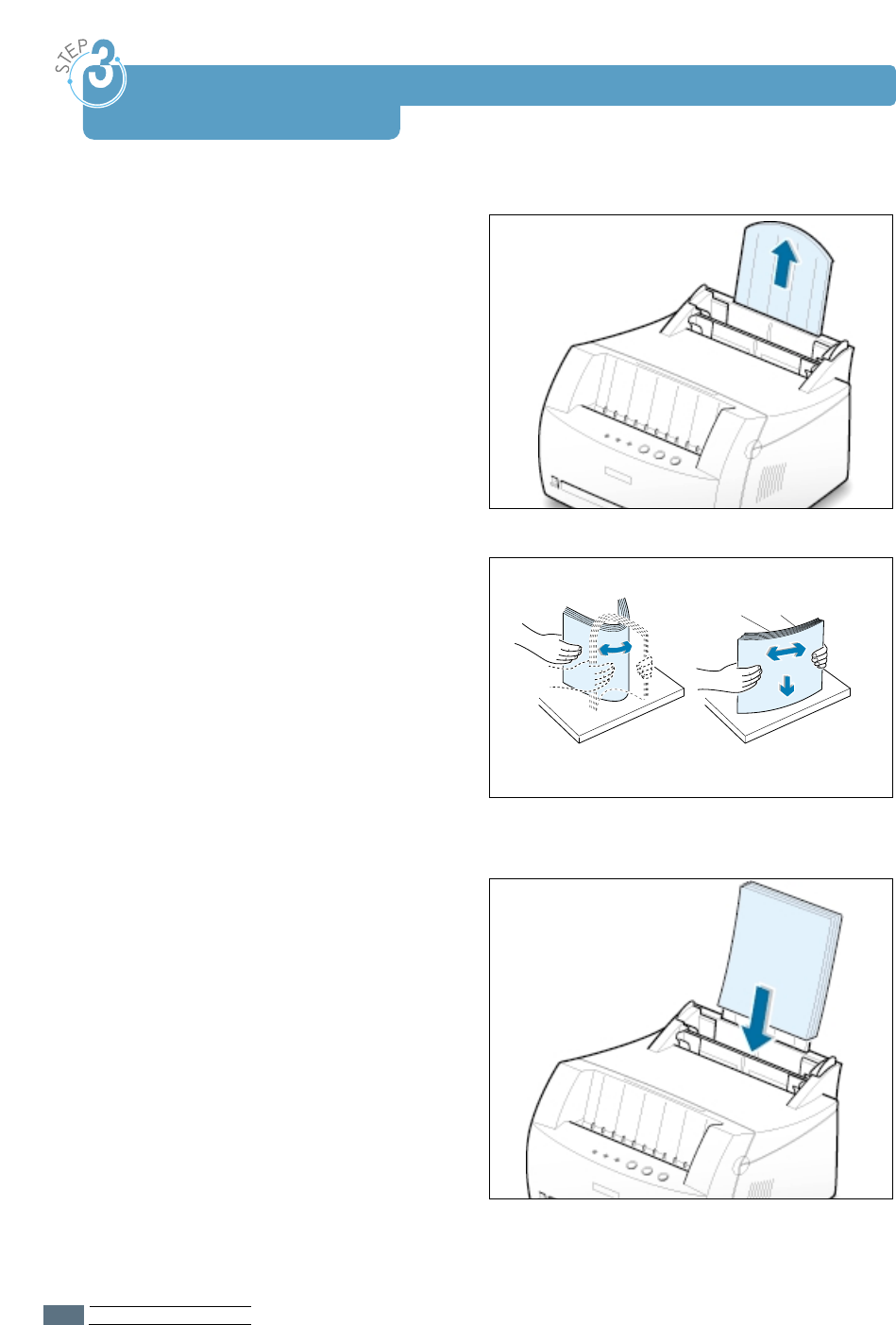
SETTING UPYOUR PRINTER
2.4
1
Pull the paper support on the automatic
input tray up, until it stops.
2
Before loading the paper, flex the sheets
back and forth to loosen them, and then
fan them.
Tap the edges of the stack on a table top
to straighten them and prevent paper
jams.
3
Load a stack of paper into the automatic
input tray with the print side facing
up.
Load Paper
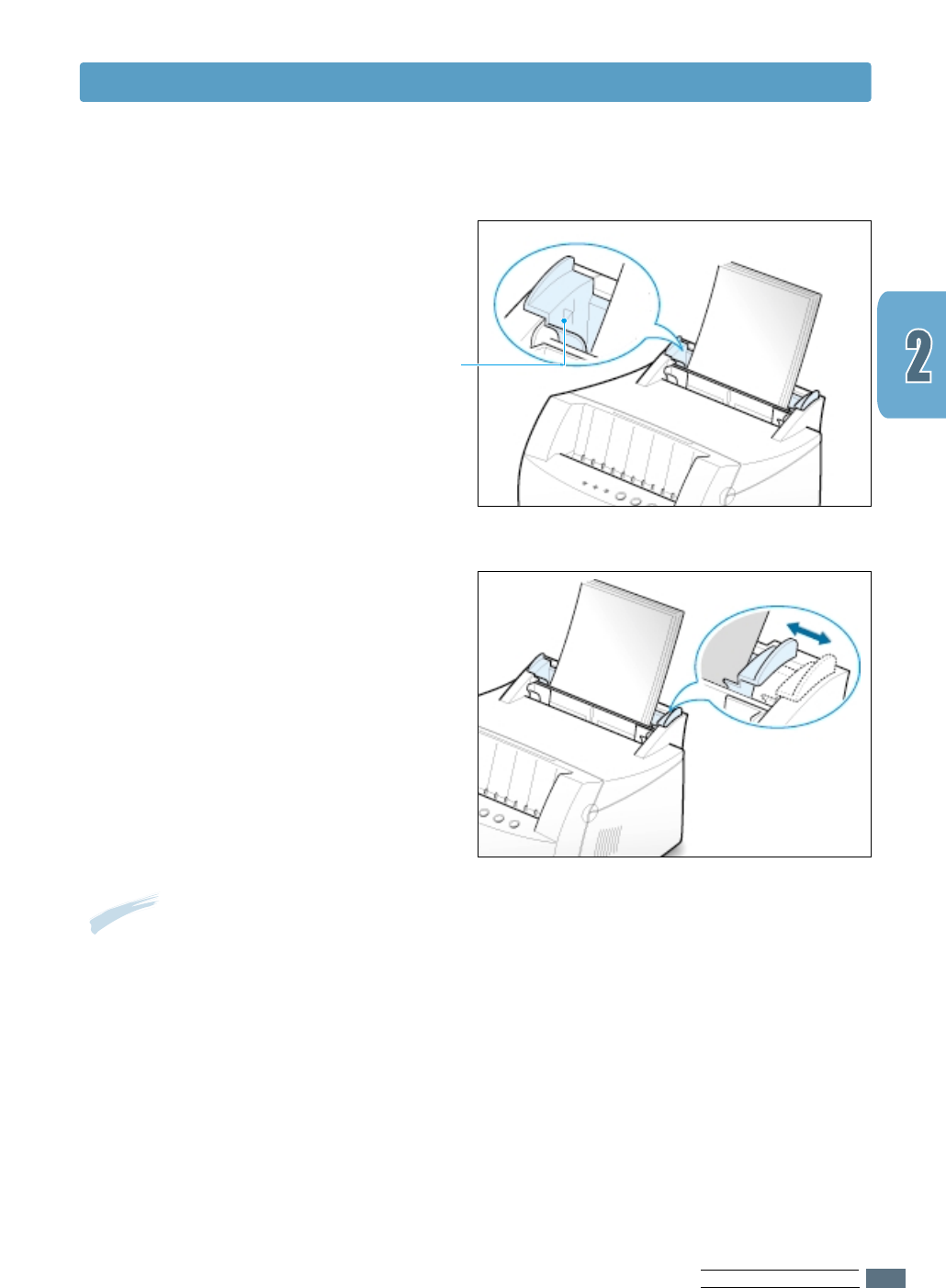
SETTING UPYOUR PRINTER
2.5
5
Adjust the paper guides to the width of
the paper stack.
4
Do not load too much. This tray
holds up to 150 sheets.
Keep the paper below this height
mark.
Load Paper
Notes:
• Do not push the width guide far enough to cause the media to warp.
• If you do not adjust the width guide, it may cause paper jam.
• If you are needed to add more sheets of paper while printing, remove the
remaining paper from the tray at first. Then, reinsert them with the new
paper. Note that adding new paper into the remains in the tray may cause
paper jams or multiple feeding.
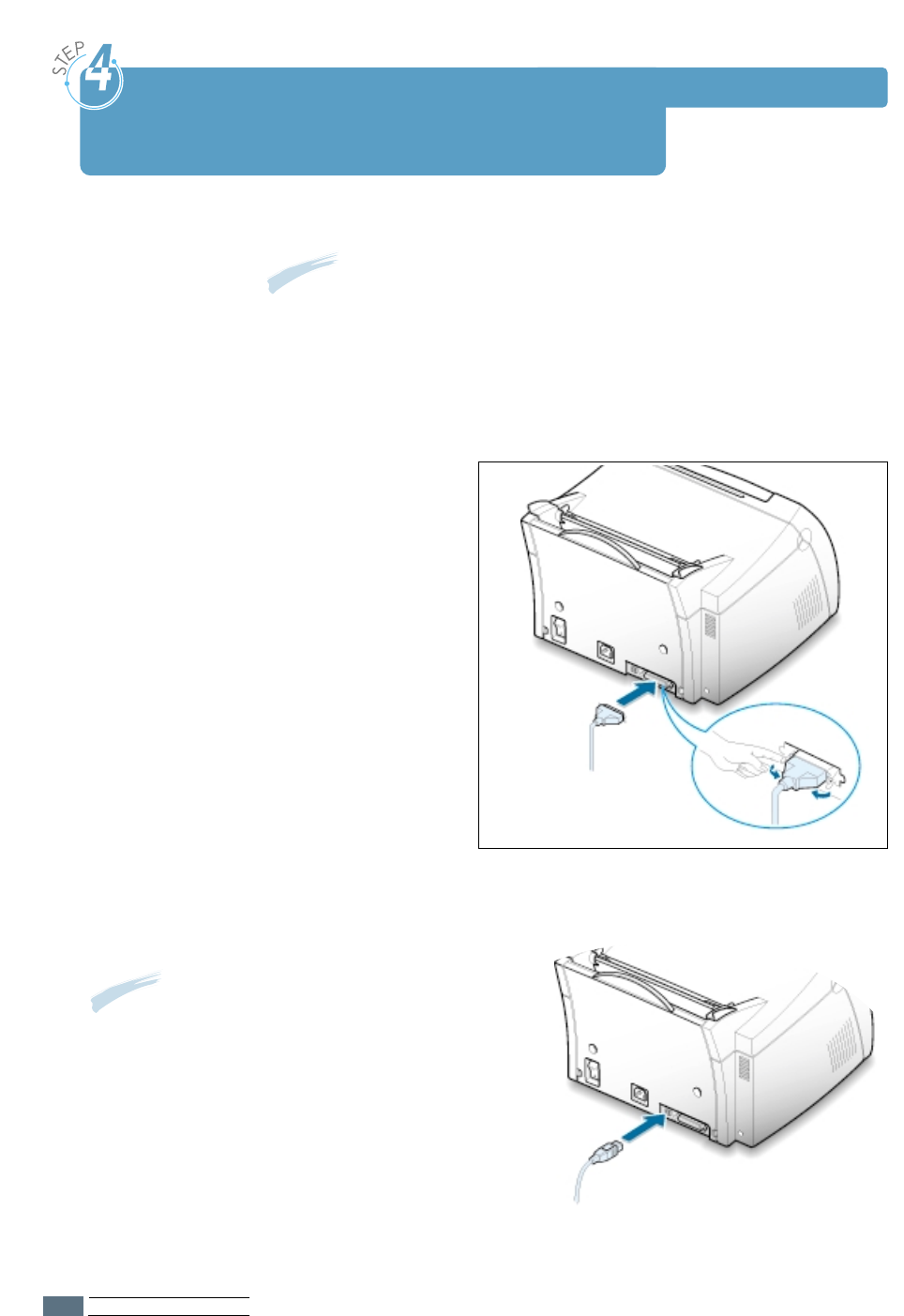
SETTING UPYOUR PRINTER
2.6
1
Make sure that both the printer and the computer are turned off.
2
Plug the parallel printer cable into the
connector on the back of the printer.
Push the metal clips down to fit
inside the notches on the cable plug.
3
Connect the other end of the cable to
the parallel interface port on your
computer, and tighten the screws.
See your computer documentation if
you need help.
Connect to the Computer
with a Parallel Cable
To the parallel
port on PC
➜
If you are using a USB interface
Go to “Using Your Printer with a USB Cable” on
page A.10.
Note: To connect the printer to the parallel port of the computer
requires a certified parallel cable.
You will need to buy the IEEE1284 compliant cable.
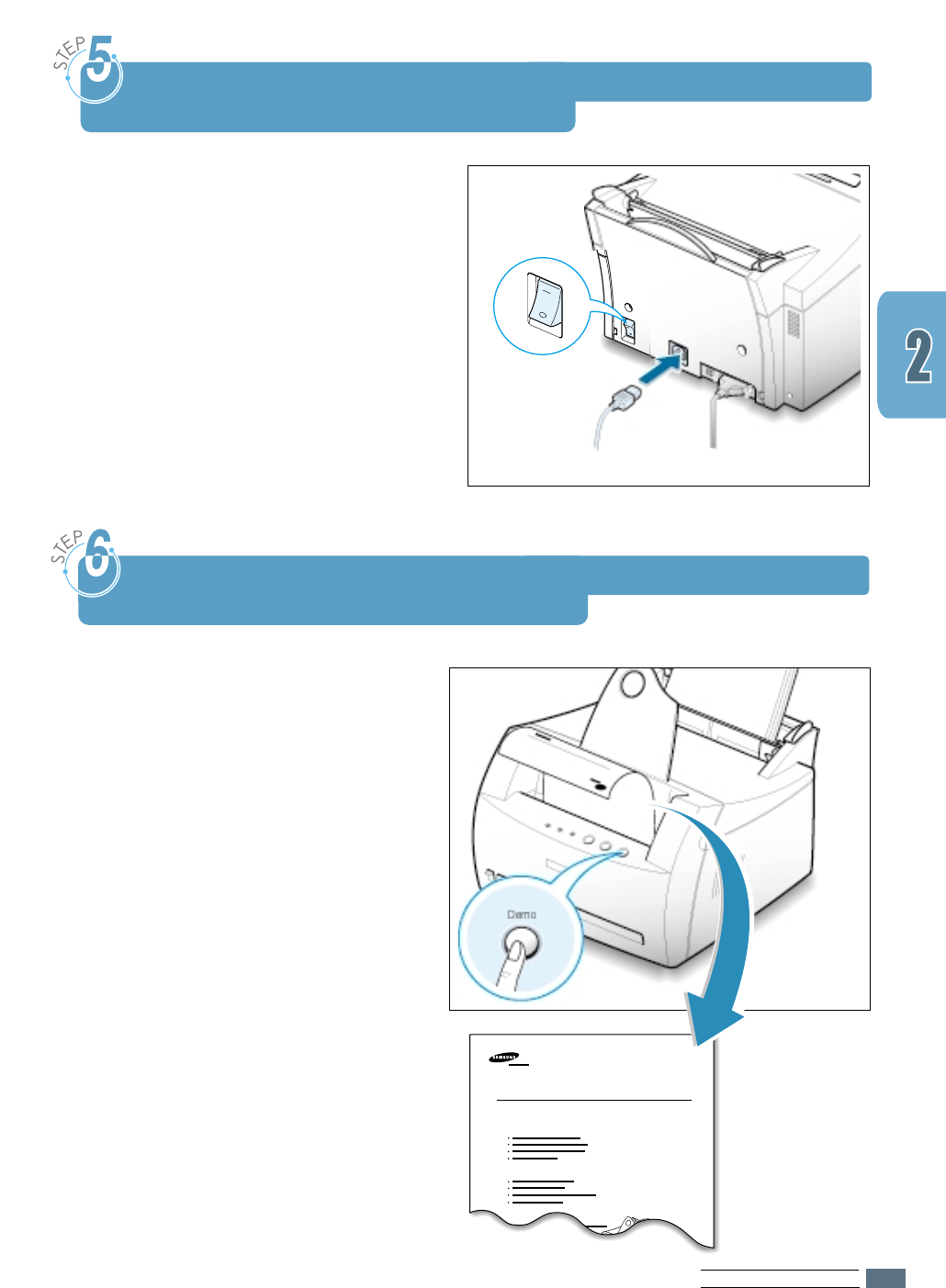
SETTING UPYOUR PRINTER
2.7
1
Plug the power cord into the power
receptacle on the back of the printer.
2
Plug the other end into a properly
grounded AC outlet.
3
Turn on the power.
Turn on the Printer
To AC outlet
➜
As the printer powers up, all the printer
control panel lights turn on briefly. When
only the Data light remains on, press and
hold the Demo button.
Hold down the button for about 2 seconds
until all lights blink slowly. Then release
the button and the demo page will print.
Laser Beam Printer
Excellent Performance, High Quality
Cost Saving, Convenience
Compatibility
ML-1250
The demo page provides a sample of
print quality to help you verify that the
printer is printing correctly.
Print a Demo Page!
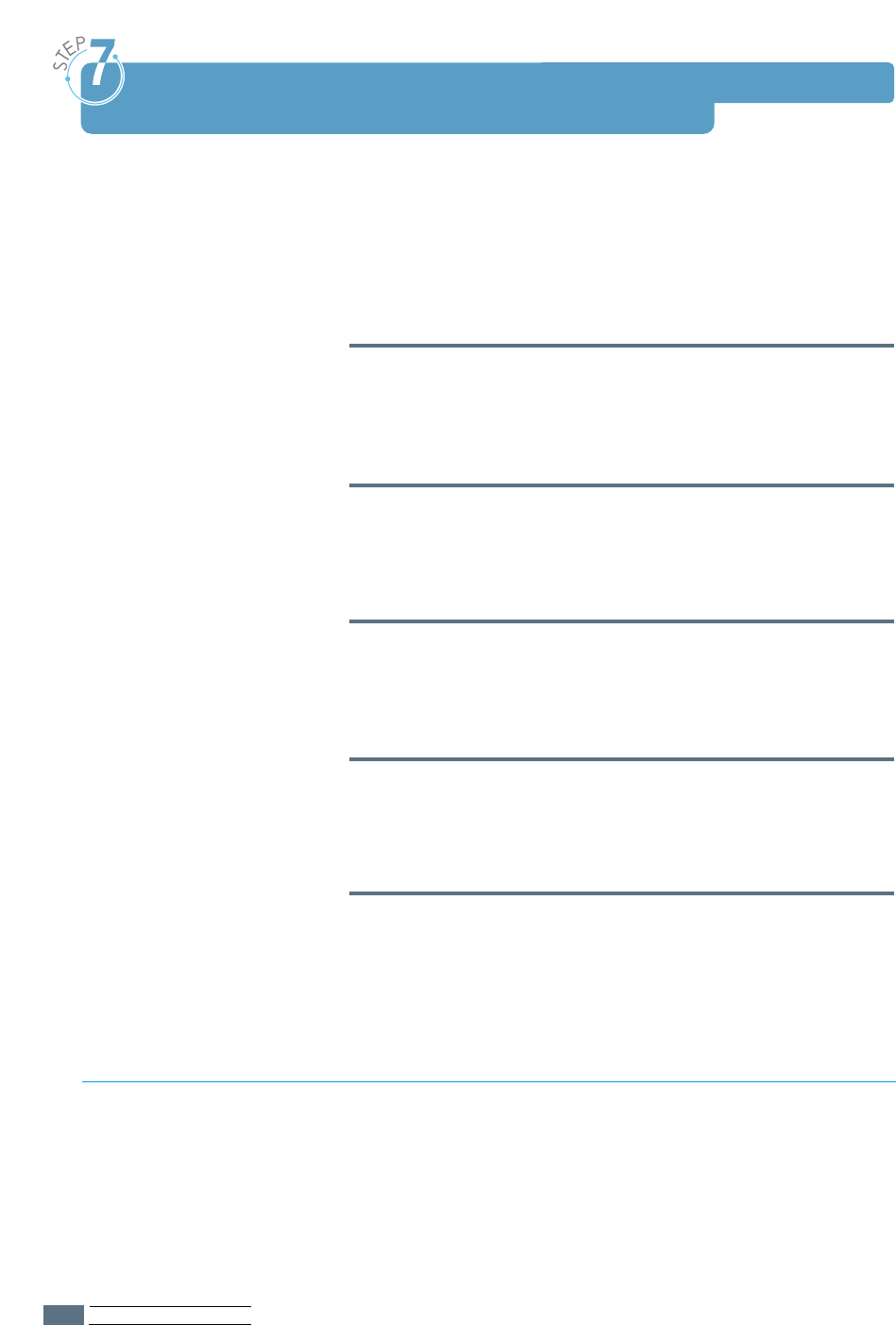
SETTING UPYOUR PRINTER
2.8
Included with your printer is a CD-ROM containing the printer
driver for some of the most popular Windows software
applications. To operate your printer, you must install a printer
driver, which translates data from your application into data
that the printer understands.
If you are printing with a parallel interface
Go to page 2.9 for information on installing the print software
on a computer that is attached directly to the printer with a
parallel cable.
If you are printing with a USB interface
Go to “Using Your Printer with a USB Cable” on page A.10, for
information on installing the print software on a USB-enabled
computer.
If you are printing from Macintosh
Go to “Using Your Printer with a Macintosh” on page A.16, for
information on installing the print software and printing from
Macintosh.
If you are printing in DOS
Go to “Printing from DOS Application” on page A.23, for
information on installing the DOS RCP utility and printing from
DOS applications.
If you are printing in Linux
Go to “Linux Driver Installation” on page A.28, for information
on installing the Linux driver.
Install the Printer Software
Verify the following:
• At least 16 MB or more of RAM is installed on your PC.
• There is at least 50 MB of free disk space on your PC.
• All applications are closed on your PC before beginning
installation.
• Windows 95, Windows 98, Windows Me, Windows NT 4.0 or
Windows 2000.
Before Installing the Printer Software
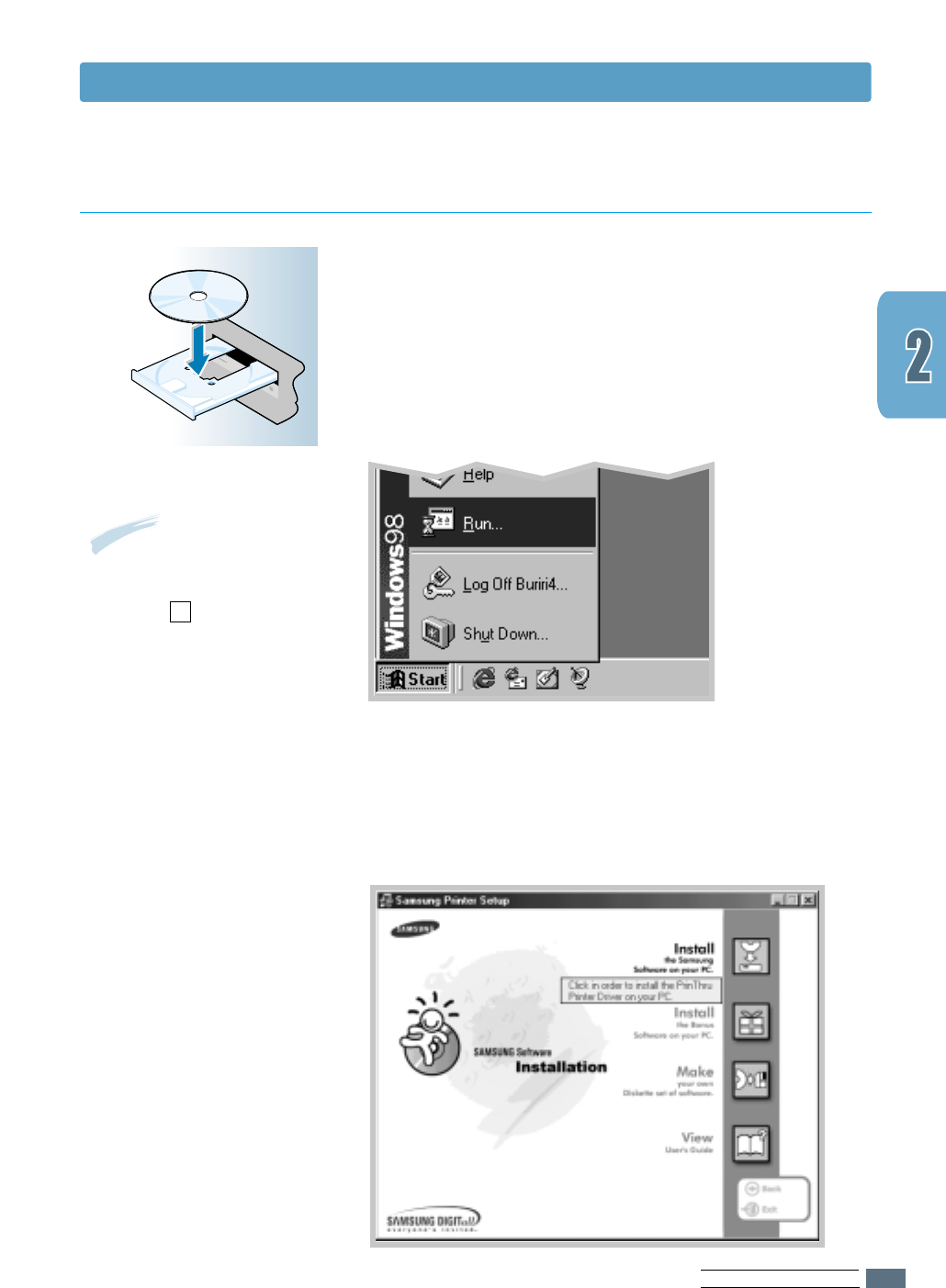
SETTING UPYOUR PRINTER
2.9
1
Place the CD-ROM in the CD-ROM drive. Install will start
automatically.
If the CD-ROM drive does not automatically run:
Select Run from the Start menu, and type x:\cdsetup.exe
in the Open box (where xis the drive letter for the CD-ROM
drive), and then click OK.
Installing the Printer Software from the CD-ROM
Note: If the New Hardware
Found box appears during
the installation procedure,
click the x in the upper
right corner of the box,
or click Cancel.
S
A
M
S
U
N
G
M
L
-
1
2
5
0
2
When the opening screen appears, select the appropriate
language.
3
Click Install the Samsung Software on your PC.
Install the Printer Software
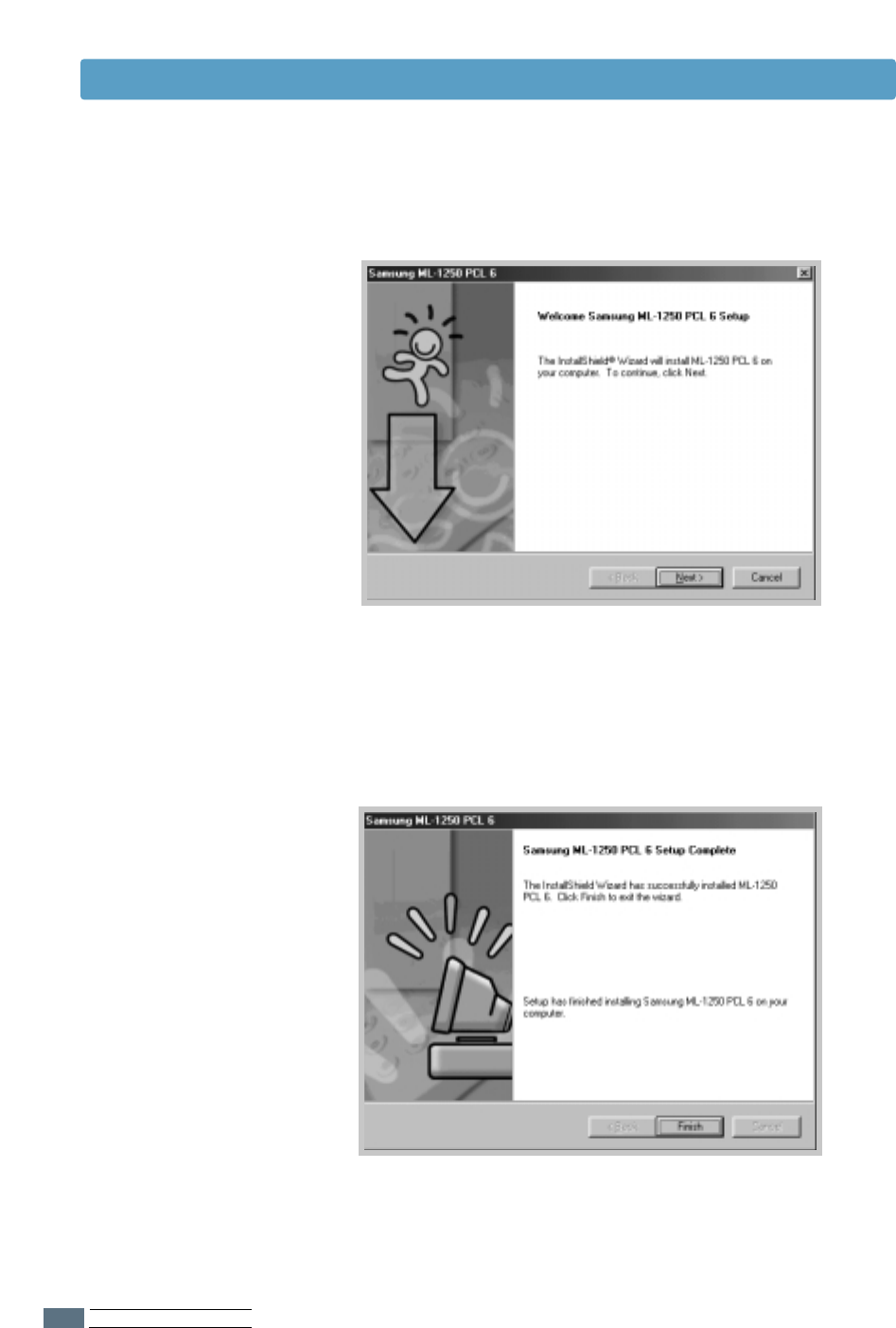
SETTING UPYOUR PRINTER
2.10
Install the Printer Software
4
The Welcome window opens. Click Next.
5
The files are copied into the appropriate directory.
6
Click Finish.
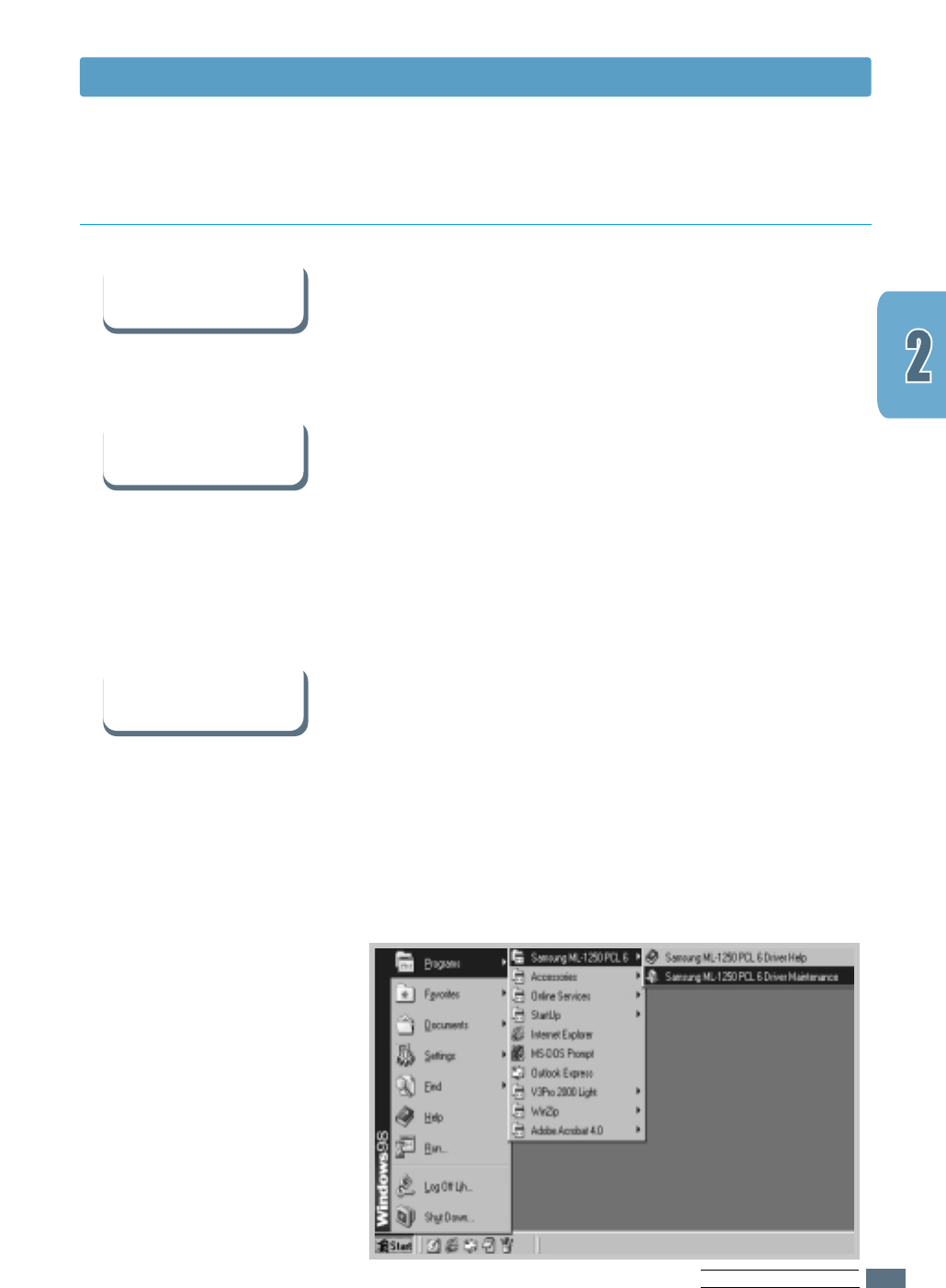
SETTING UPYOUR PRINTER
2.11
Install the Printer Software
If you have access to another computer with a CD-ROM drive,
you can use tne Make Diskette utility in Windows to create the
disks you need for the installation. Go to “Installing Software
from Diskette” on page 2.13.
Some printer features, such as paper size and page
orientation, may be available through your application settings.
Use application settings, if available, because they override
printer driver settings.
Access advanced printer features through your printer driver.
See chapter 5, “Printing Tasks” for instructions on using your
printer driver features.
In Windows, after installation, the Uninstall icon in the
Samsung ML-1250 program group allows you to select and
remove any or all of the Samsung ML-1250 printing system
components. If you are upgrading the printer driver, or if your
installation fails, uninstall the driver following these
instructions.
1
From the Start menu, select Programs.
2
Select Samsung ML-1250 PCL 6, and then Samsung
ML-1250 PCL 6 Driver Maintenance.
Software Installation Tips
I do not have a
CD-ROM drive
How do I access
printer features ?
How do I remove the
printing software ?
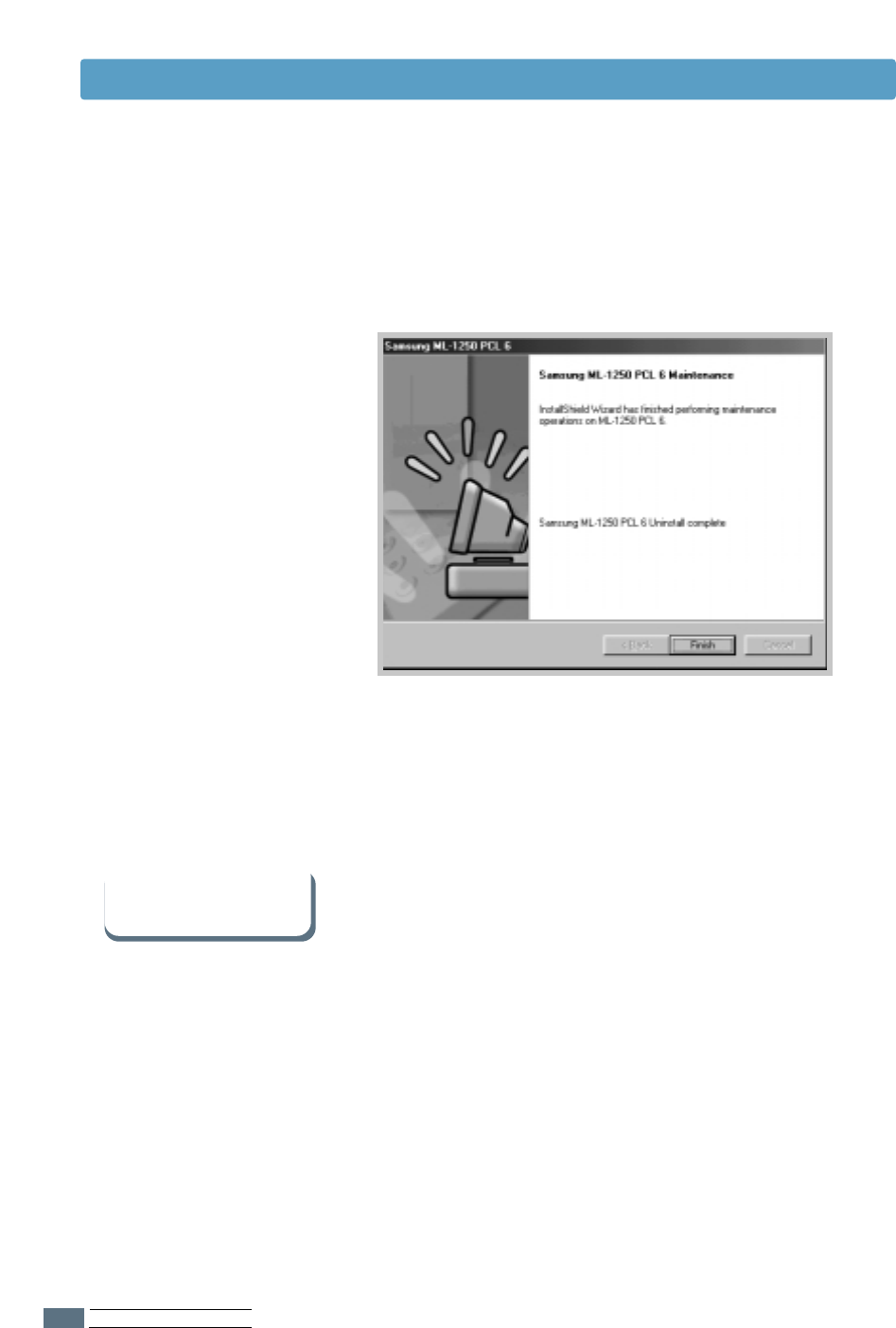
SETTING UPYOUR PRINTER
2.12
Install the Printer Software
• Exit your software programs. Then turn off the computer and
the printer. Turn on the printer, and then turn on the
computer.
• Close any virus protection programs that are running on your
computer.
• Uninstall the printer software using the instructions above,
and then repeat the installation procedure.
If you have
problems installing
5
Click Finish.
3
When your computer confirms your selection, click OK.
4
The Samsung ML-1250 printer driver and all of its
components are removed from your computer.
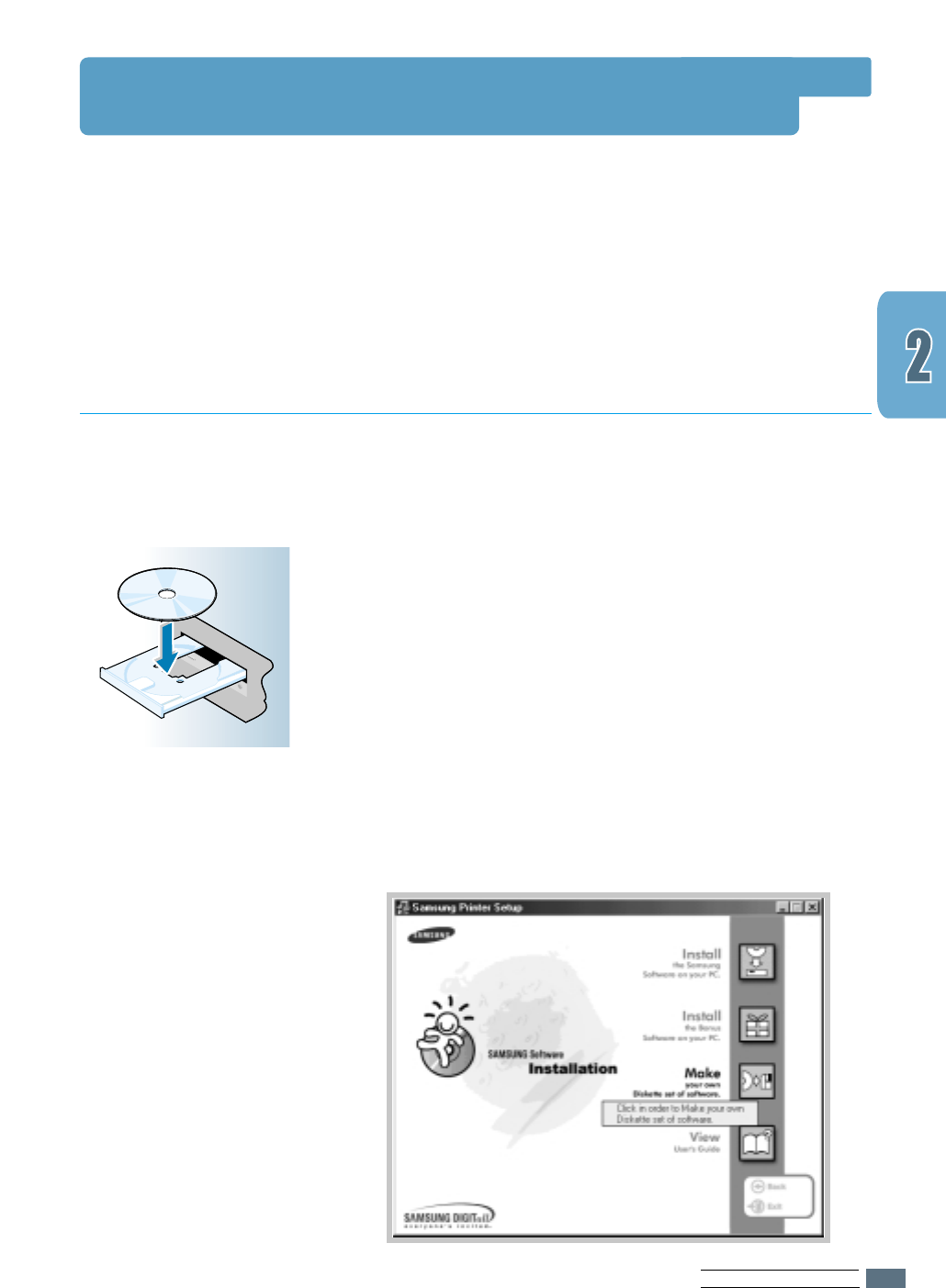
SETTING UPYOUR PRINTER
2.13
If you do not have a CD-ROM drive and if you have access
to another computer with a CD-ROM drive, you can copy
software installation files from your printer software
CD-ROM onto floppy diskettes, and then use the diskettes
instead of the CD-ROM to install the software.
You can make installation diskettes for the Samsung
ML-1250 PCL 6 printer driver. Make sure that you have
several formatted diskettes ready, and then follow these
steps:
1
Insert the CD-ROM shipped with your printer into the
CD-ROM drive. Installation will start automatically.
If the CD-ROM drive does not automatically run:
Select Run from the Start menu, and type
x:\cdsetup.exe in the Open box (where xis the drive
letter for the CD-ROM drive), and then click OK.
2
When the opening screen appears, select the appropriate
language.
3
Click Make your own Diskette set of software.
Making Installation Diskettes
S
A
M
S
U
N
G
M
L
-
1
2
5
0
Installing Software from Diskette
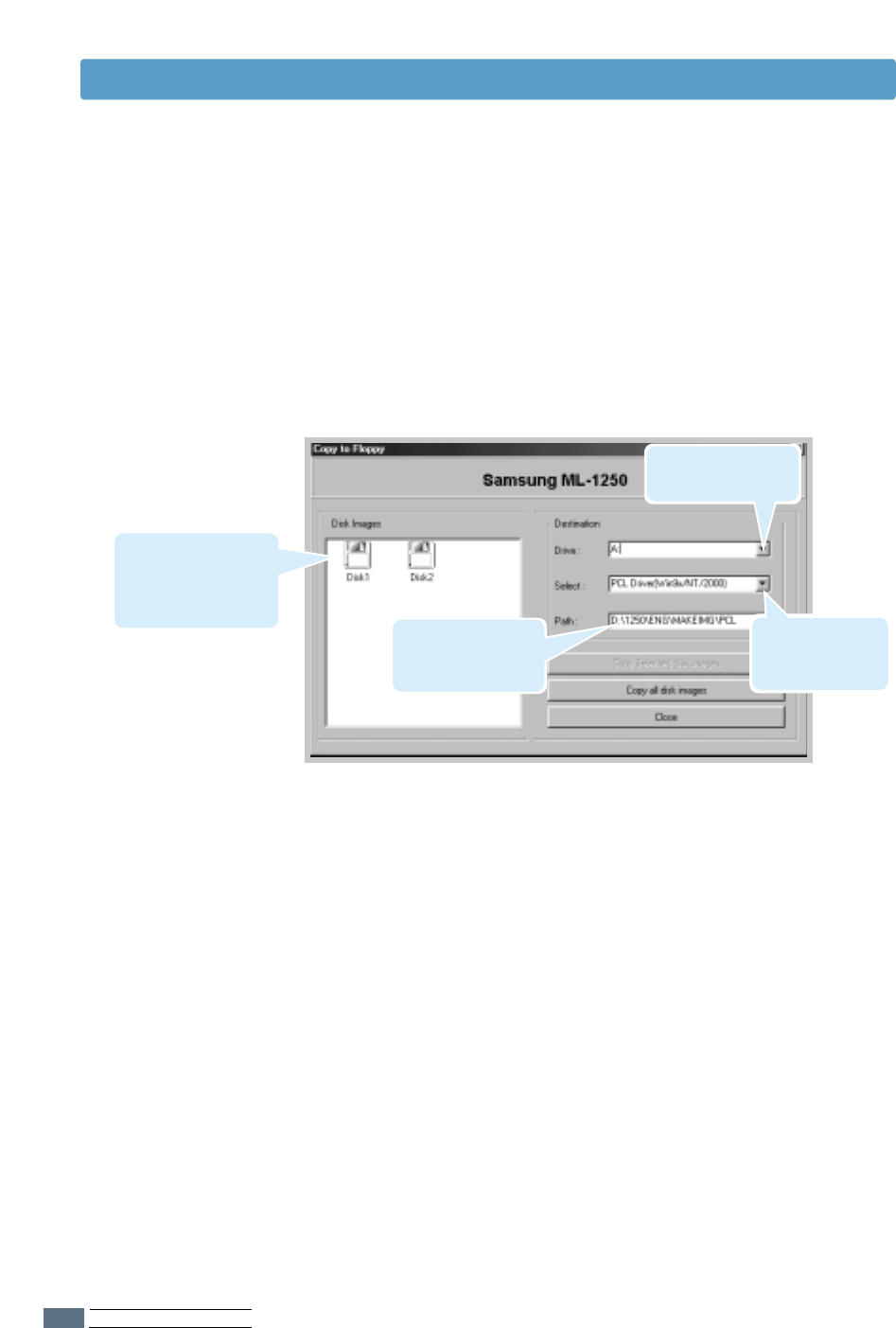
SETTING UPYOUR PRINTER
2.14
4
The Copy to Floppy dialog box appears.
Select the desired components you want to copy to the
diskette from the Select box. You can select PCL 6 Driver,
USB Driver and DOS RCP.
Select the floppy disk drive that you will be inserting the
diskette into.
5
Click Copy all disk images.
If you want to copy a portion of the selected component,
select the disk you want to copy in the Disk Images
window, and then click Copy selected disk images.
6
When prompted, insert a blank, formatted diskette into
the floppy drive, and click Yes to copy the first diskette.
For multiple diskettes, when the first diskette is finished,
you are prompted to insert disk 2.
Make sure you label each diskette in order as you create
it: ML-1250 PCL 6 driver, disk 1 of 2, etc.
Shows the path of
the selected
component.
Select the
component you
want to copy.
Shows the number
of disks required to
copy the selected
component.
Select the floppy
drive you will use.
Installing Software from Diskette
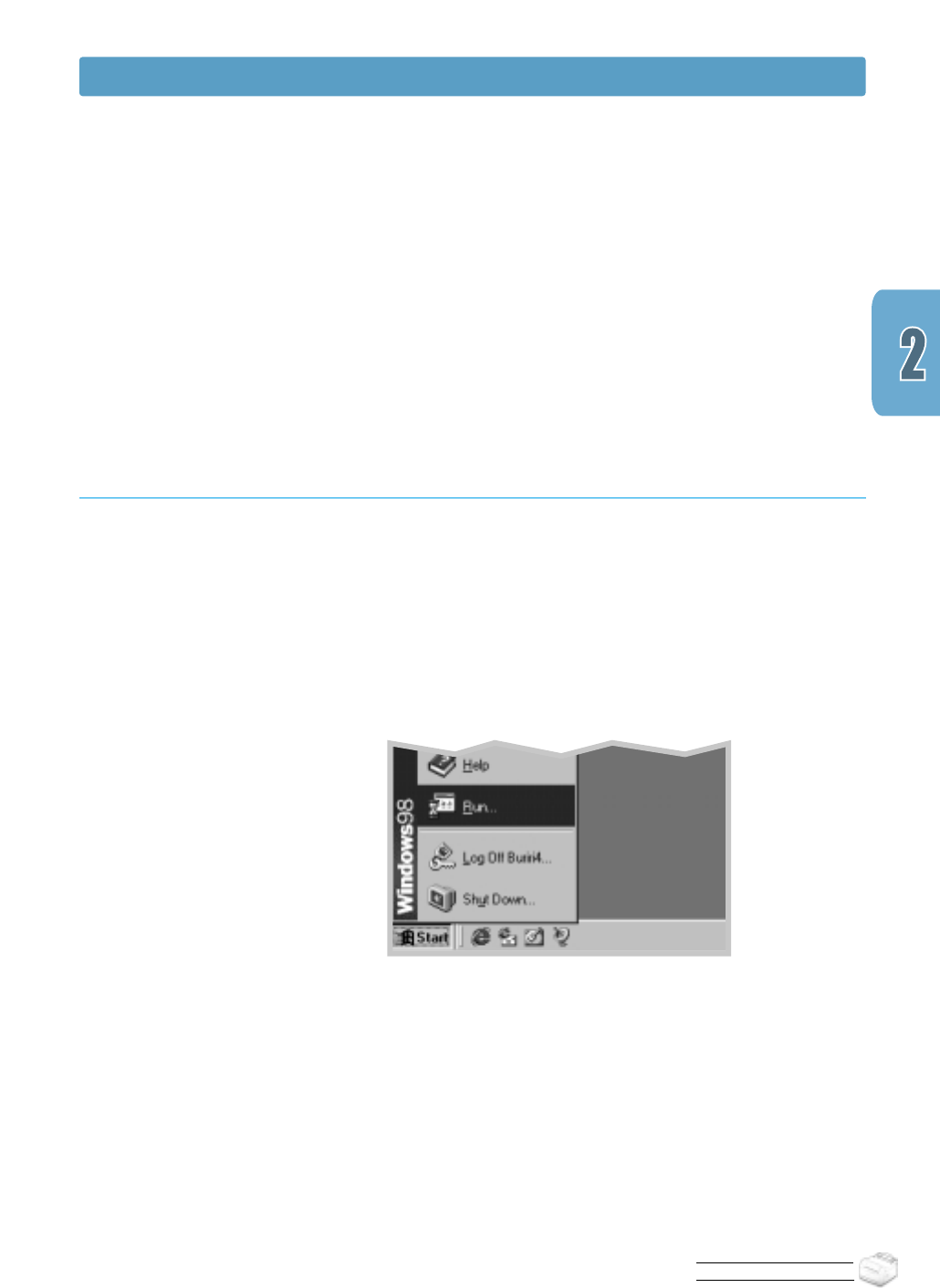
SETTING UPYOUR PRINTER
Installing Software from Diskette
7
If you have more than one disk, insert the next disk and
click Yes.
8
When copying to diskettes has been completed, click
Close in the Copy to Floppy dialog box. Then click Exit in
the SAMSUNG PRINTER SETUP dialog box.
To install the printer driver from the diskettes, follow this
procedure:
1
Insert the first diskette (if you have more than one
software diskette).
2
From the Start menu, select Run.
3
Type A:\setup.exe in the Open box and click OK. (if
your floppy drive is not A, substitute the correct letter.)
4
Follow the on-screen instructions to complete the
installation.
Installing Software
2.15
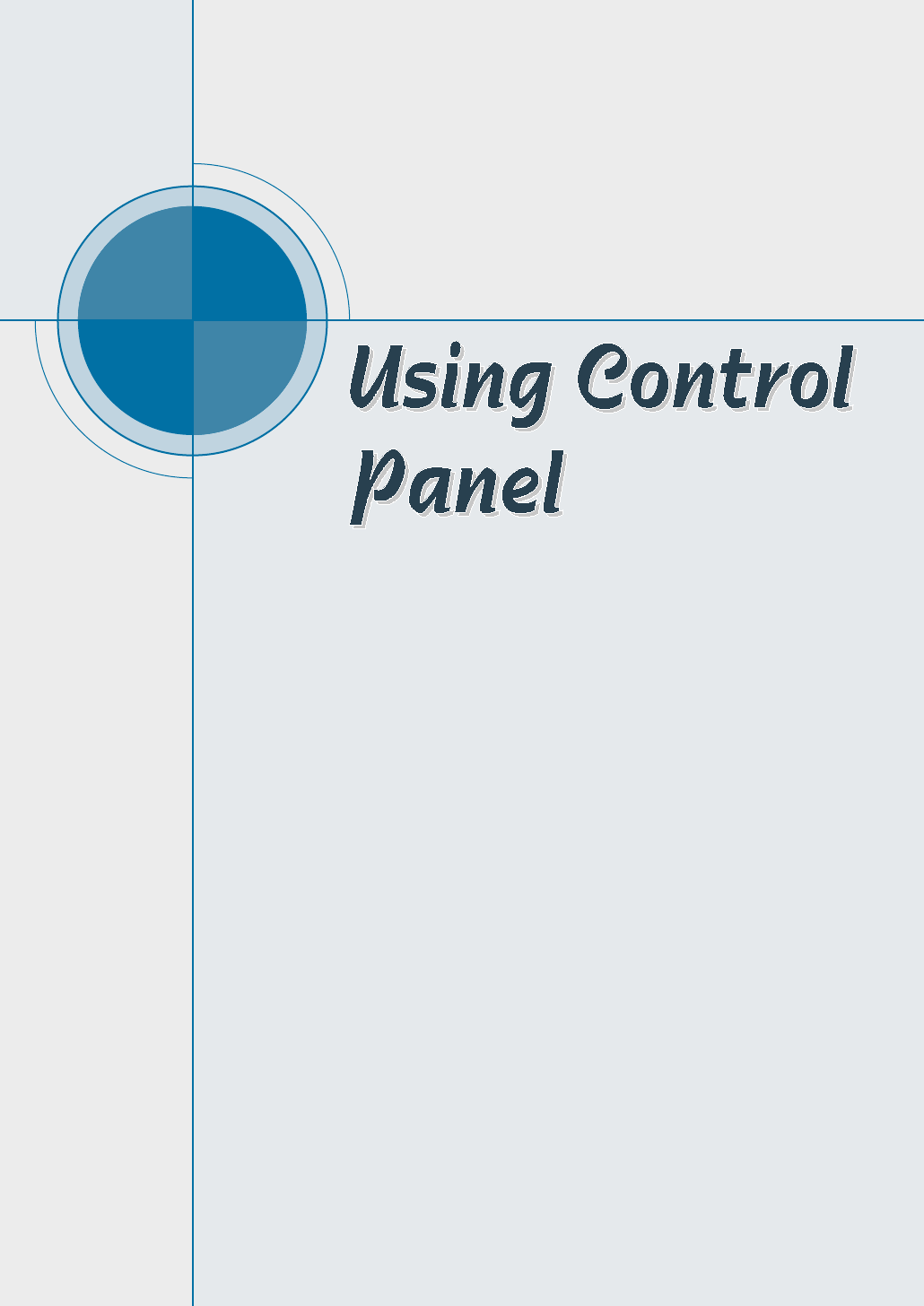
chapter
This chapter describes how to use the printer’s control
panel. It provides information on the following topics:
◆Control Panel Buttons
◆Control Panel Lights
3
3
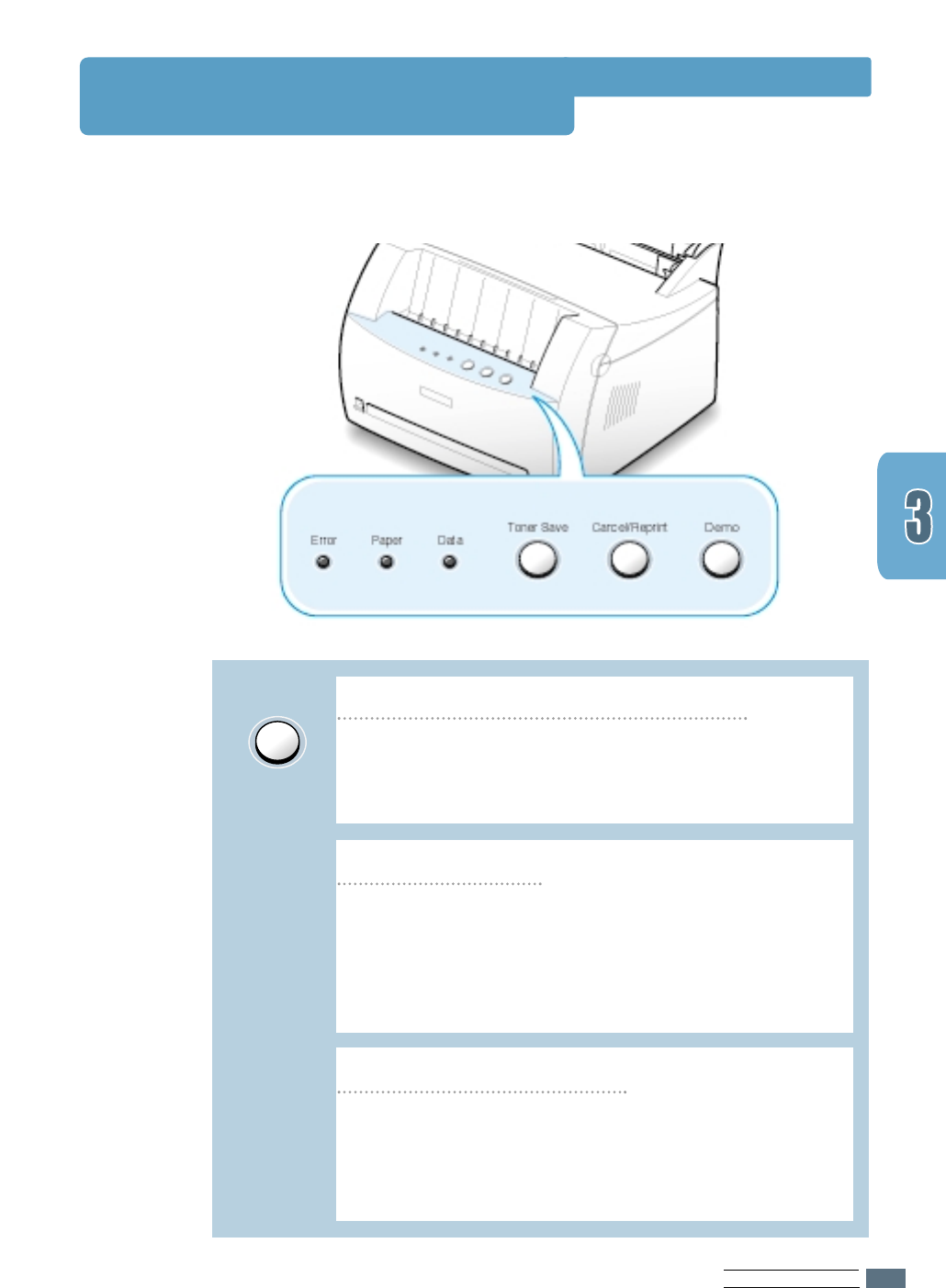
USING CONTROL PANEL
3.1
Control Panel Buttons
The printer has three buttons: Toner Save, Cancel/Reprint and Demo.
Demo
Clean the inside of the printer
Press and hold Demo for about 2 seconds until the
control panel lights blink slowly to print a demo page.
The printer must be in the Ready mode.
Press and hold Demo for about 10 seconds until the
control panel lights remain lit. After cleaning the
printer, one cleaning sheet prints. For further
information, see page 6.5.
Print demo page
Start manual feeding
When you select Manual Feeder for Paper Source
from your software application, you should press
Demo each time you load a sheet of paper manually.
For further information, see “Using the Manual Input
Tray” on page 4.5.
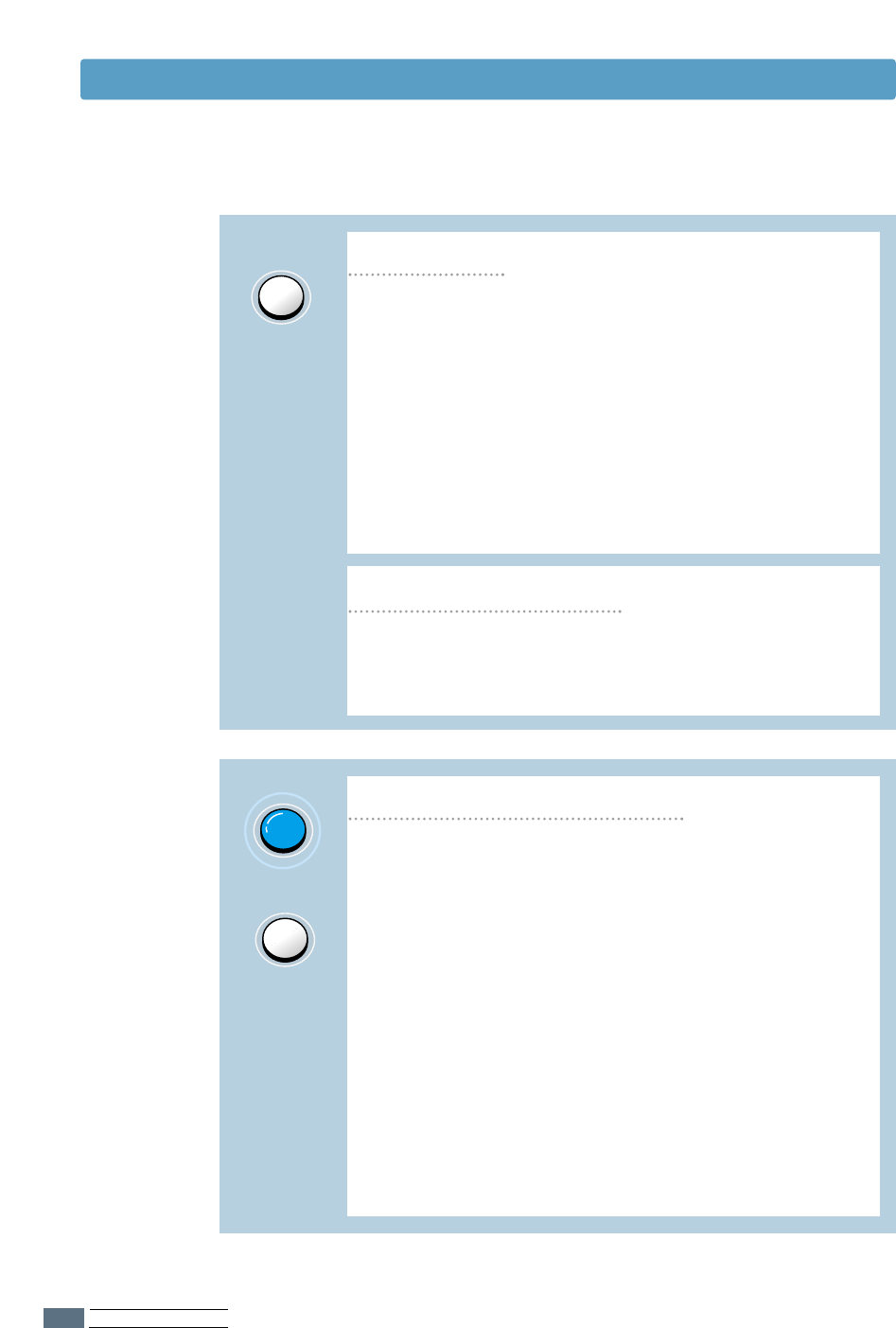
USING CONTROL PANEL
3.2
Control Panel Buttons
Cancel/Reprint
Reprint last page of the job
Press Cancel/Reprint and hold until the control panel
lights blink to cancel a job the printer is currently
printing. The Error light will blink while the print job
is cleared from both the printer and the computer, and
then the printer will return to the Ready mode. This
may take some time, depending on the size of the
print job.
Note: If the Cancel/Reprint button is accidentally
pushed, the job must be reprinted. There is no undo
function.
If you press Cancel/Reprint in the Ready mode, the
printer prints the last page of the last print job. See
page 5.21.
Cancel job
Toner Save
Toner Save
Press Toner Save to turn the Toner save mode on or
off. The printer must be in the Ready mode.
• If the button backlight is on, toner save mode
activates and the printer uses less toner to print a
document.
• If the button backlight is off, toner save mode is
disabled and you will print in normal quality.
To enable or disable the Toner Save mode using this
button, the Toner Save Mode option in the printer
driver must be set to Printer Setting.
For further information on the Toner Save mode,
see page 5.6.
(on)
(off)
Turn the Toner Save Mode on/off
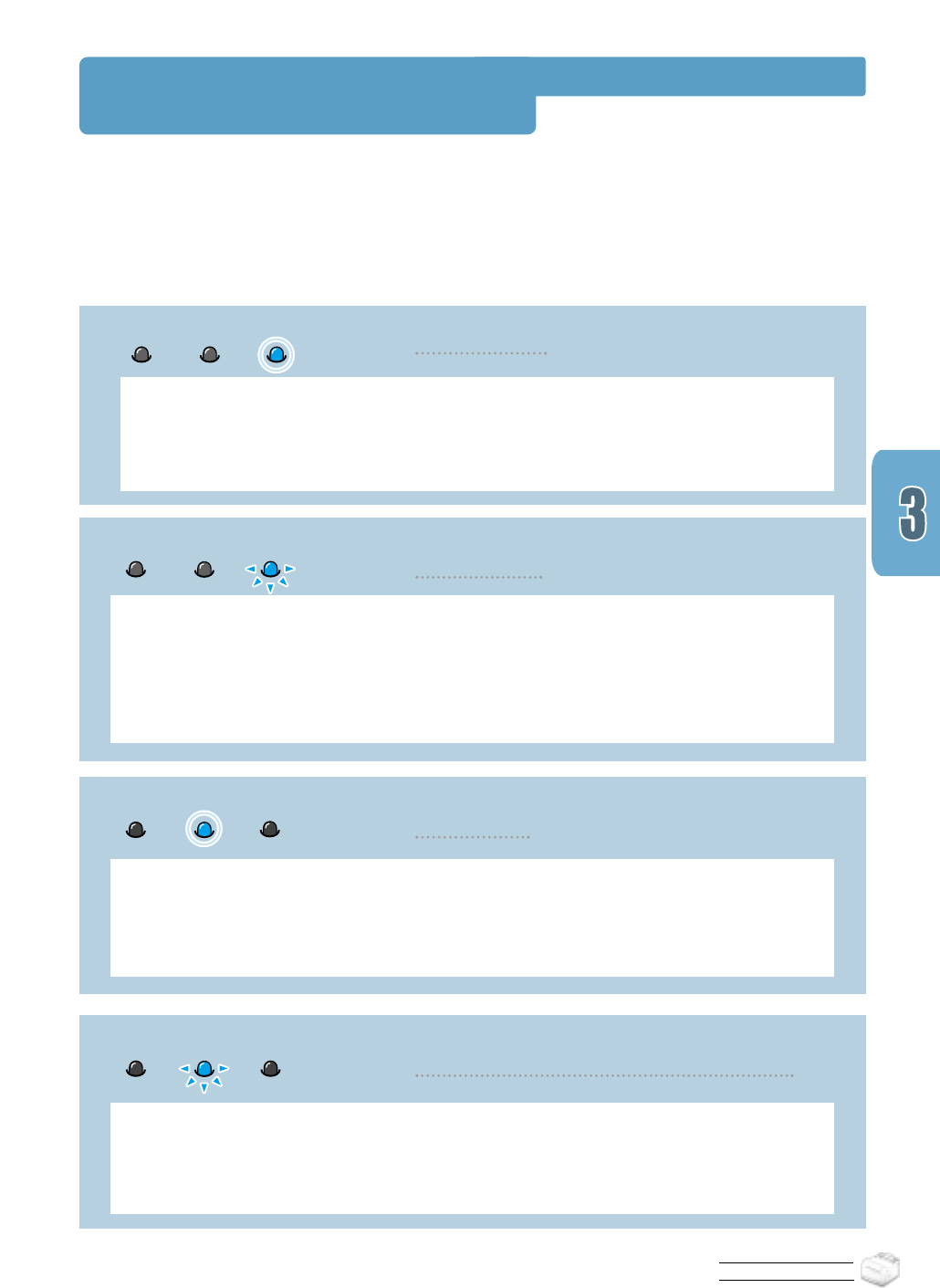
USING CONTROL PANEL
3.3
Control Panel Lights
The control panel lights indicate the status of your printer. If the Error light is on, the printer
is experiencing an error. See “Troubleshooting Error Messages” on page 7.17.
Control Panel Light Message
The Data light is on and the printer is ready to print.
No action is needed. If you press and hold the Demo button for about 2
seconds, a demo page will print.
Ready mode
Error Paper Data
The printer is out of paper.
Load paper into the printer. For the automatic tray, there is no need to press
any button to reset. For the manual tray, press the Demo button after loading.
Paper out
Data
Error Paper
In the Manual Feed mode, the printer is waiting for the Demo button to be
pressed.
Press the Demo button to start printing. You must press the button to print
each page after loading paper into the manual input tray.
Waiting for the Demo button to be pressed
Data
Error Paper
The printer is receiving or processing data. Wait for the job to print.
Pressing the Cancel/Reprint button cancels the current job. One or two pages
may print as the printer clears the print job. The printer will return to the
Ready mode after the job has been canceled.
Processing
Data
Error Paper
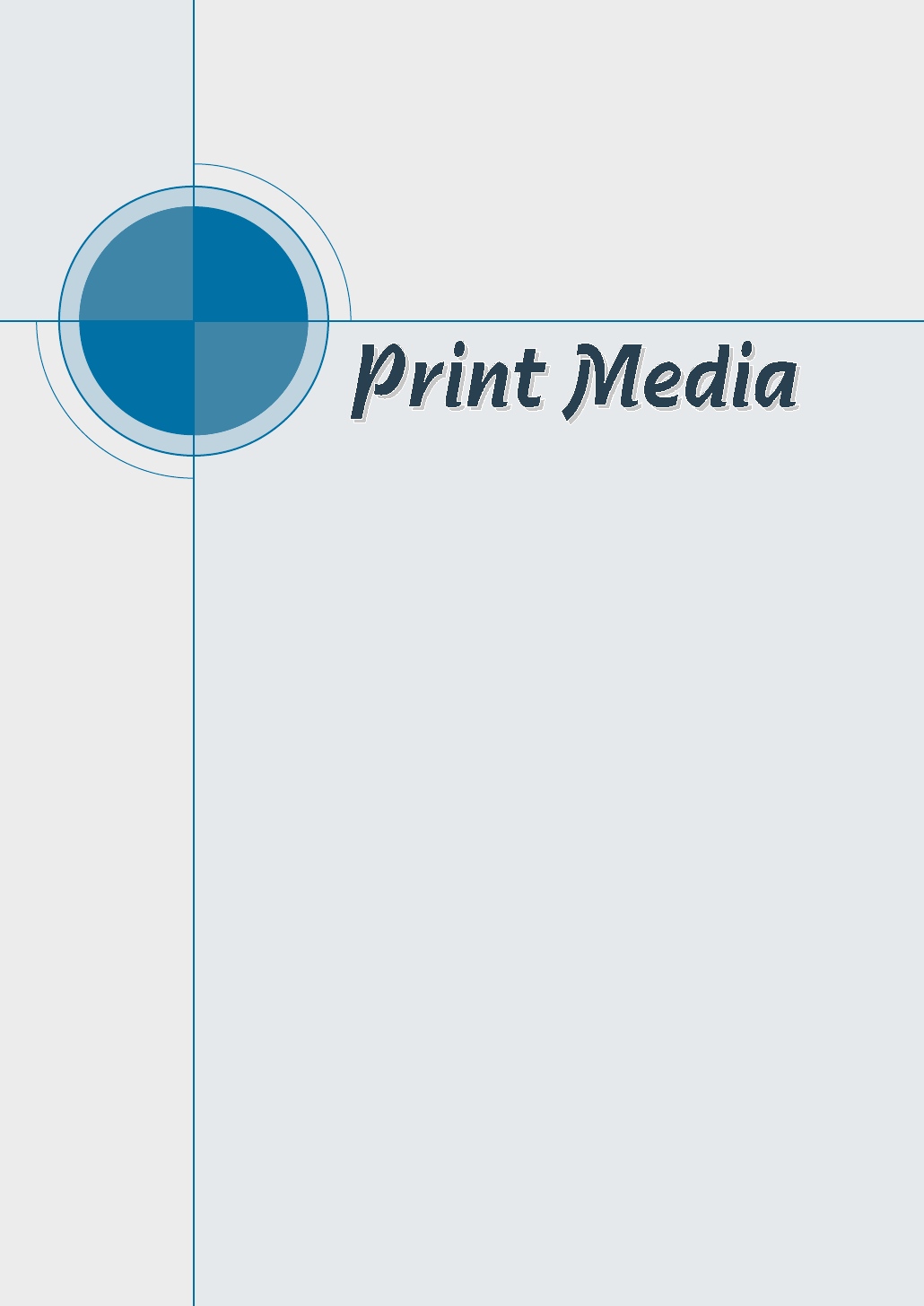
chapter
This chapter will help you to understand what kind of paper
you can use with the Samsung ML-1250 printer and how to
properly load paper in the different paper input trays for
the best print quality.
Topics included in this chapter are:
◆ Choosing Paper and Other Media
◆ Selecting the Output Location
◆ Loading Paper
◆ Printing on Envelopes
◆ Printing on Heavy Paper
◆ Printing on Labels
◆ Printing on Transparencies
◆ Printing on Preprinted Paper
◆ Printing on Card Stock or Custom-sized Media
4
4

PRINT MEDIA
4.1
Choosing Paper and Other Media
You can print on a variety of print media, such as plain paper,
envelopes, labels, transparencies, card stocks and so on. See
“Paper Specification” on page A.2. To get the best possible
print quality, use only high-quality copier-grade paper.
When you choose print media, consider the following:
• Desired outcome: The paper you choose should be
appropriate for the project.
• Size: You can use any size paper that fits easily within the
paper adjusters of the paper tray.
• Weight : Your printer supports paper weight as follows:
• 16~24 lbs bond for the automatic input tray
• 16~43 lbs bond for the manual input tray
• Brightness: Some papers are whiter than others and
produce sharper, more vibrant images.
• Surface smoothness: The smoothness of the paper affects
how crisp the printing looks on the paper.
Always test a sample of paper before purchasing large
quantities.
CAUTION: Using media that does not conform to the
specification listed in the paper specification can cause
problems that may require service. This service is not covered
by the warranty or service agreements.
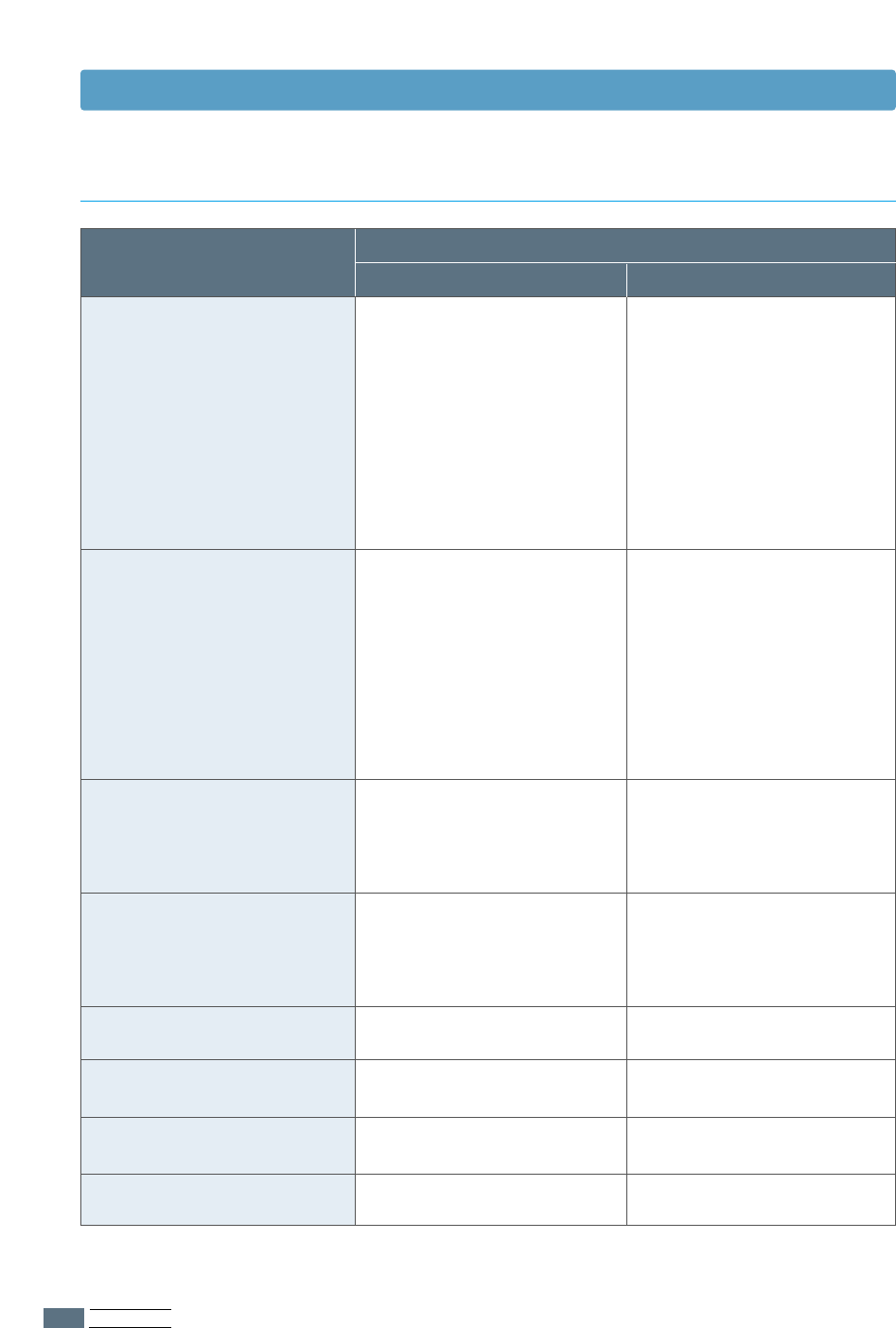
PRINT MEDIA
4.2
Choosing Paper and Other Media
*
Depending on paper thickness, maximum capacity may be reduced.
Plain Paper
Letter (8.5 x 11 in.)
Legal (8.5 x 14 in.)
Executive (7.25 x 10.5 in.)
A4 (210 x 297 mm)
A5 (148 x 210 mm)
Folio (8.5 x 13 in.)
B5 (182 x 257 mm)
Envelopes
No. 10 (4.12 x 9.5 in.)
DL (110 x 220 mm)
C5 (162 x 229 mm)
C6 (114 x 162 mm)
B5 (176 x 250 mm)
Monarch (3.87 x 7.5 in.)
Labels
Letter (8.5 x 11 in.)
A4 (210 x 297 mm)
Transparency film
Letter (8.5 x 11 in.)
A4 (210 x 297 mm)
Card stock
Bond Paper
Thin Paper (12 lb ~ 16 lb)
Thick Paper (24 lb ~ 43 lb)
Automatic Input Tray
150
150
150
150
150
150
–
5
5
5
5
5
5
5
5
5
5
5
5
150
5
Manual Input Tray
1
1
1
1
1
1
1
1
1
1
1
1
1
1
1
1
1
1
1
1
1
Media Sizes and Capacities
Input Source/Capacity*
Media Size
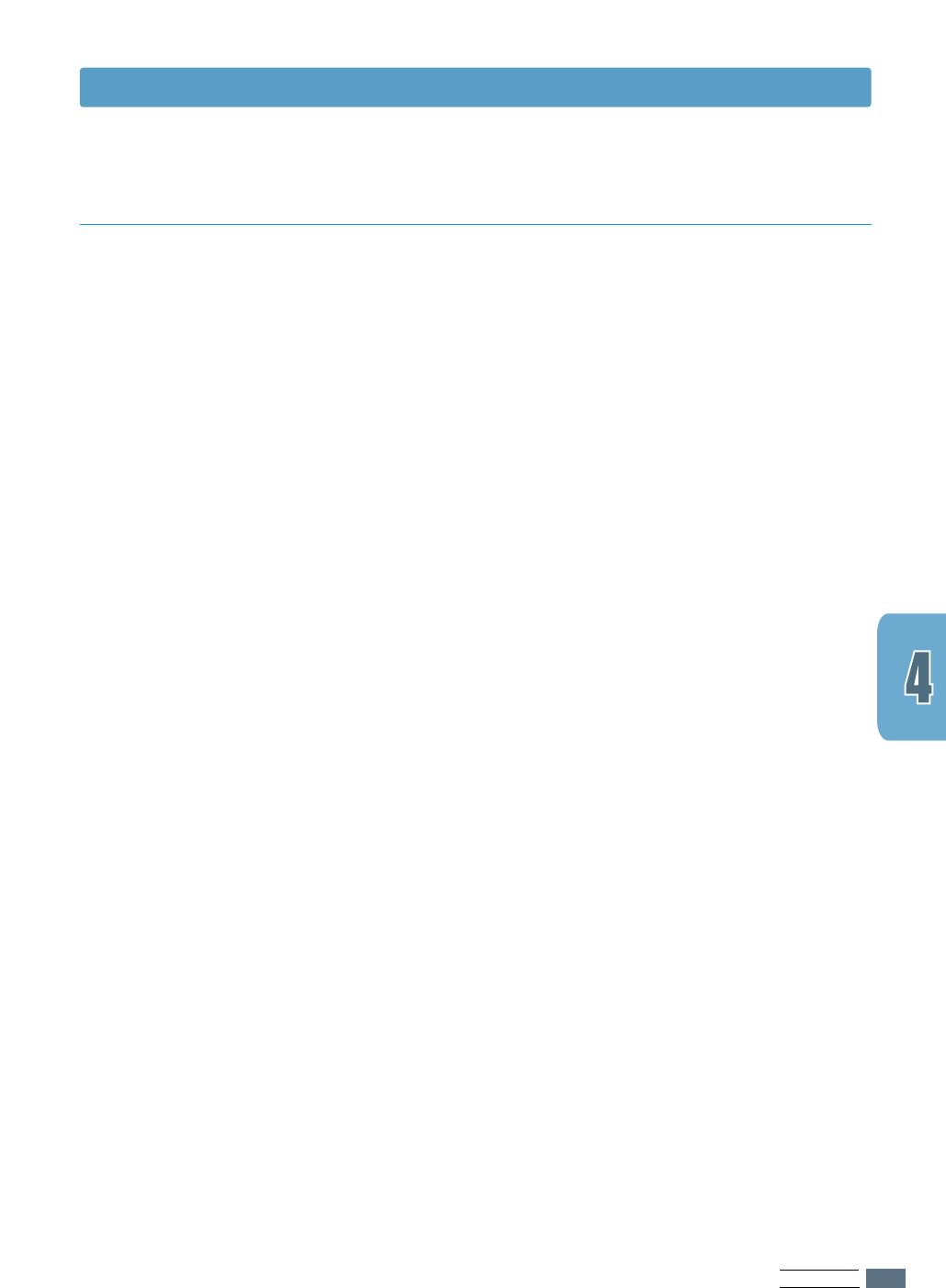
When selecting or loading paper, envelopes, or other special
media, keep these guidelines in your mind:
• Attempting to print on damp, curled, wrinkled, or torn paper
can cause paper jams and poor print quality.
• Use cut-sheet paper only. You cannot use multi-part paper.
• Use only high-quality, copier grade paper.
• Do not use paper that has been already printed on or that
has been fed through a photocopier.
• Do not use paper with irregularities, such as tabs or
staples.
• Do not attempt to load any tray during printing and never
overfill the tray. This could cause a paper jam.
• Avoid paper with embossed lettering, perforations, or
texture that is too smooth or too rough.
• Colored paper should be of the same high quality as white
photocopy paper. The pigments must withstand the printer’s
fusing temperature of 400°F (205°C) for 0.1 second without
deterioration. Do not use paper with a colored coating that
was added after the paper was produced.
• Preprinted forms must be printed with nonflammable, heat-
resistant inks that do not melt, vaporize, or release
hazardous emissions when subjected to the printer’s
approximately 400°F (205°C) fusing temperature for 0.1
second.
• Store paper in its ream wrapper until ready to use. Place
cartons on pallets or shelves, not on the floor.
• Do not place heavy objects on top of the paper, whether it
is packaged or unpackaged.
• Keep paper away from moisture, direct sunlight or other
conditions that can cause it to wrinkle or curl.
PRINT MEDIA
4.3
Choosing Paper and Other Media
Paper Guidelines
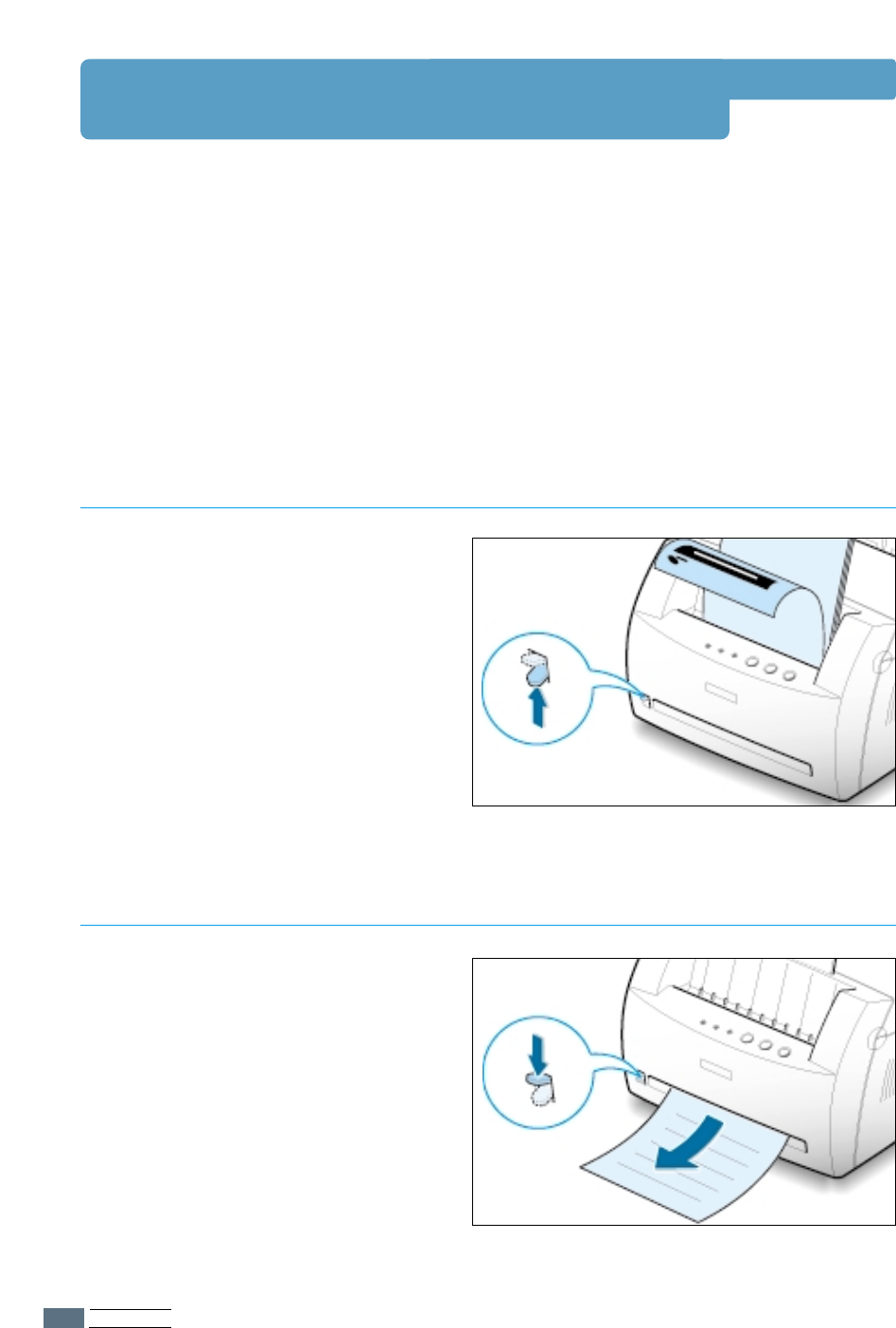
PRINT MEDIA
4.4
Selecting the Output Location
The printer has two output locations: the face-up output slot and the face-down output
tray. You can select the output location by changing the position of the output lever on the
front of the printer. To use the face-down output tray, be sure the output lever is in upper
(normal) position. To use the face-up output slot, push it down to open the slot.
• If paper coming out of the face-down output tray has problems, such as excessive curl, try
printing to the face-up output slot.
• To avoid paper jams, do not change the position of the output lever while the printer is
printing.
The face-down output tray collects paper
face-down, in correct order. Make
sure that the output lever is in the upper
position. (If not, push it up)
The face-down output tray should be
used for most print jobs and is
recommended for printing over 100
sheets of paper, continuously.
The printer prints to the face-up output
slot if it is open. Push the output lever
down to open the slot. Paper comes out
of the printer face-up.
Using the face-up output slot might
improve output quality with the following:
• envelopes
• labels
• paper heavier than 24 lb (90 g/m
2
)
Printing to the Face-Down Output Tray
Printing to the Face-Up Output Slot
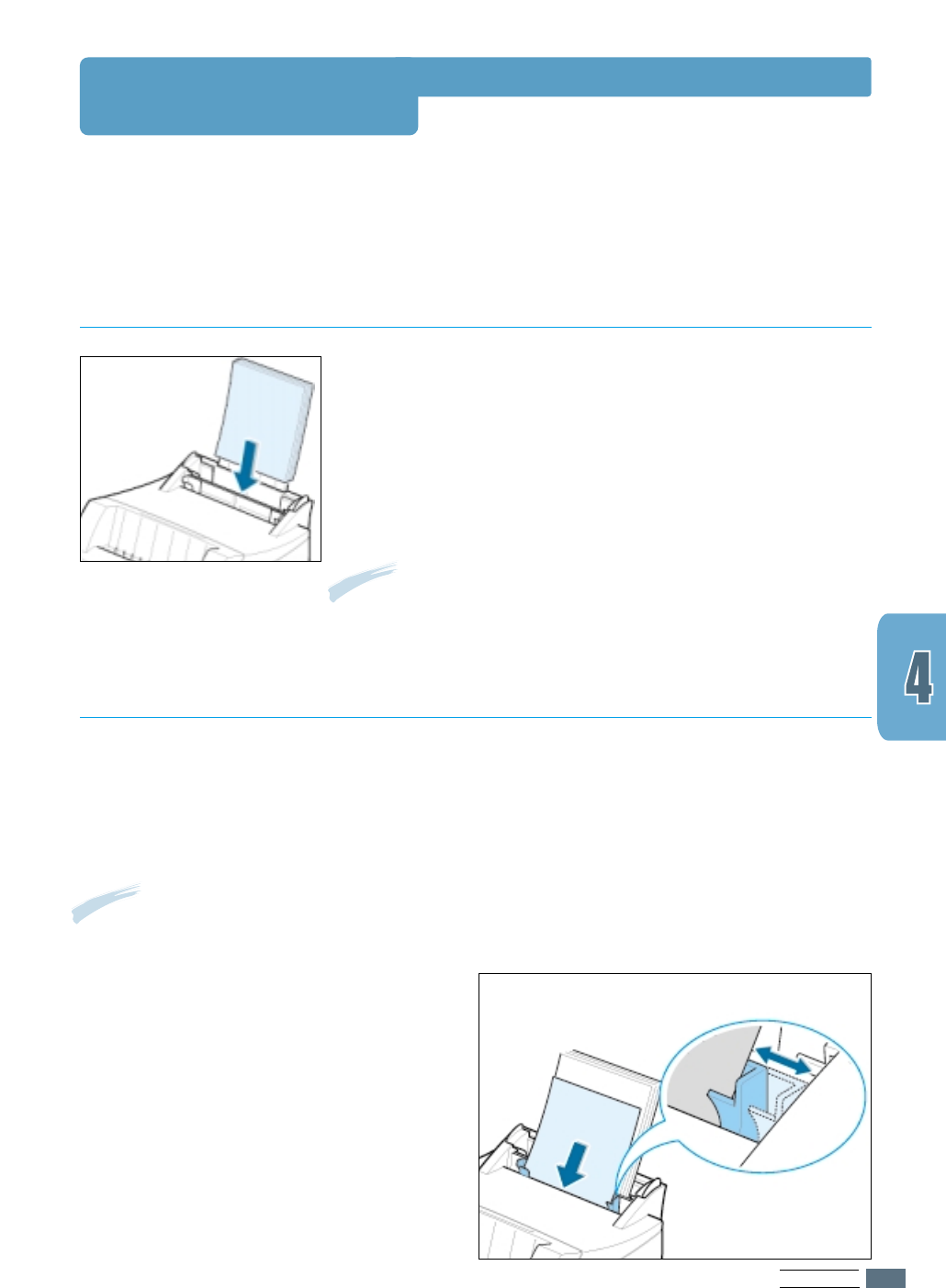
PRINT MEDIA
4.5
Loading Paper
The automatic input tray holds 150 sheets of plain paper and
5 sheets of special media. See “Media Sizes and Capacities” on
page 4.2 for acceptable paper size and capacities for each
input tray.
Load a stack of paper into the automatic input tray and print.
For details on loading paper in the automatic input tray, see
“Load Paper” on page 2.4.
Note: Before using the automatic input tray, you must remove
paper from the manual input tray.
Proper paper loading helps to prevent paper jams and ensure
trouble-free printing. Do not remove paper from the tray(s)
while a job is printing. Doing so may cause a paper jam.
Using the Automatic Input Tray
When you change the print settings, if you select Manual Feeder in the Paper Source
option, you can manually load paper in the manual
input tray
. Manually loading paper can be
helpful when you want to check the print quality after each page is printed.
If you experience a paper jam from the automatic
input tray,
load one sheet of paper at a
time into the manual
input tray
.
Note: To avoid a paper jam, use the manual tray with the automatic input tray loaded with paper.
Using the Manual Input Tray
1
Load the print media in the manual
input tray with the print side up.
Adjust the paper guide against the
stack of print media without bending.
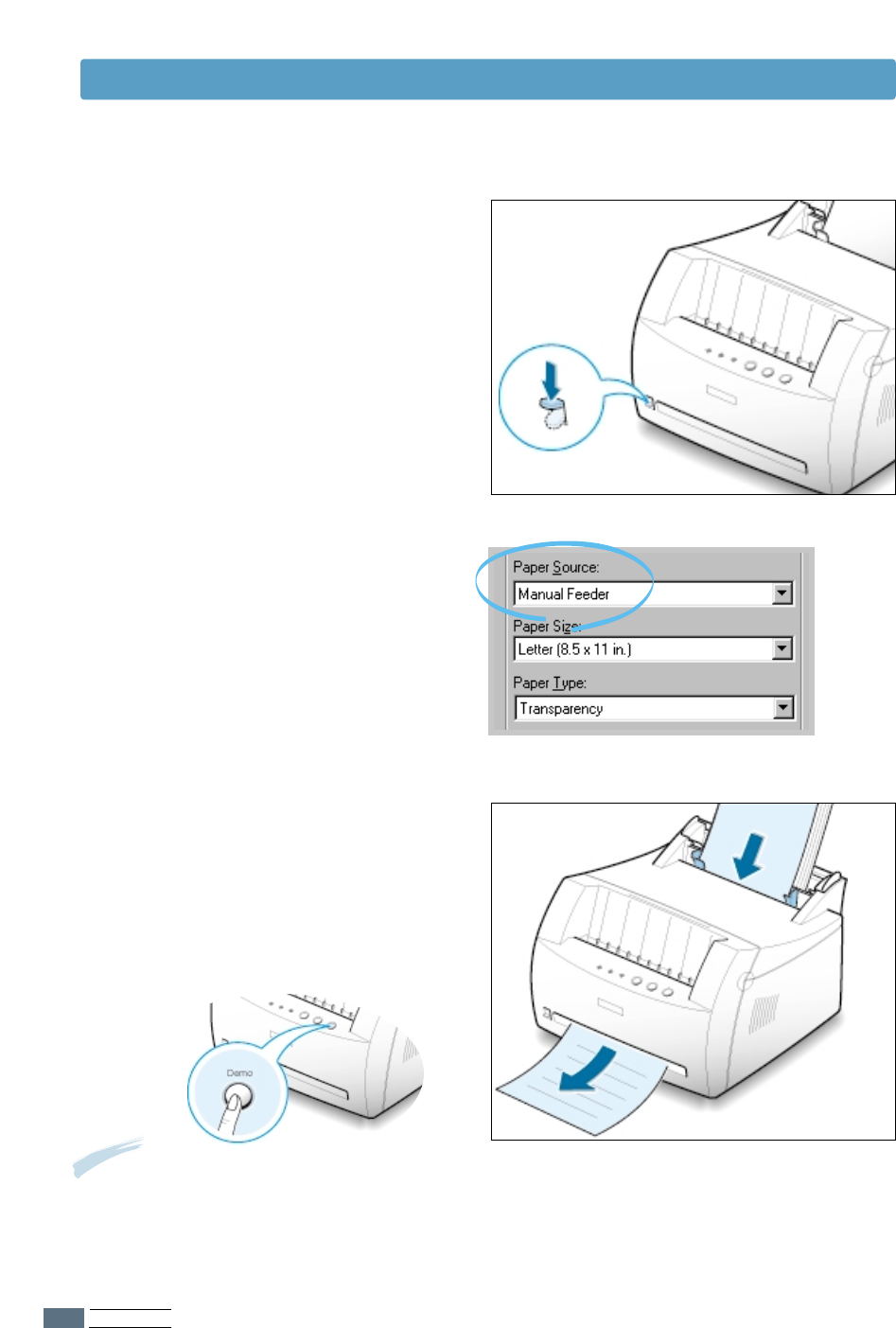
PRINT MEDIA
4.6
Loading Paper
4
Print the document.
3
When you print a document, you must
select Manual Feeder for Paper
Source from the software application,
and then select the correct paper size
and type. For details, see page 5.3.
5
If you are printing multiple pages, load
the next sheet after the first page
prints out.
6
Press Demo to start feeding.
Notes:
• The face-up output slot may not hold the printed pages properly.
• The printed pages will not stack in the face-down output tray unless you change output lever
position. After you finish using the face-up output slot, you must change the position of the
output lever to the normal position. Push it up.
2
Push the output lever down to open the
face-up output slot.
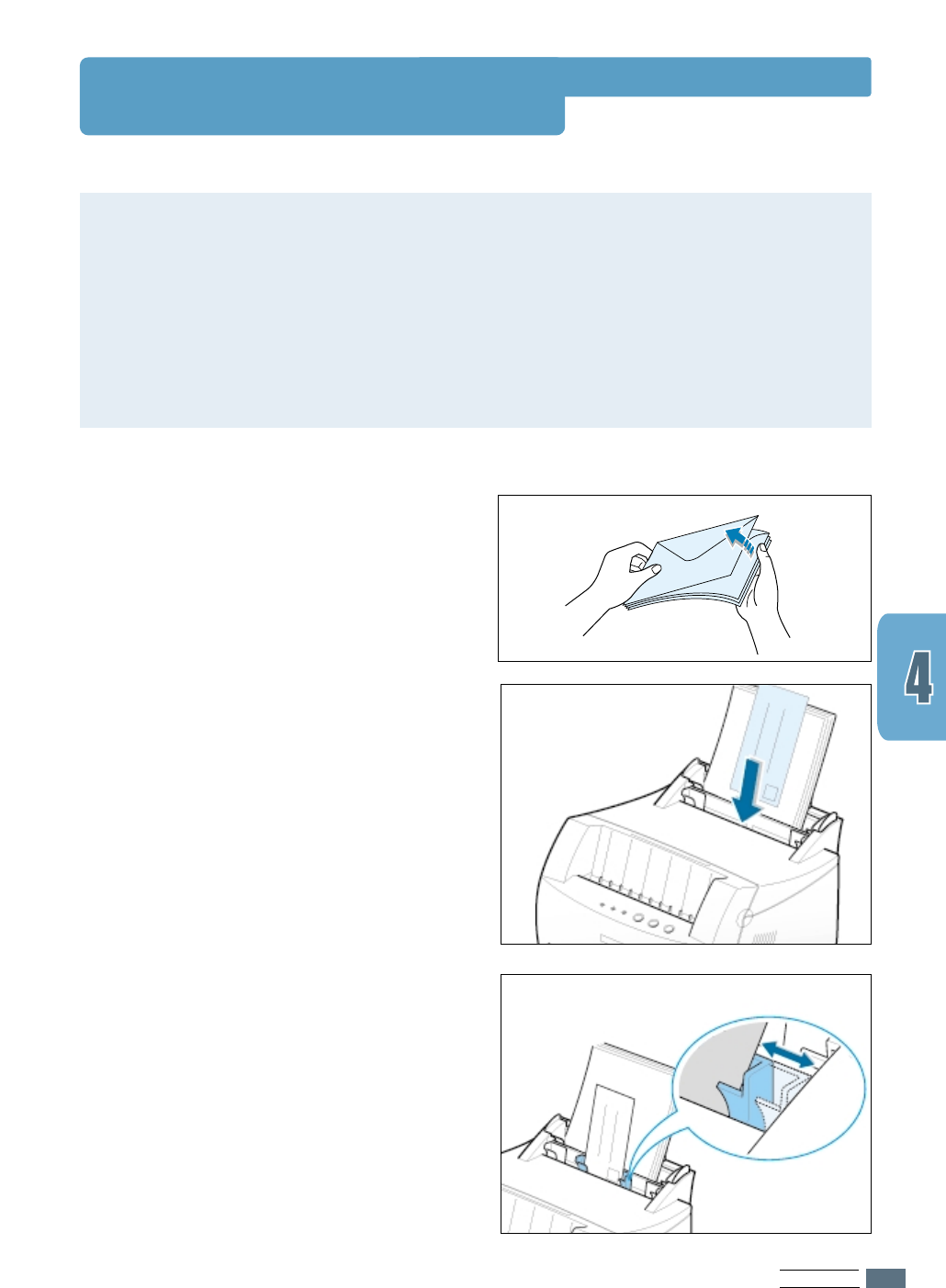
PRINT MEDIA
4.7
Printing on Envelopes
Guidelines
• Only use envelopes recommended for laser printers. Before you load envelopes in the
input tray, make sure that they are undamaged and that they are not stuck together.
• Do not feed stamped envelopes.
• Never use envelopes with clasps, snaps, windows, coated lining, or self-stick adhesives.
These envelopes may severely damage the printer.
2
Load the envelopes into the input tray
you want to use with the flap side
down.
The stamp area is on the right side
and the end of the envelope with the
stamp area enters the tray first.
1
Flex or fan
the envelopes to prepare
them for loading.
3
Adjust the guide to the edge of the
envelope stack.
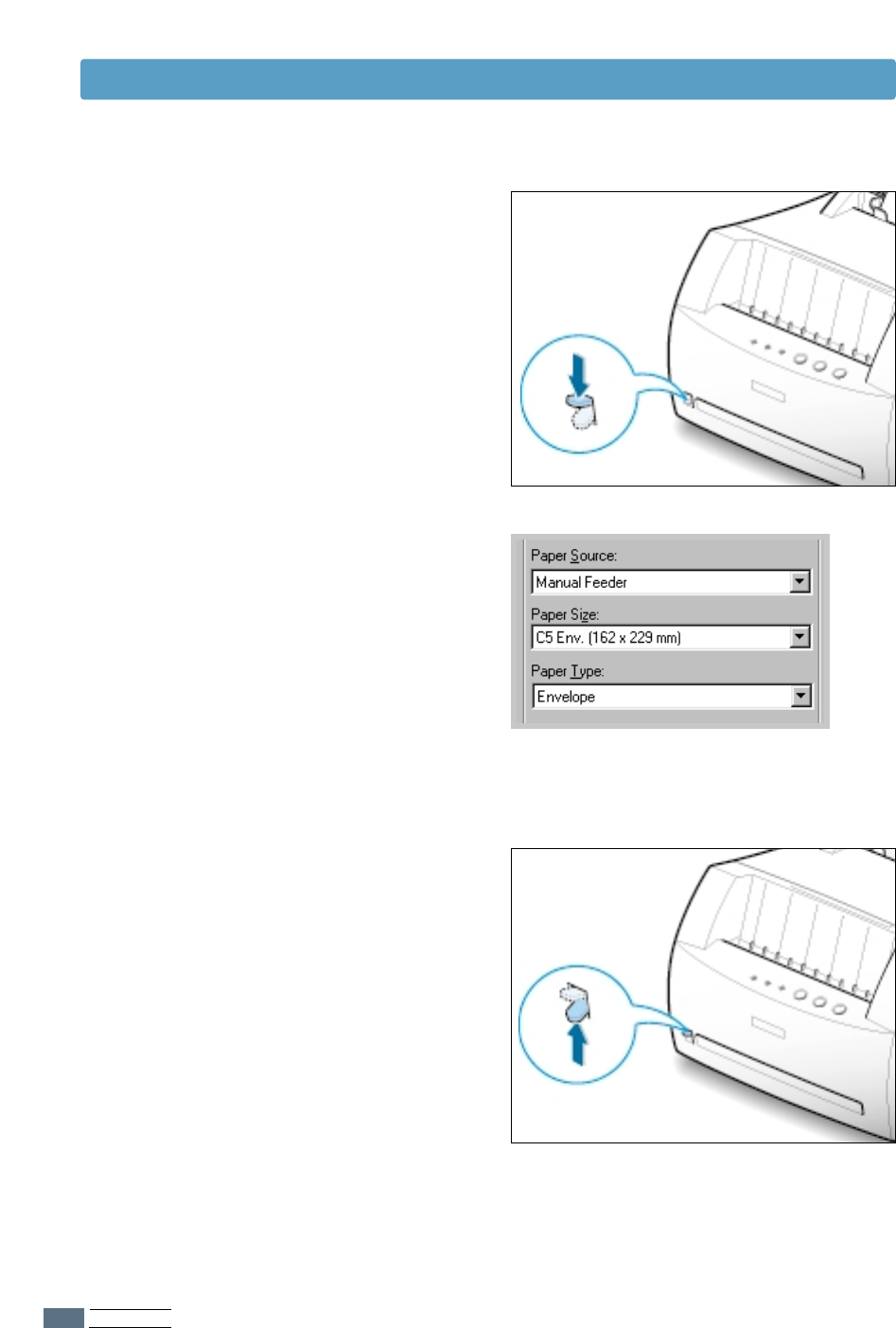
PRINT MEDIA
4.8
4
Push the output lever down.
5
When you print on envelopes, configure
the paper source, type and size
properly in the software application. For
details, see page 5.3.
7
After printing, push the output lever up.
6
Print the document.
Printing on Envelopes
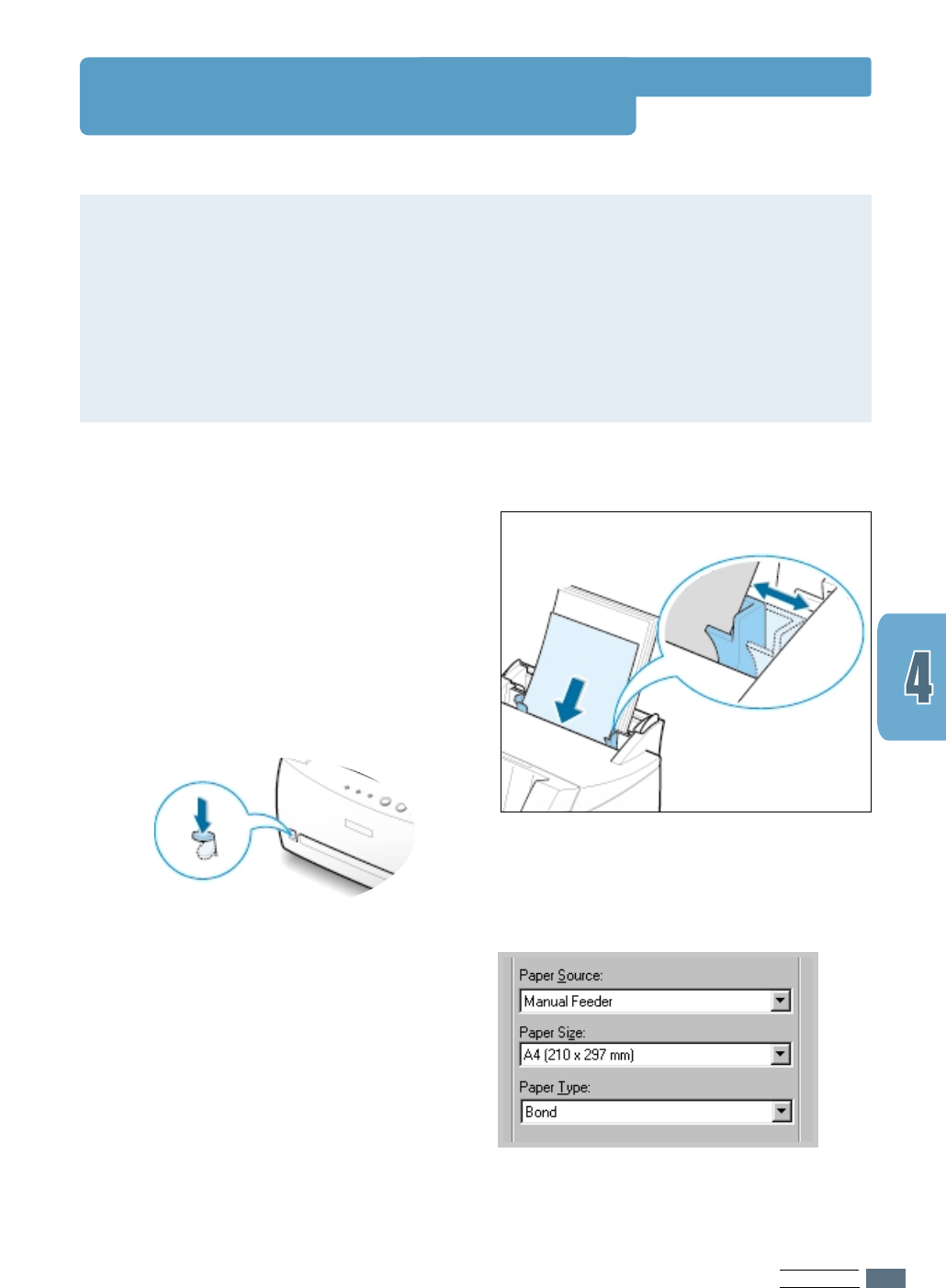
PRINT MEDIA
4.9
Printing on Heavy Paper
Guidelines
• Heavy paper is any paper heavier than 24 lb (90 g/m
2
). For cotton papers, you can use
24 lb paper. The maximum paper weight available for your printer is 43 lb (163g/m
2
).
• Do not use extremely heavy paper stock (greater than 43 lb, or 163 g/m
2
bond).
Misfeeds, mis-stacking, media jams, poor toner fusing, poor print quality, and excessive
mechanical wear can result.
2
Push the output lever down.
1
Load paper in the input tray you want
to use with print side up.
Adjust the guide to fit the width of the
labels.
3
When you print on heavy paper, select
Bond in the Paper Type section, and
then configure the paper source, and
size in the software application. For
details, see page 5.3.
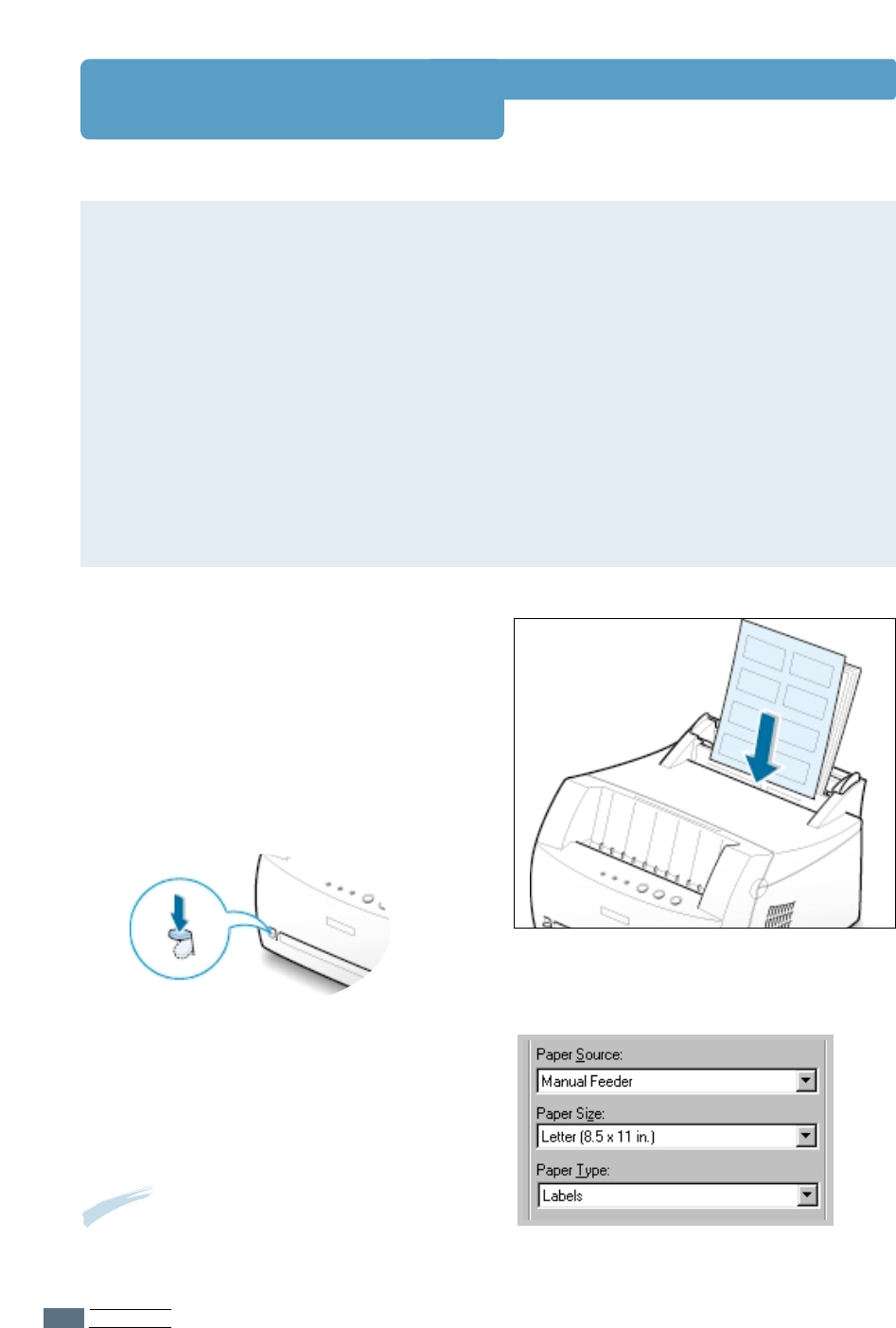
PRINT MEDIA
4.10
Printing on Labels
Guidelines
• Only use labels recommended for laser printers.
• Verify that the labels’ adhesive material can tolerate fusing temperature of 200°C
(392°F) for 0.1 second.
• Make sure that there is no exposed adhesive material between the labels. Exposed areas
can cause labels to peel off during printing, which can cause paper jams. Exposed
adhesive can also cause damage to printer components.
• Do not feed a sheet of labels through the printer more than once. The adhesive backing
is designed for one pass through the printer.
• Do not use labels that are separating from the backing sheet or that are wrinkled,
bubbled, or otherwise damaged.
2
Push the output lever down.
1
Load labels in the input tray you want
to use with print side up.
Adjust the guide to fit the width of the
labels.
3
When you print on labels, configure the
paper source, type and size in the
software application. For details, see
page 5.3.
Note: To prevent them from sticking
together, do not let the printed label
sheets stack up as they are printed out.
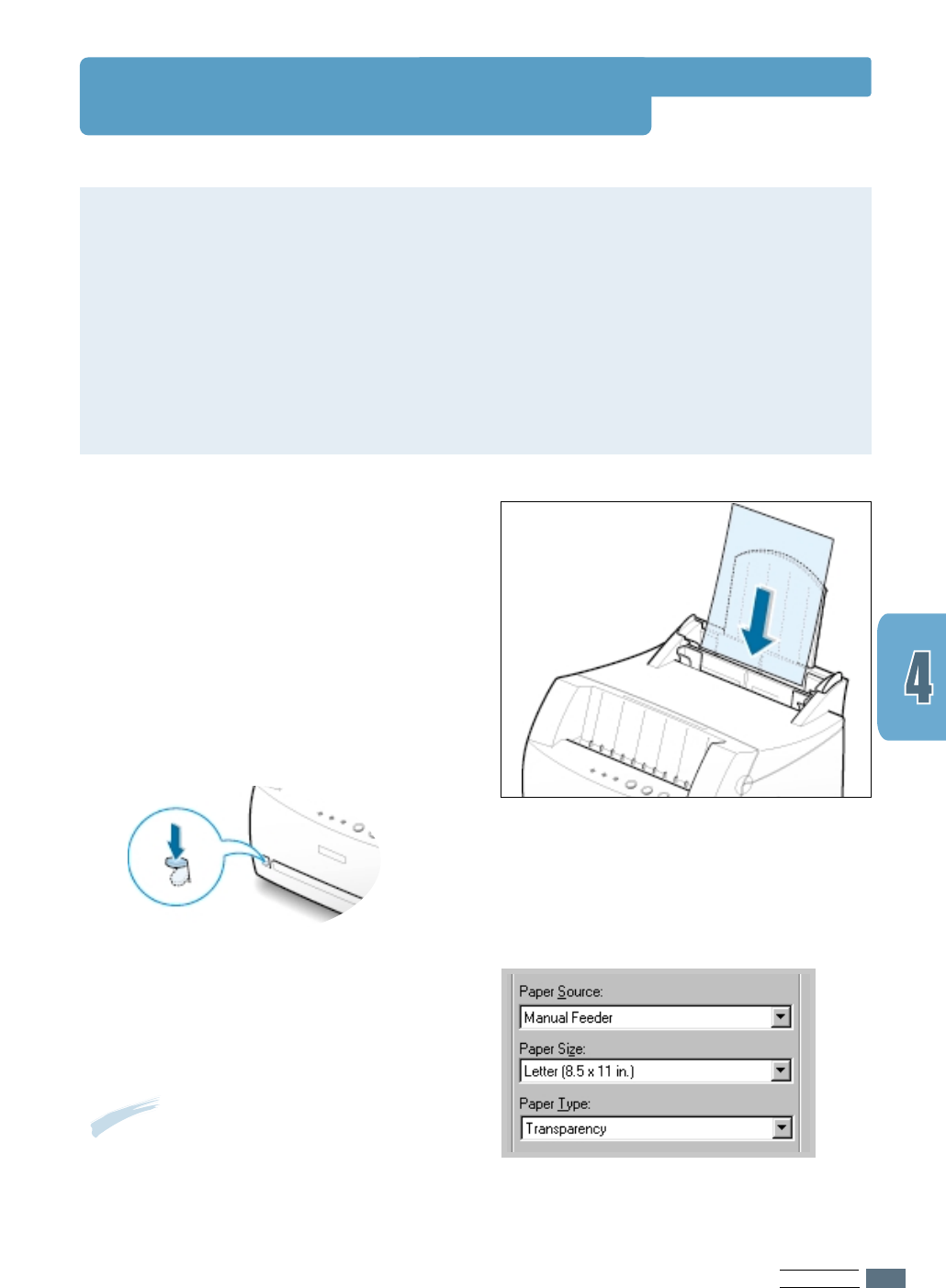
PRINT MEDIA
4.11
Printing on Transparencies
Guidelines
• Only use transparencies recommended for use in laser printers.
• Make sure that the transparencies are not wrinkled or curled, and that they do not have
any torn edge.
• Hold the transparencies by the edges and avoid touching the print side. Oils from your
fingers that are deposited on the transparency can cause print quality problems.
• Be careful not to scratch the printer side or leave fingerprints on it.
1
Load the transparencies in the desired
input tray with the print side up and
the adhesive strip entering the
printer first.
Adjust the guide to fit the width of the
transparencies.
3
When you print on transparencies,
configure the paper source, type and
size in the software application. For
details, see page 5.3.
Notes:
• To prevent transparencies from sticking
together, do not let the printed sheets stack
up as they are printed out.
• Place transparencies on a flat surface after
removing them from the printer.
2
Push the output lever down.
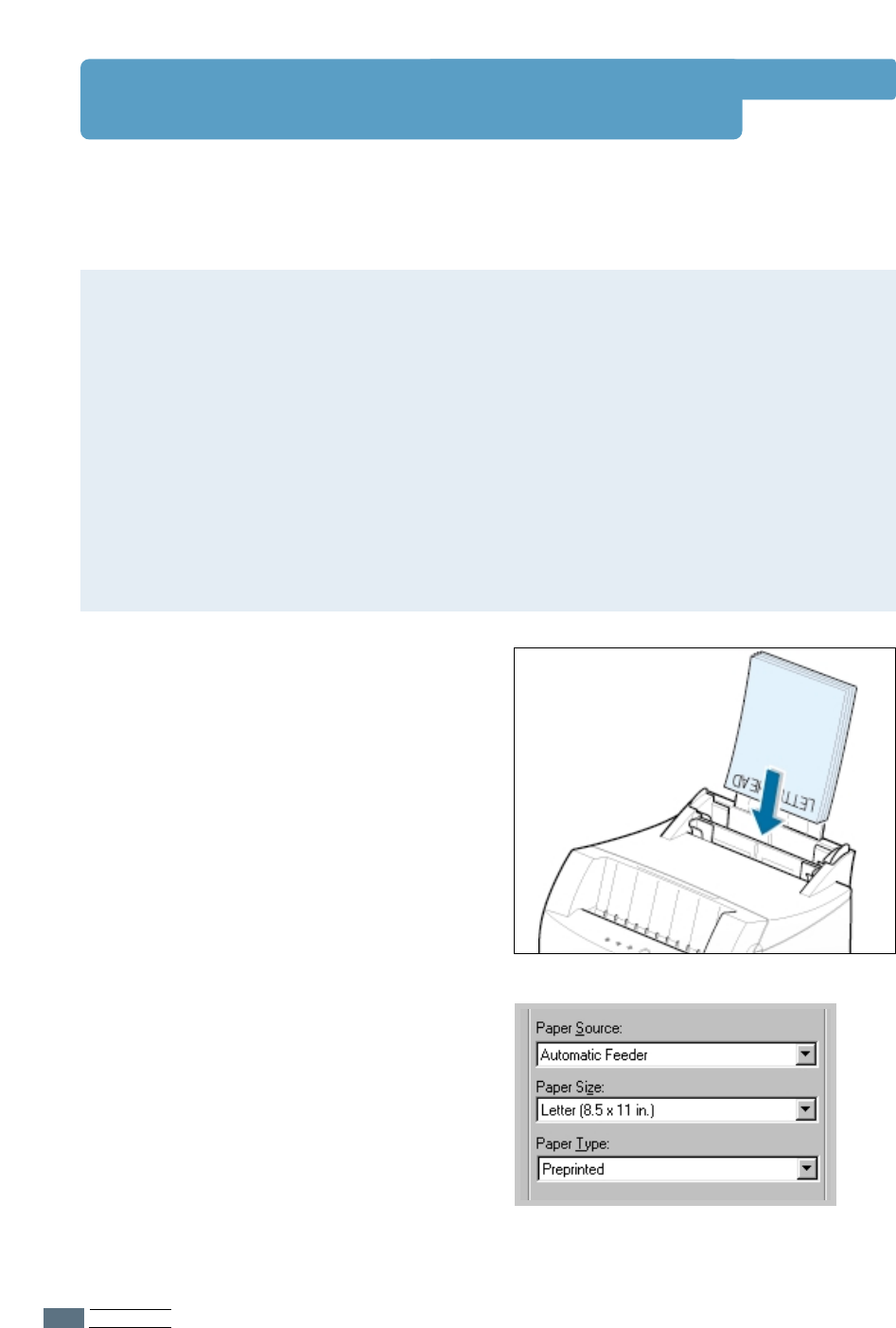
PRINT MEDIA
4.12
Printing on Preprinted Paper
1
Load letter-heads into the input tray
you want to use with the design face
up, and the bottom edge toward
the printer.
Adjust the guide to fit the width of the
paper stack.
2
When you print on the preprinted
paper, configure the paper source, type
and size in the software application. For
details, see page 5.3.
Preprinted paper is paper that has some type of printing placed on it before it is sent through
the printer (paper that has a preprinted logo at the top of the page, for example).
Guidelines
• Letterheads must be printed with heat-resistant ink that will not melt, vaporize, or
release hazardous emissions when subjected to the printer’s fusing temperature of 400°F
(205°C) for 0.1 second.
• Ink on letterhead must be non-flammable and should not adversely affect any printer
rollers.
• Forms and letterheads should be sealed in a moisture-proof wrapping to prevent changes
during storage.
• Before you load preprinted paper such as forms and letterheads, verify that the ink on
the paper is dry. During the fusing process, wet ink can come off preprinted paper.
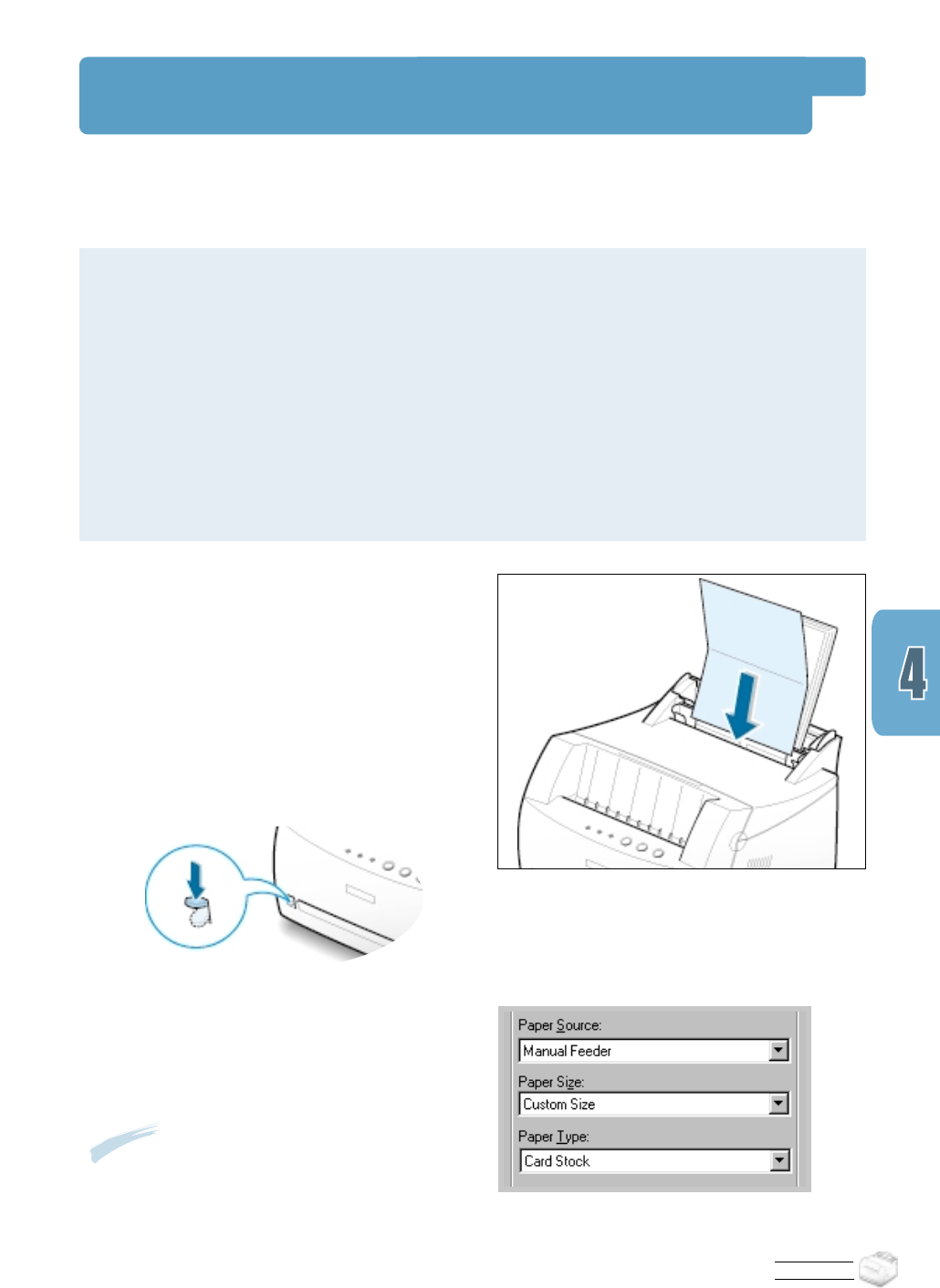
PRINT MEDIA
4.13
Printing on Card Stock or Custom-sized Media
2
Push the output lever down.
1
Load print media in the input tray you
want to use with the print side up,
and the short edge first .
Adjust the guide to fit the width of the
media.
3
Configure the paper source, type in the
printer driver’s properties (see page
5.3) and print.
Postcards, 3 by 5 in.(index) cards and other custom-sized media can be printed with
the ML-1250 printer.
Guidelines
• Always insert the short edge into the
input tray first
. If you want to print in landscape
mode, make this selection through your software. Inserting paper long-edge first may
cause a paper jam.
• Do not print on card stocks that is too small or too large. The minimum size is 76 by 127
mm (3 by 5 in.) for the manual input tray and 95 by 127 mm (3.8 by 5 in.) for the
automatic input tray, and the maximum size is 216 by 356 mm (8.5 by 14 in.).
• Set margins at least 6.4 mm (0.25 in.) away from the edges of the media in the software
application.
Note: If the size of your print media is not
listed in the Paper Size box in the Paper
tab of the printer driver properties, select
Custom Size and set the paper size
manually.
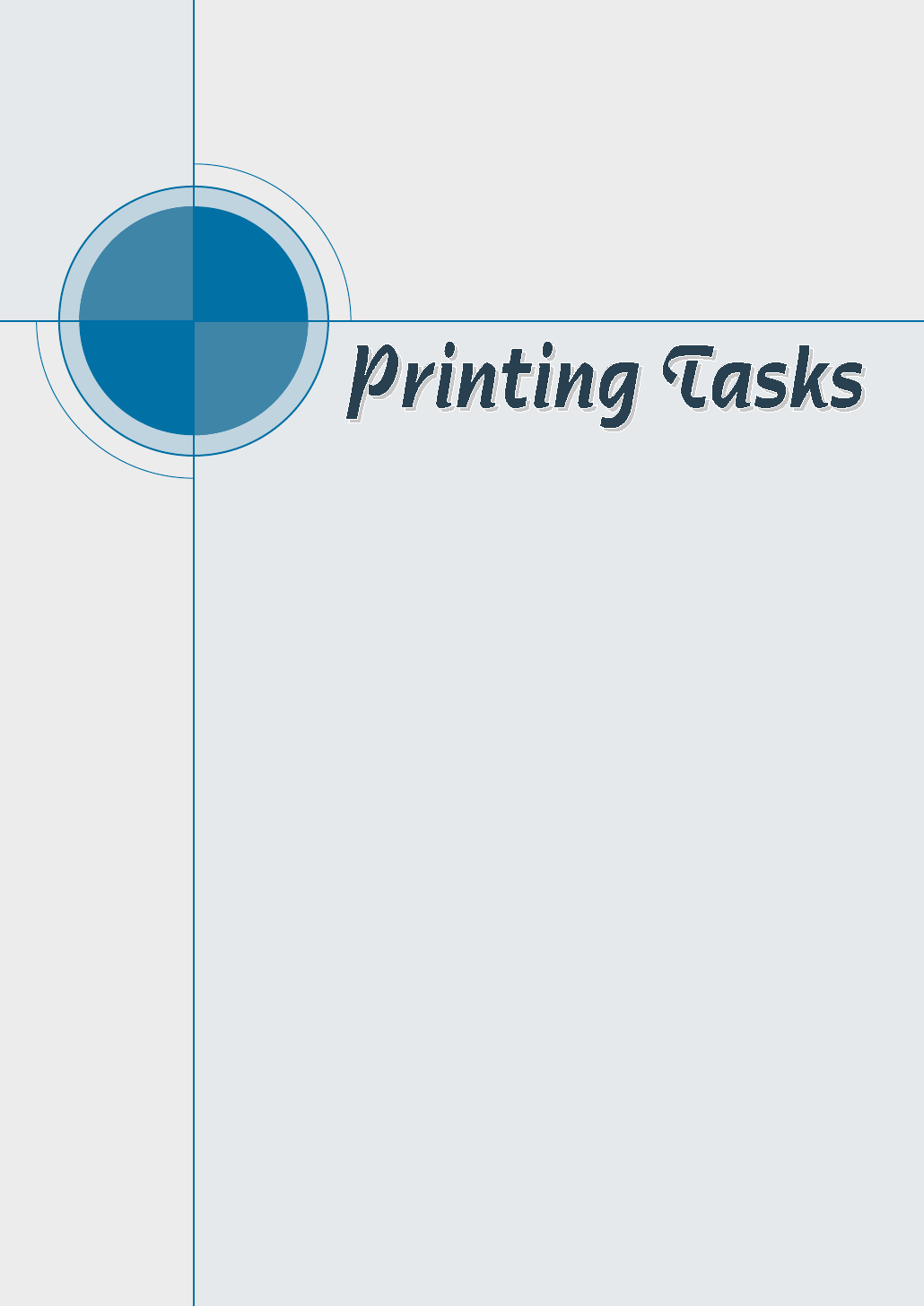
chapter
This chapter explains your printing options and gives common
printing tasks.
Topics included in this chapter are:
◆
Printing a Document
◆
Using Toner Save Mode
◆
Printing Multiple Pages on One Sheet of Paper (N-Up Printing)
◆
Fitting Your Document to a Selected Paper Size
◆
Printing Posters
◆
Setting Graphic Properties
◆
Printing Watermarks
◆
Using Page Overlay
◆
Reprinting the Last Page
◆
Printing on a Network Environment
5
5
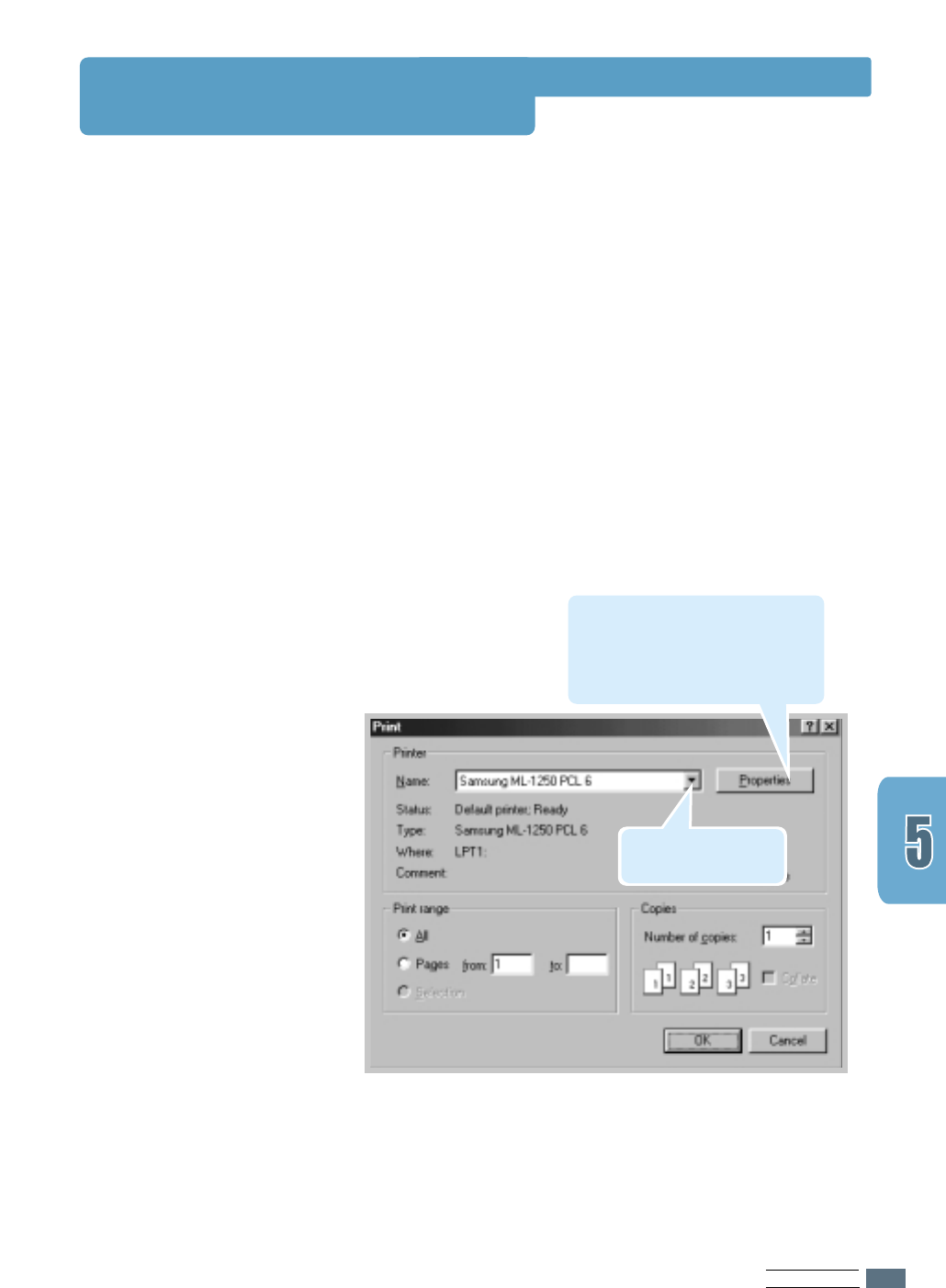
PRINTING TASKS
5.1
Printing a Document
The following procedure describes the steps required for
printing from various Windows applications. The exact steps
for printing a document may vary depending on the
application program. Refer to your software application’s
documentation for the exact printing procedure.
1
Open the document you want to print.
2
Select Print from the File menu. The Print dialog box for
your application will be displayed (the Print dialog box for
your application may look slightly different).
The basic print settings you require are usually selected
within this Print dialog box. These settings include the
number of copies, paper size, and page orientation.
If you see a Properties button,
click it. If you see Setup,
Printer, or Options, click that
button instead; then click
Properties in the next screen.
Make sure that your
printer is selected.
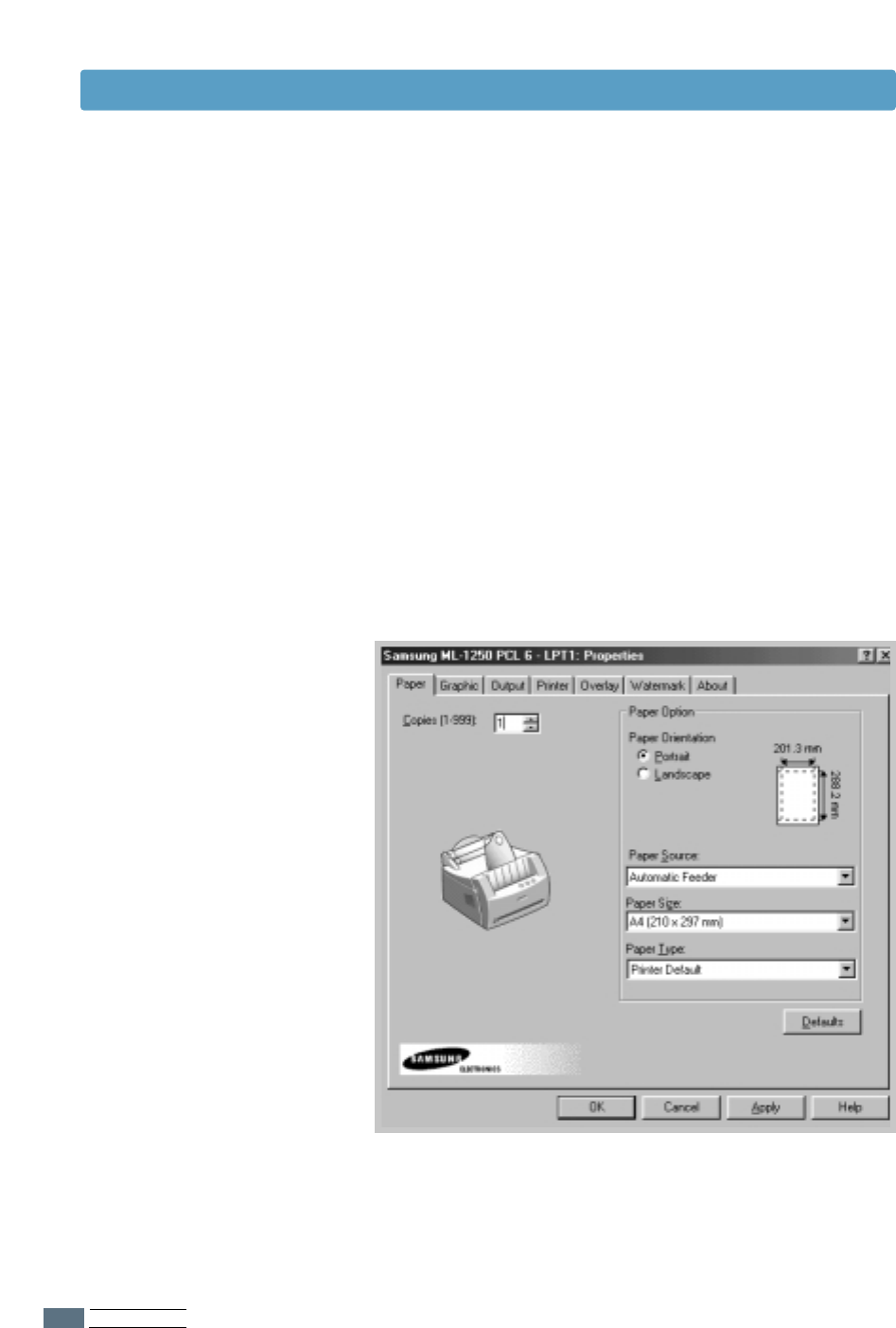
PRINTING TASKS
5.2
Printing a Document
3
To take advantage of the printer features provided by your
ML-1250 printer, click Properties in the application’s Print
dialog box and go to step 4.
If you see Setup, Printer, or Options, click that button
instead. Then click Properties in the next screen.
4
The Samsung ML-1250 PCL 6 Properties dialog box allows
you to access and change printer settings.
If necessary, click the Paper tab to display the settings
shown below. The Paper tab allows you to access and
change the settings for basic paper handling.
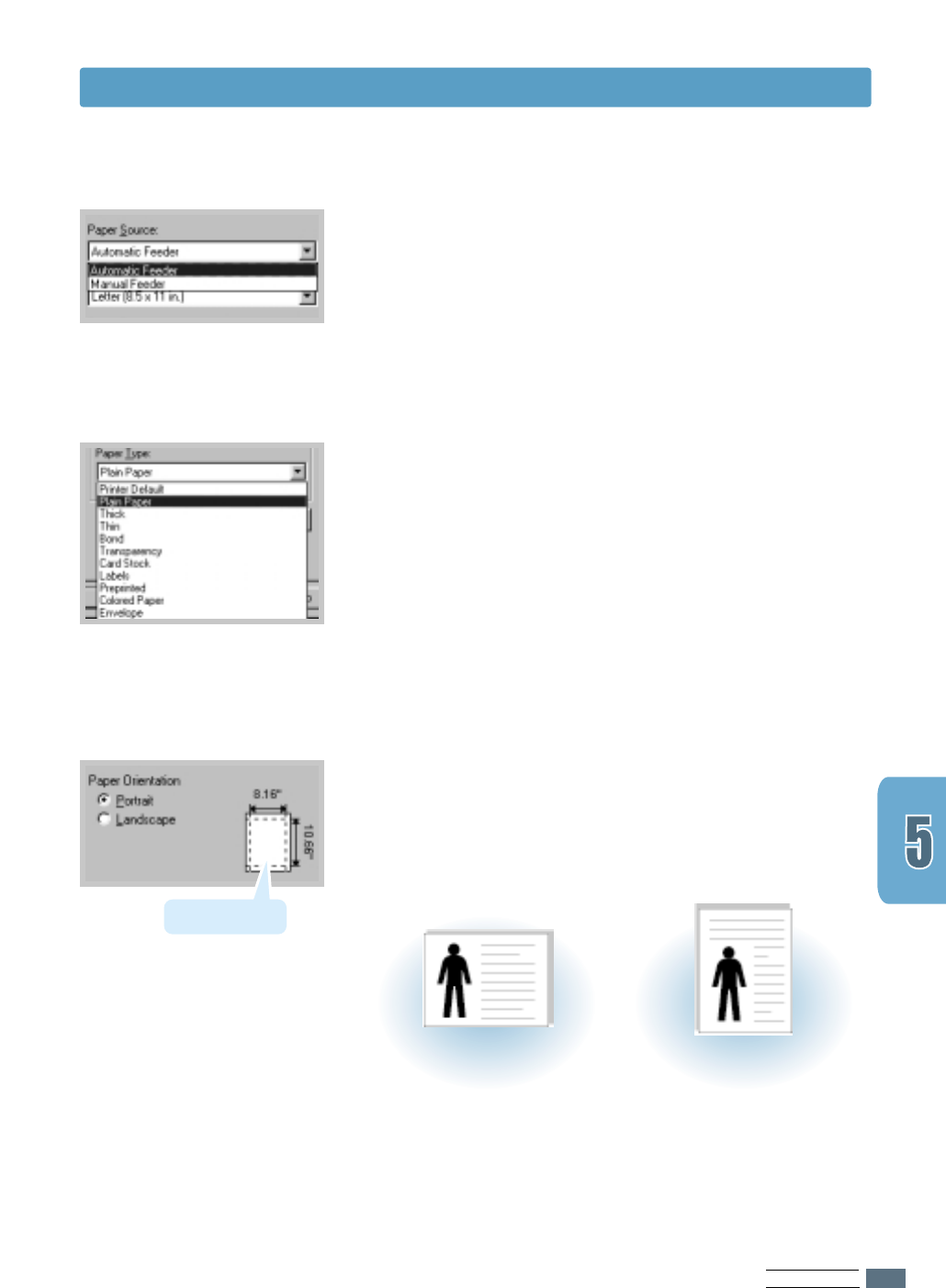
PRINTING TASKS
5.3
Printing a Document
4
Select Automatic Feeder from the Paper Source options
box unless you are printing with special media. To print
with special media, select Manual Feeder and feed one
sheet at a time into the printer. See page 4.5.
4
Select Plain Paper from the Paper Type options box
unless you want to use a different kind of print media. To
use a different kind of media, select the corresponding print
media name in the Paper Type options box. For more
information, please refer to Chapter 4 ‘Print Media’.
4
Select the paper size you have loaded in your printer.
4
You can also see the printable area.
4
The Paper Orientation option allows you to select the
direction in which information is printed on a page.
Portrait prints across the width of the page, letter style.
Landscape prints across the length of the page,
spreadsheet style.
Landscape
Portrait
Printable area
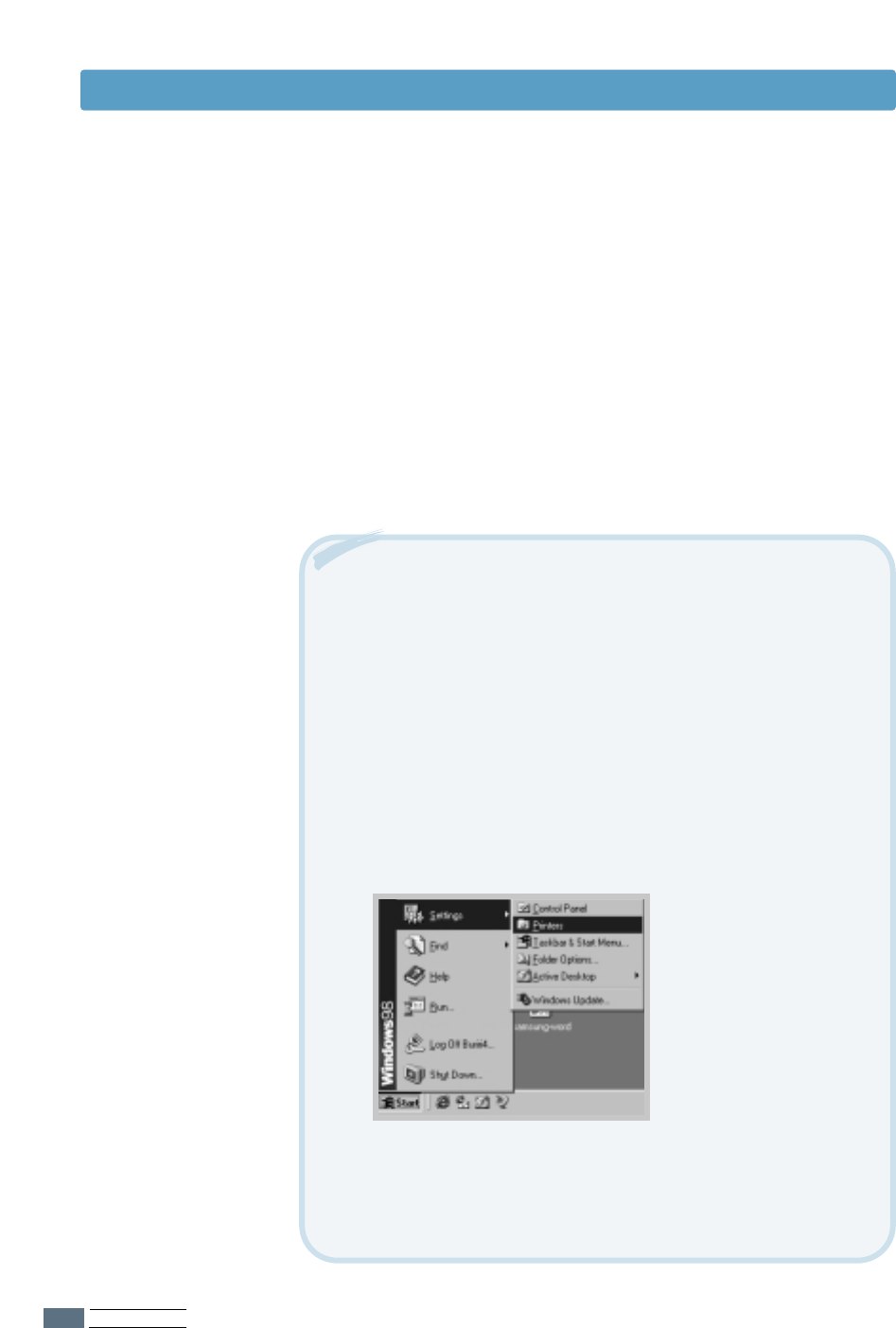
PRINTING TASKS
5.4
5
Click the other tabs on the top of the Properties dialog box
to access other features, if needed.
6
When you complete the print settings, click OK until the
Print dialog box is displayed.
7
Click OK to start printing.
• Most Windows applications will override settings you specify
in the printer driver. Change all print settings available in the
software application first, and then any remaining settings
using the printer driver.
• The settings you change remain in effect only while you are
using the current program. To make your changes permanent,
make them in the Printers folder as follows:
1. Click the Windows Start button.
2. Select Settings, and then Printers to open the Printers
window.
Notes:
3. Select the Samsung ML-1250 PCL 6 printer icon.
4. Click the right mouse button and select Properties to open
the properties window.
Printing a Document
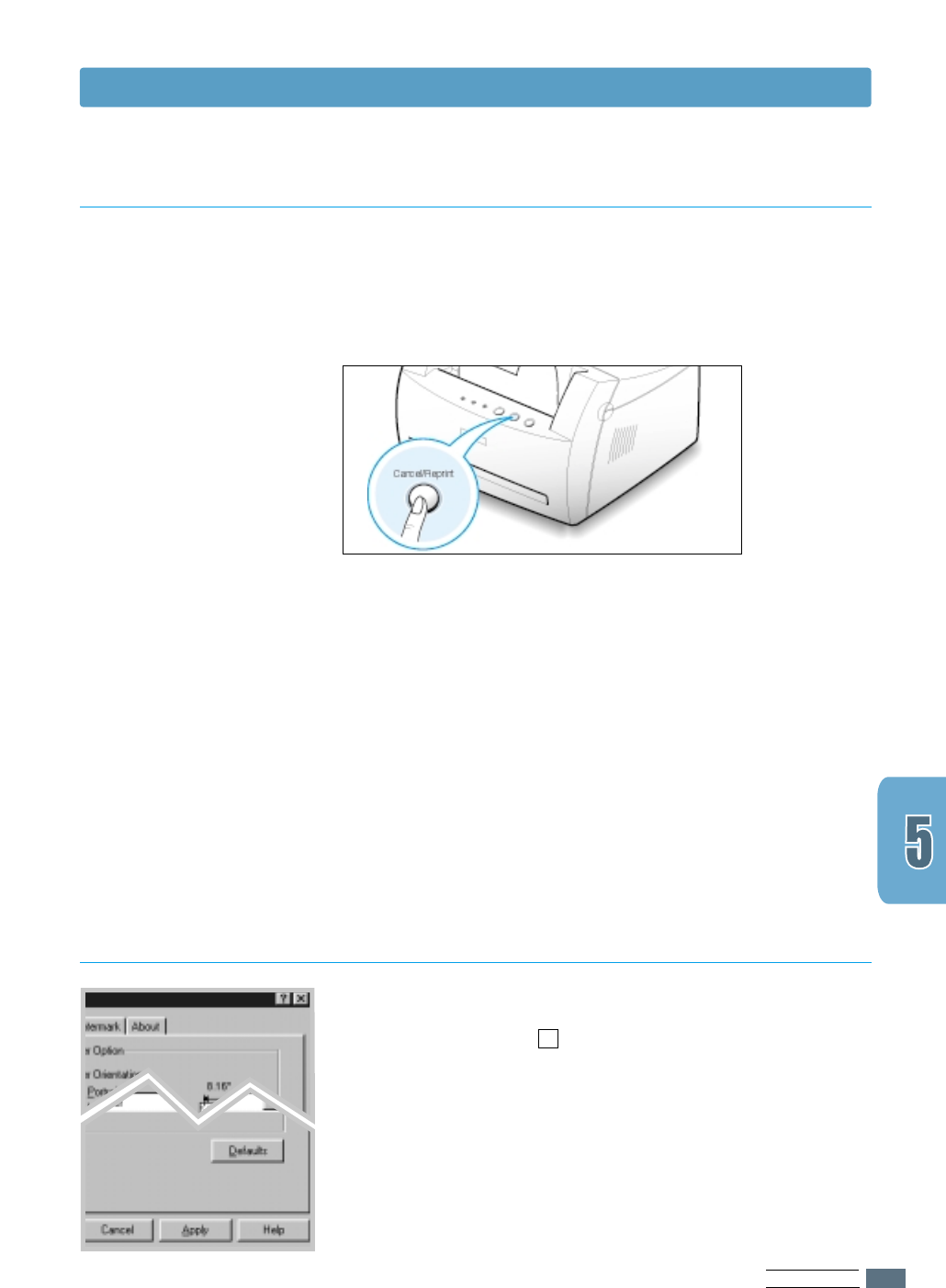
PRINTING TASKS
5.5
Printing a Document
There are two ways to cancel a print job.
To stop a print job from your printer
Press the Cancel/Reprint and hold until the control panel
light blink to cancel job the printer is currently printing.
The printer will finish printing the page that is moving through
the printer and delete the rest of the print job while the Error
light is blinking. Pressing Cancel/Reprint cancels only the
current job in the printer. If more than one print job is in
printer memory, Cancel/Reprint must be pressed once for
each job.
To stop a print job from the Printers folder
1. From the Start menu, select Settings.
2. Select Printers to open the Printers window,
then double-click the Samsung ML-1250 PCL 6 icon.
3. From the Document menu, select Cancel Printing
(Windows 9x) or Cancel (Windows Me/NT 4.0/2000).
The Samsung ML-1250 printer has a help screen that can be
activated by the Help button in the printer’s properties dialog
box. You can also click ? from the upper right hand corner,
and then click on any setting.
These help screens give detailed information about the printer
features provided by the Samsung ML-1250 printer driver.
To restore the default printer properties setting when you
change the print settings, click Defaults in the Samsung
ML-1250 PCL 6 Properties dialog box.
Canceling a Print Job
Using Help
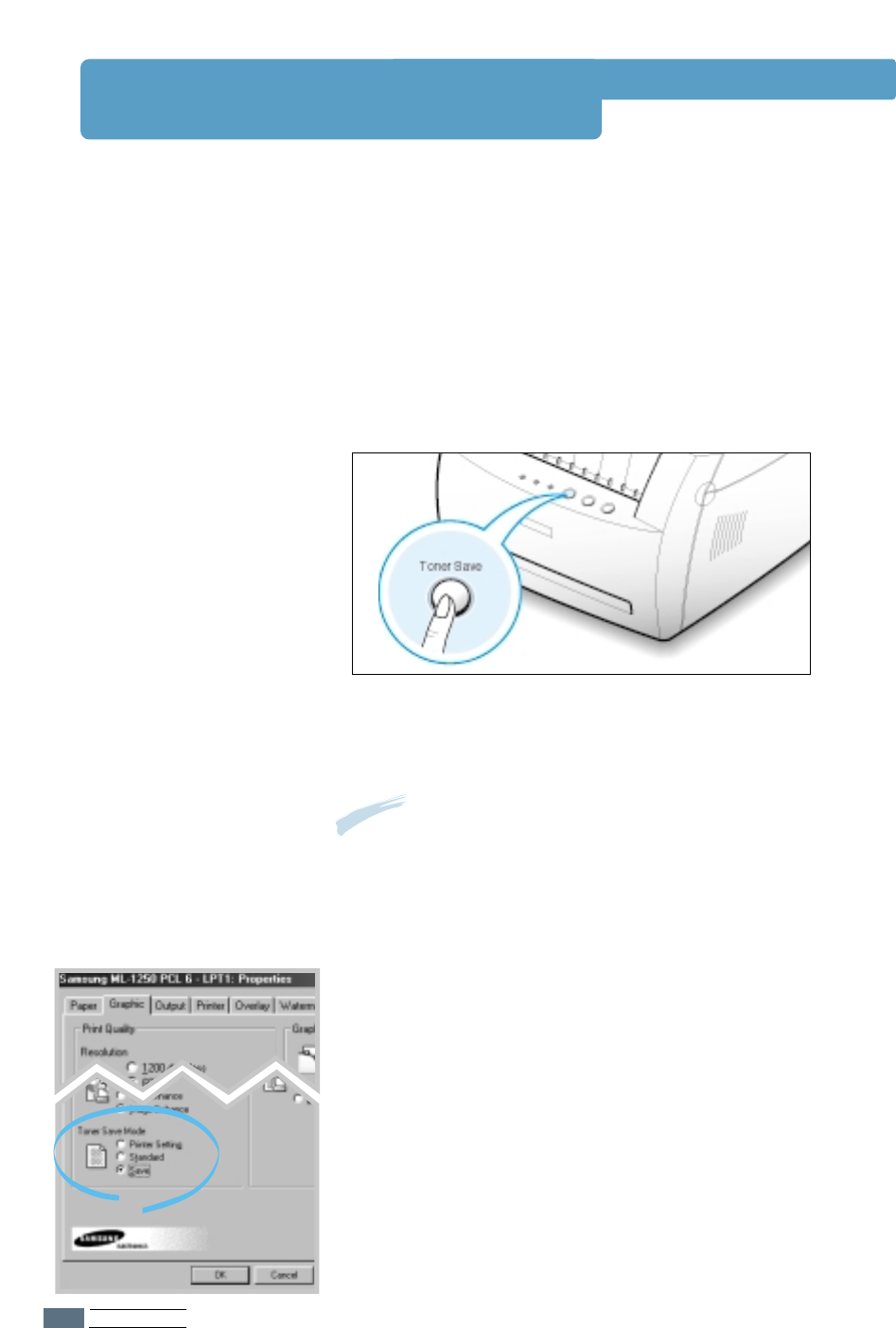
PRINTING TASKS
5.6
Using Toner Save Mode
Toner Save mode allows the printer to use less toner on each
page. Selecting this option will extend the life of your toner
cartridge and reduce your cost per page, but will reduce print
quality.
There are two ways to enable the Toner Save mode.
To enable this feature from your printer
Press the Toner Save button on the control panel. The printer
must be in Ready mode (Data light is on).
• If the button backlight is on, toner save mode activates and
the printer uses less toner to print a page.
• If the button backlight is off, toner save mode is disabled
and the printer prints in a normal mode.
Note: To enable or disable the Toner Save mode from the control
panel, the Toner Save Mode option in the printer driver must be
set to Printer Setting. See below.
To enable this feature from the software application
1
When you change the print settings from your software
application, access the printer properties. See page 5.1 to
access the printer properties.
2
Click the Graphic tab, and then select the Toner Save
Mode option. You can select from:
• Printer Setting: If you select this option, this feature is
determined by the setting you’ve made on the control
panel of the printer.
• Standard: If you don’t need to save toner to print a
document, select this option.
• Save: Select this option to allow the printer to use less
toner on each page.
3
Click OK.
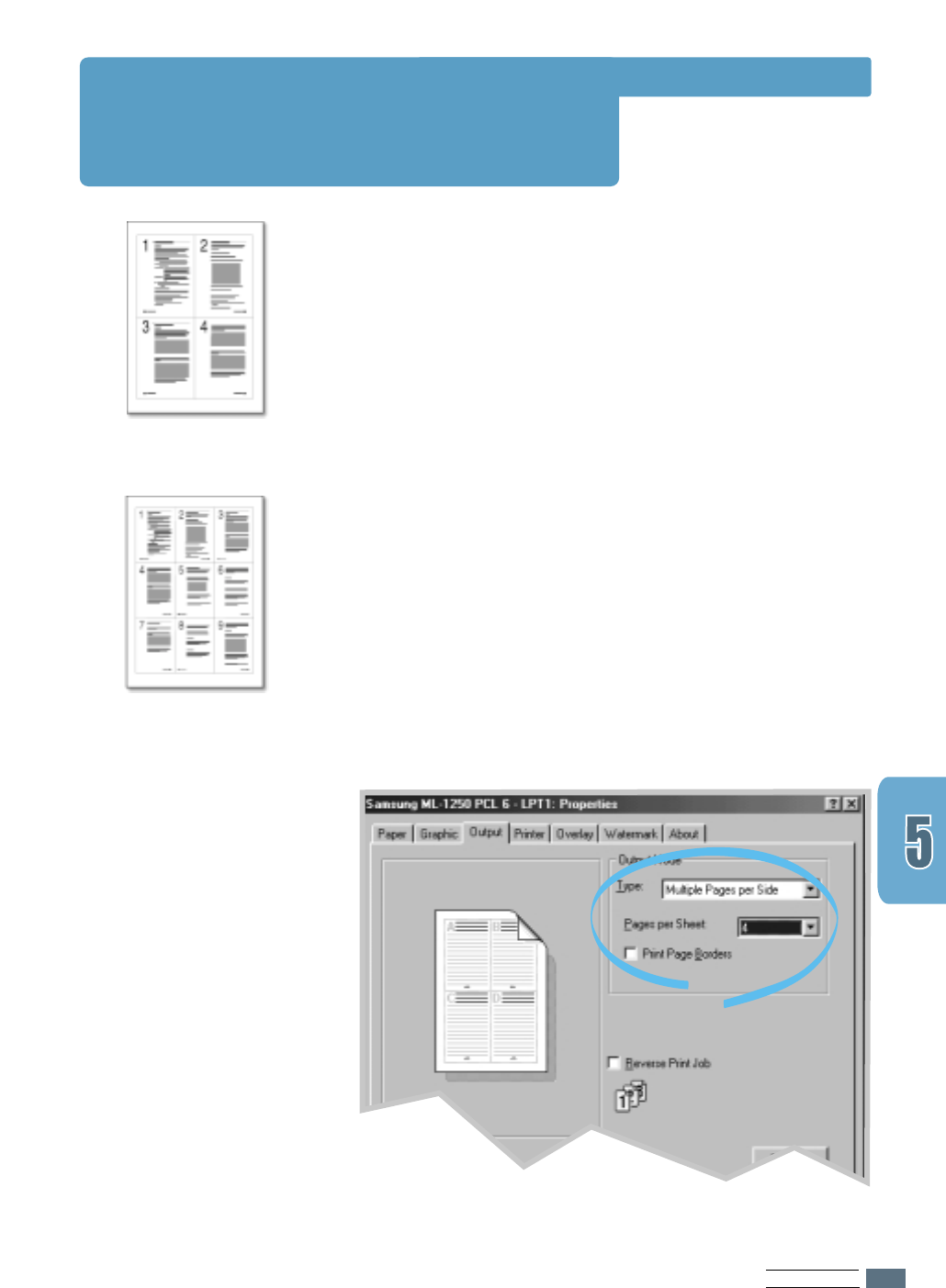
PRINTING TASKS
5.7
You can select the number of pages you want to print on a
single sheet of paper. If you choose to print more than one
page per sheet, the pages will appear decreased in size and
arranged on the sheet. You can specify up to 16 pages.
1
When you change the print settings from your software
application, access the printer properties. See page 5.1 to
access the printer properties.
From the Paper tab, select the paper orientation, source,
size and type.
2
Click the Output tab, and choose Multiple Pages per
Side in the Type drop-down list. Then select the number of
pages you want to print per sheet (1, 2, 4, 6, 9 or 16) in
the Pages per Sheet drop-down list.
3
Click Print Page Borders if you want to print a border
around each page on the sheet. Print Page Borders is
enabled only if Pages per Sheet is 2, 4, 6, 9, or 16.
4 pages per sheet
9 pages per sheet
Printing Multiple Pages on
One Sheet of Paper
(N-Up Printing)
4
Click OK, then start printing.
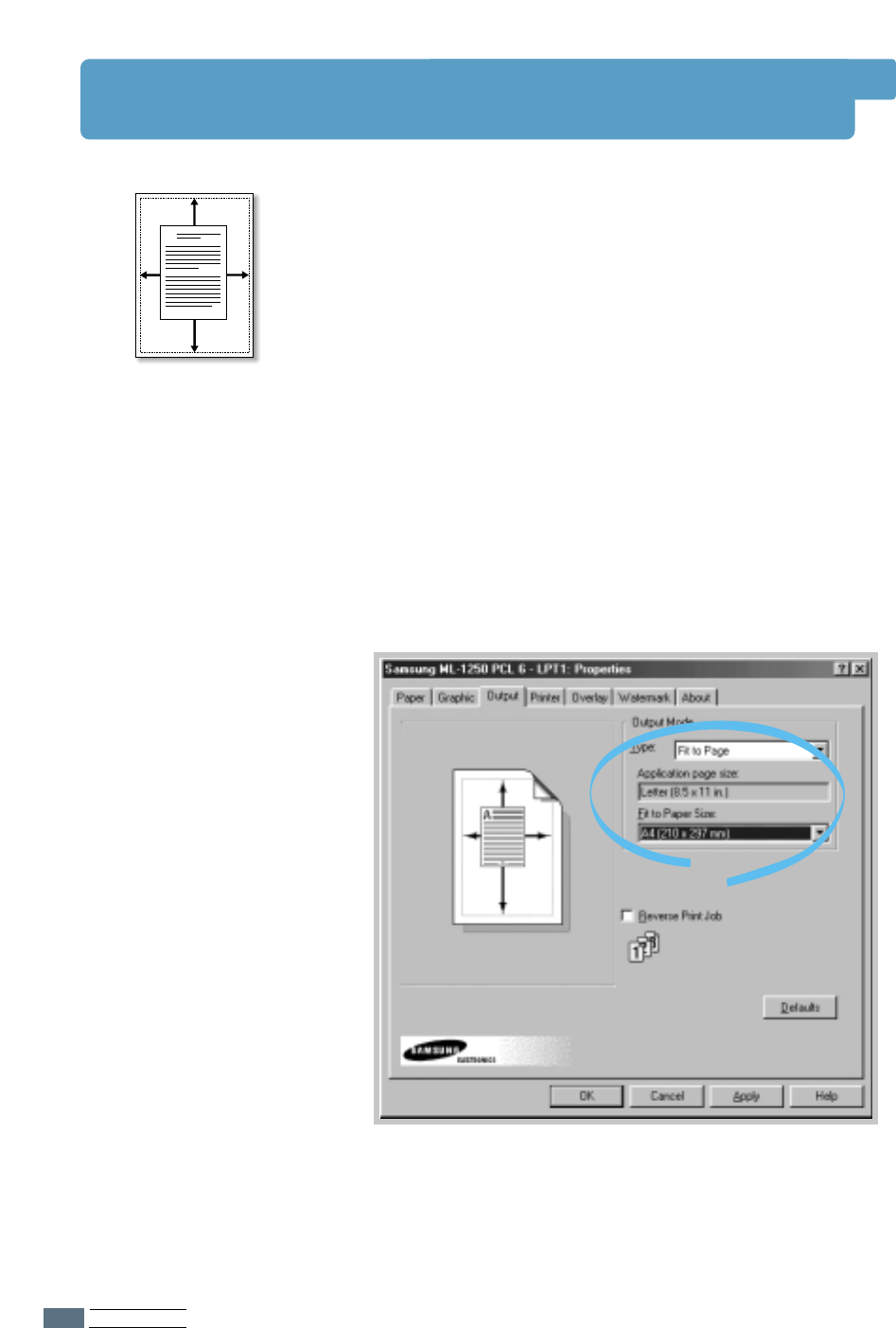
PRINTING TASKS
5.8
4
Click OK, then start printing.
Fitting Your Document To a Selected Paper Size
This printer feature allows you to scale your print job to any
selected paper size regardless of the digital document size.
This can be useful when you want to check fine details on a
small document.
1
When you change the print settings from your software
application, access the printer properties. See page 5.1 to
access the printer properties.
2
Click the Output tab, and select Fit to Page in the Type
drop-down list.
3
You’ll see the Application page size and be prompted to
select the Fit to Paper Size. Select the correct size from
the drop-down list.
A
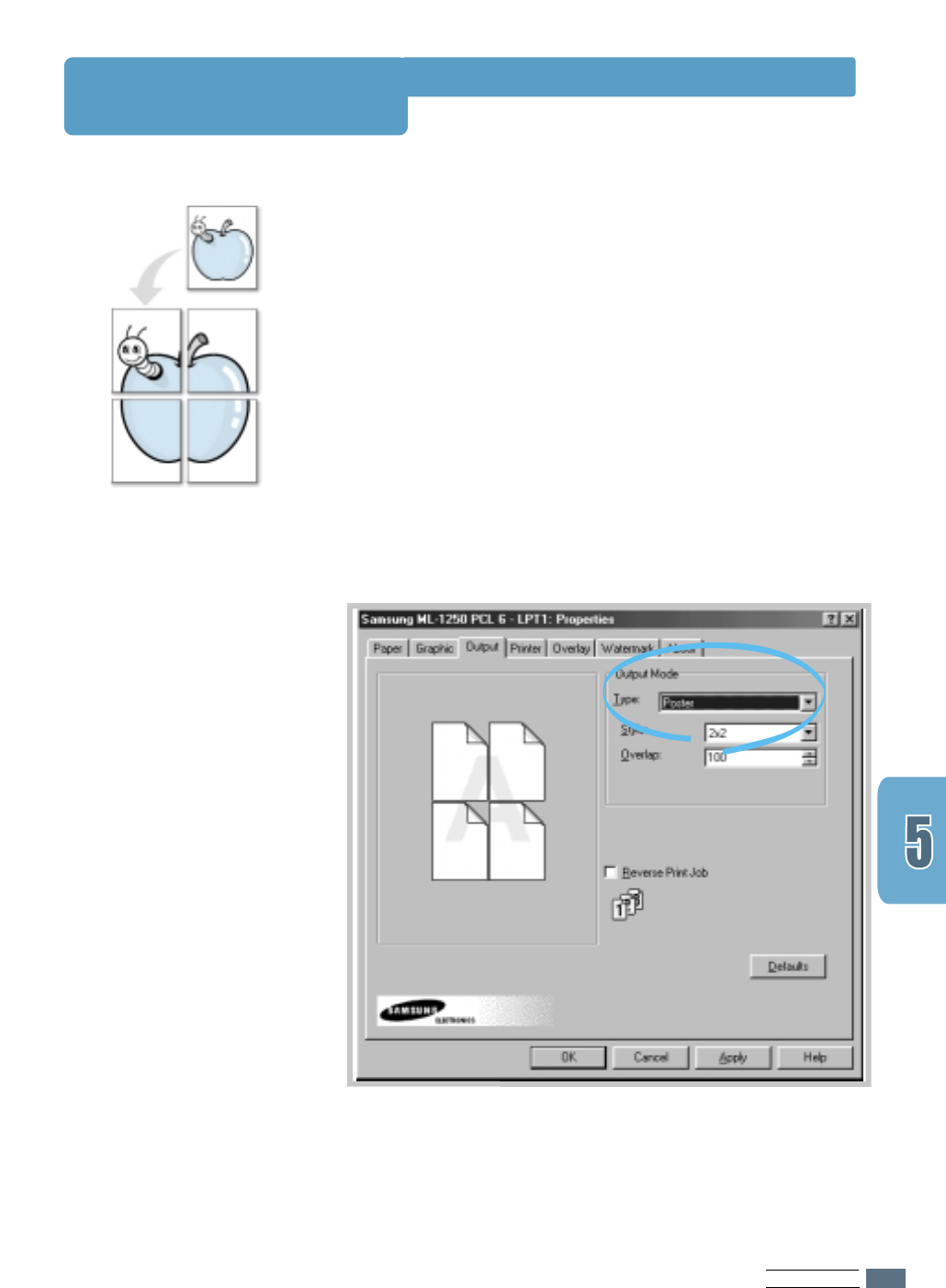
PRINTING TASKS
5.9
Printing Posters
This feature allows you to print a single-page document onto
4, 9, or 16 sheets of paper, which can be pasted together to
form one poster-size document.
1
When you change the print settings from your software
application, access the printer properties. See page 5.1 to
access the printer properties.
From the Paper tab, select the paper orientation, source,
size and type.
2
Click the Output tab, and select Poster in the Type drop-
down list.
Poster printing
with 2x2 style
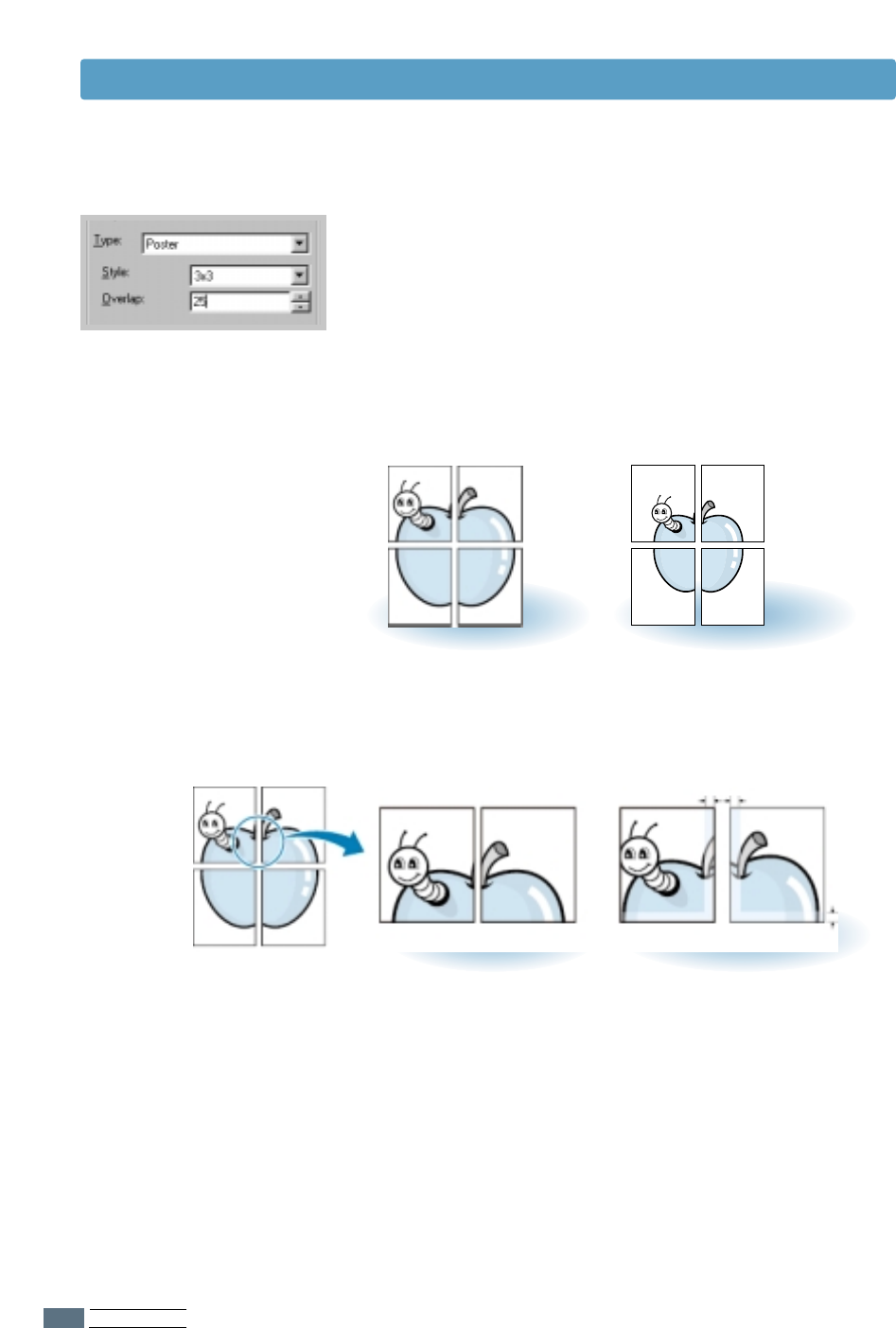
PRINTING TASKS
5.10
➛➛
➛➛2 x 2
Overlap=0
Overlap=25
25 pixels
➛➛
➛➛Custom (150%)
5
Click OK, then start printing.
3
To determine the scaling factor, select the Style; 2x2, 3x3,
4x4, or Custom.
For example, if you select 2x2, the output will be
automatically stretched to cover 4 physical pages.
If you select Custom, you can adjust the scaling factor
manually. For example, if you specify 150%, the image will
be printed across 4 pages with 150% scaled.
4
You may specify an overlap in pixel to make it easier to
reconstruct the resulting poster.
Printing Posters
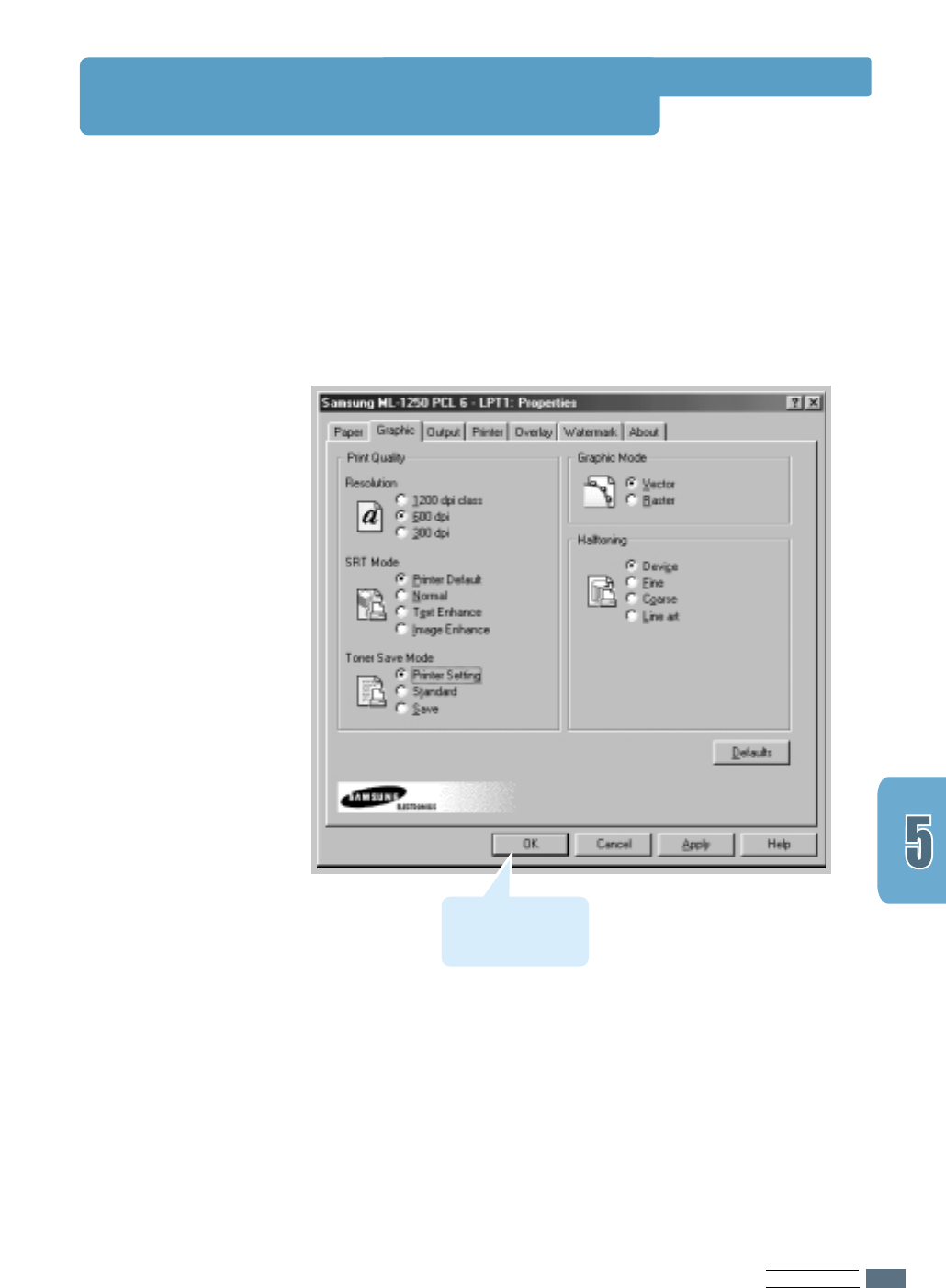
PRINTING TASKS
5.11
Use the following options to adjust the print quality for your
specific printing needs when you access the printer properties.
See page 5.1 to access the printer properties.
If necessary, click the Option tab to display the settings shown
below.
Setting Graphic Properties
Click here to save
the changes when
setting is done.
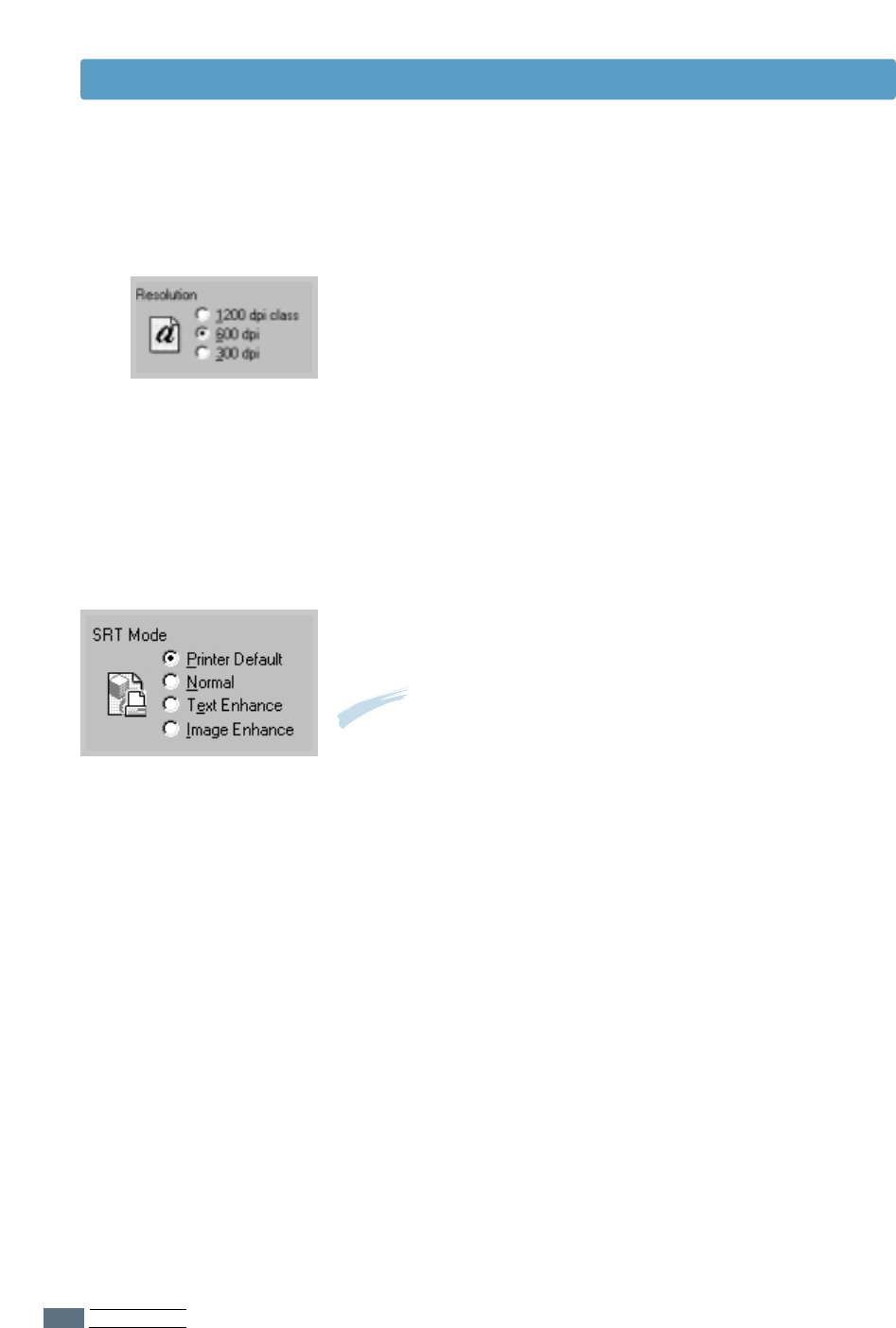
PRINTING TASKS
5.12
You can select the printing resolution; 1200 dpi class,
600 dpi or 300 dpi. The higher the setting, the sharper the
clarity of printed characters and graphics. Higher settings may
increase the time it takes to print a document.
Resolution
Some printed characters or images appear to have jagged or
uneven edges. Set this Samsung Resolution enhancement
Technology (SRT) option to improve the print quality of your
text and image and make the characters and images appear
smoother.
Note: When 600 dpi is selected in the Resolution section,
selecting Text Enhance or Image Enhance gives you an image
quality of 1200 dpi class .
• Printer Default - This is determined by the setting on the
printer.
• Normal - SRT mode is disabled. Choose this setting if
graphics, particularly scanned images, are not
printing clearly.
• Text Enhance - This setting refines the print quality of
characters by smoothing out jagged edges
that can occur on the angles and curves of
each character.
• Image Enhance - This setting refines the print quality of a
photo image using SRT.
SRT Mode
Setting Graphic Properties
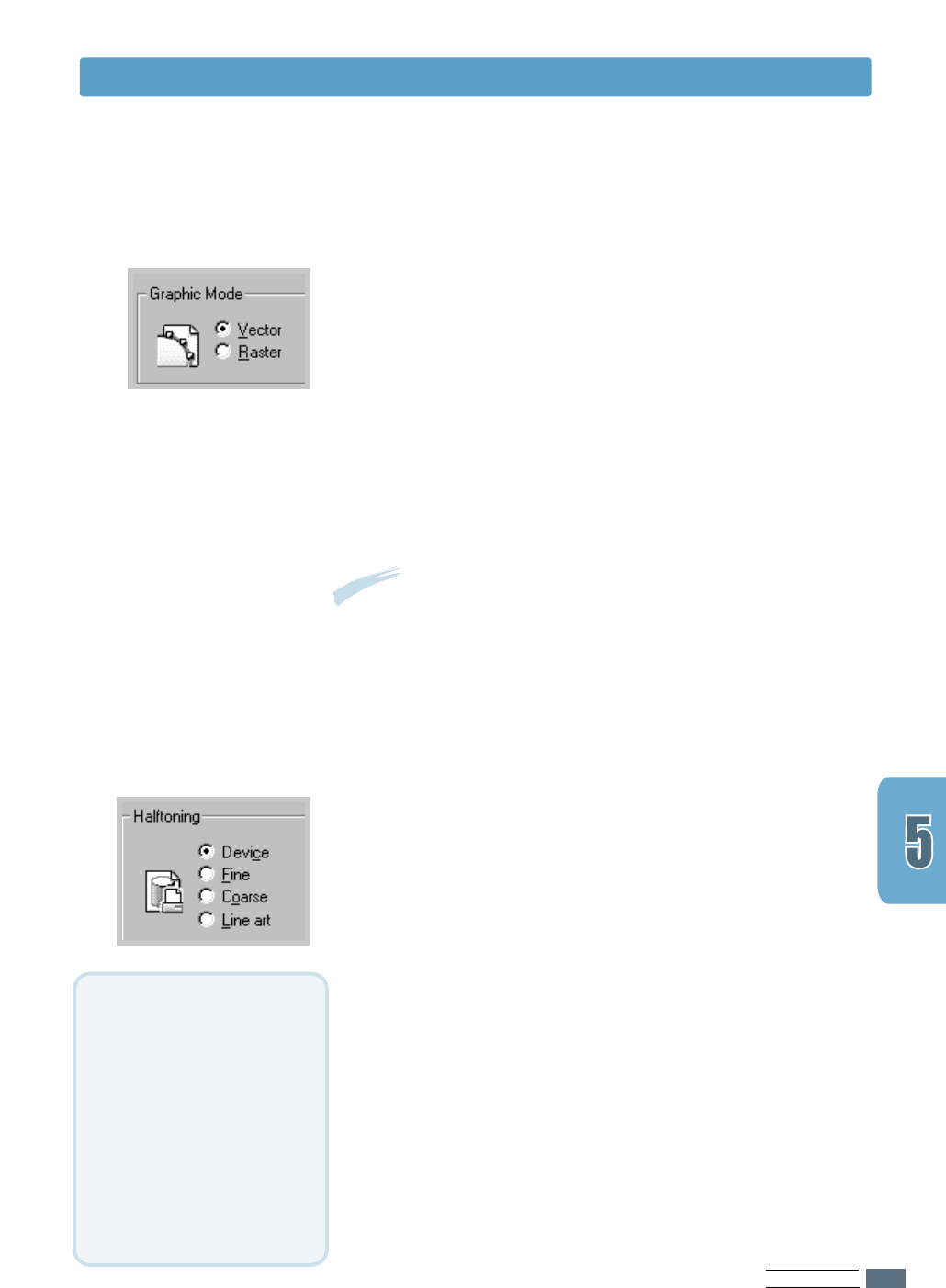
PRINTING TASKS
5.13
Note: Not all graphic images can print using the Vector setting.
If you are using the Vector setting, and your graphic images do
not print as they appear on your computer screen, select the
Raster setting and reprint your graphic.
Configure the printer to process graphics as raster or vector
images. Setting this option tells Windows how to send graphic
images to the printer. All graphics can be printed as raster
images, however some geometric shapes or patterns print
faster if they are printed as vector graphics.
• Vector – The Vector mode represents a graphic as point,
lines and other geometric entities. If you select the
Vector setting, Windows will send graphics to the
printer as a mixture of vector and raster images.
• Raster – The Raster mode represents a graphic as a mix of
dots. When you select the Raster setting, Windows
will send all graphics to the printer as bit map
raster images.
Graphic Mode
This option can be used for configuring the halftone of the
printed illustration. The best way to choose a Halftoning setting
for your graphic image is to experiment. Print a graphic image
at each setting and choose the one you like best.
• Device - Choose this setting to allow the printer to
determine a halftoning setting.
• Fine - Choose this setting when you want printed images to
have a smooth, realistic, and photographic
appearance. This setting provides soft contrasts
between various shades of gray. This setting also
works well for images originally designed with color.
• Coarse - Choose this setting if your graphic images were
originally scanned in through a scanner.
• Line art - Choose this setting for graphic images with
intricate lines and fine detail, like clip art graphics.
This setting provides solid lines and sharp
contrasts between shaded areas.
Halftoning
Setting Graphic Properties
What is Halftone?
Gray-scale objects (such as
photographs) whose gray dots
have been converted to a
pattern of groups of black dots.
These groups, which are of
various sizes, along with the
white dots (pixels turned off),
create illusions of gray shading:
larger groups make the image
appear black or dark gray, while
smaller groups make the image
appear light gray.
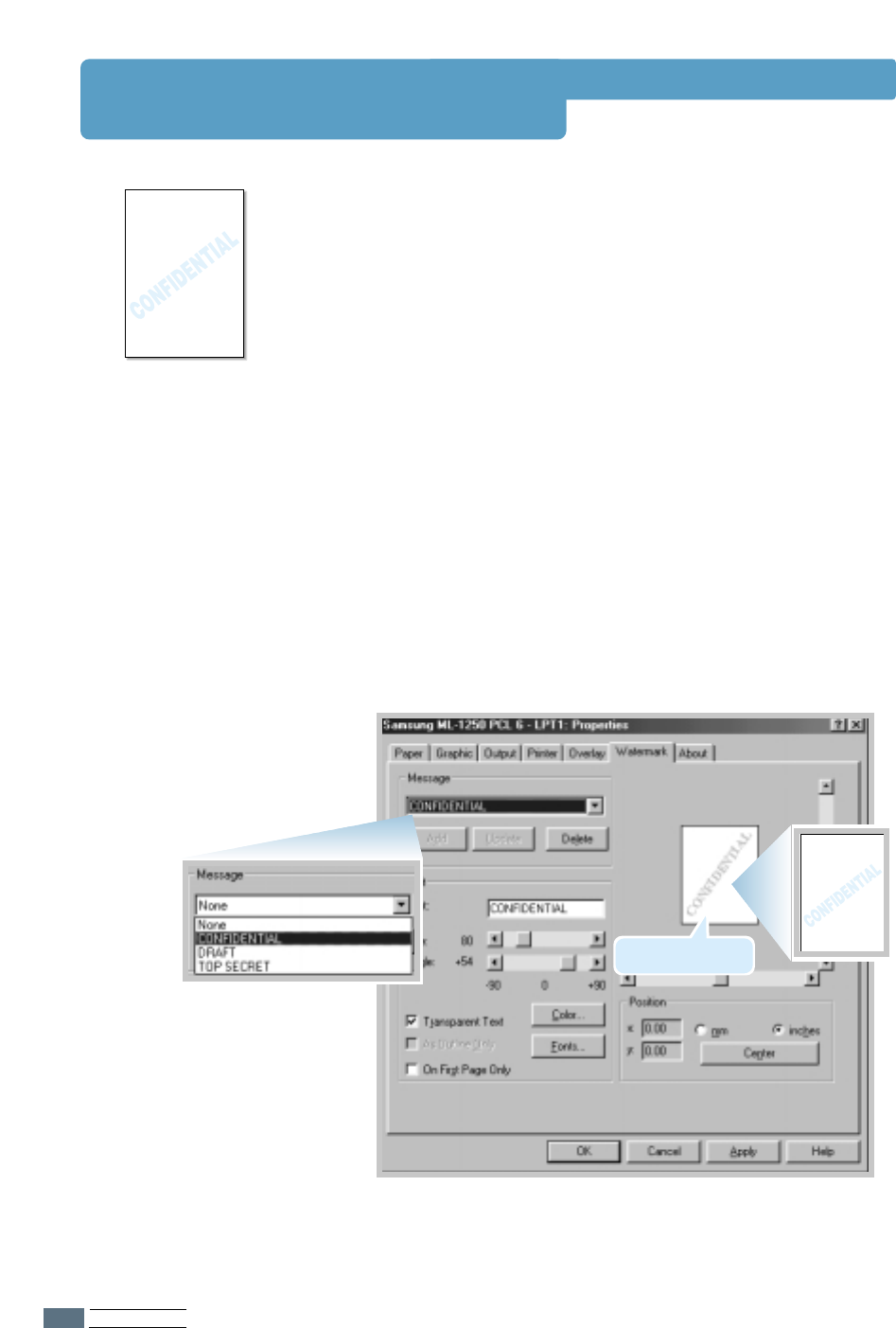
PRINTING TASKS
5.14
Printing Watermarks
The Watermark option allows you to print text over an existing
document. For example, you may want to have large gray
letters reading “Draft” or “Confidential” printed diagonally
across the first page or all pages of a document.
There are several predefined watermarks that come with the
ML-1250 printer, and they can be modified or you can add new
ones to the list.
1
When you change the print settings from your software
application, access the printer properties. See page 5.1
to access the printer properties.
2
Click the Watermark tab, and select the desired
watermark in the Message drop-down list. You will see
the selected watermark in the preview window.
3
Click OK, then start printing.
To use an existing
watermark
preview window
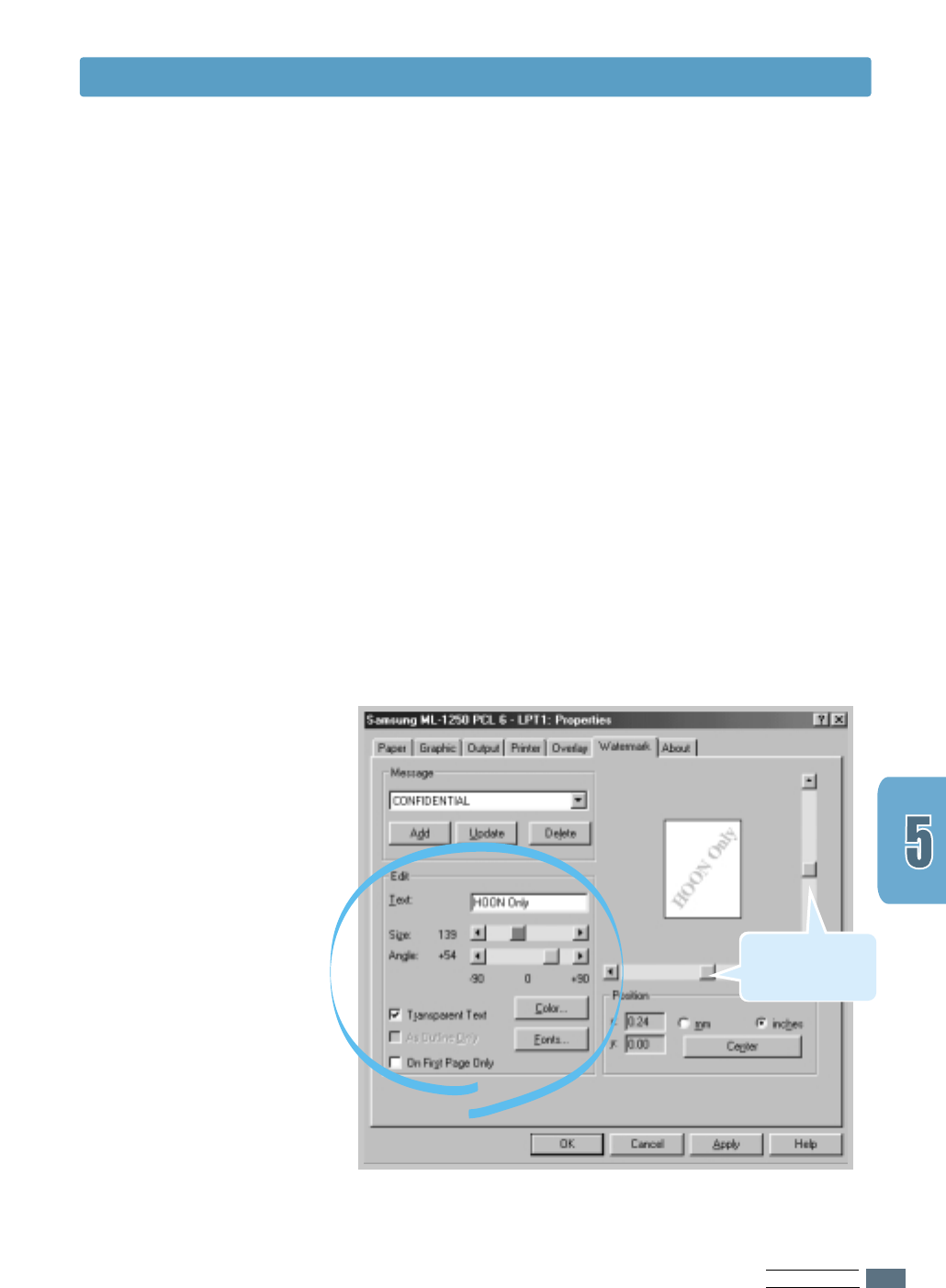
PRINTING TASKS
5.15
1
When you change the print settings from your software
application, access the printer properties. See page 5.1 to
access the printer properties.
2
Click the Watermark tab, and enter the desired text
message in the Text field. This will be displayed in the
preview window. The preview window is provided so that you
can see how the watermark will appear on the printed page.
3
Select the desired watermark options. You can select the
font type and size, color and angle. There are three
checkboxes at the bottom of the dialog box:
• Transparent Text – Allows the document to show
through the watermark.
• As Outline Only – Prints the text outline of the
watermark. This setting globally effects
all watermarks in the list.
• On First Page Only – Prints the watermark only on the
first page.
To create or edit a
watermark
Printing Watermarks
Use these scroll
bars to adjust the
position.
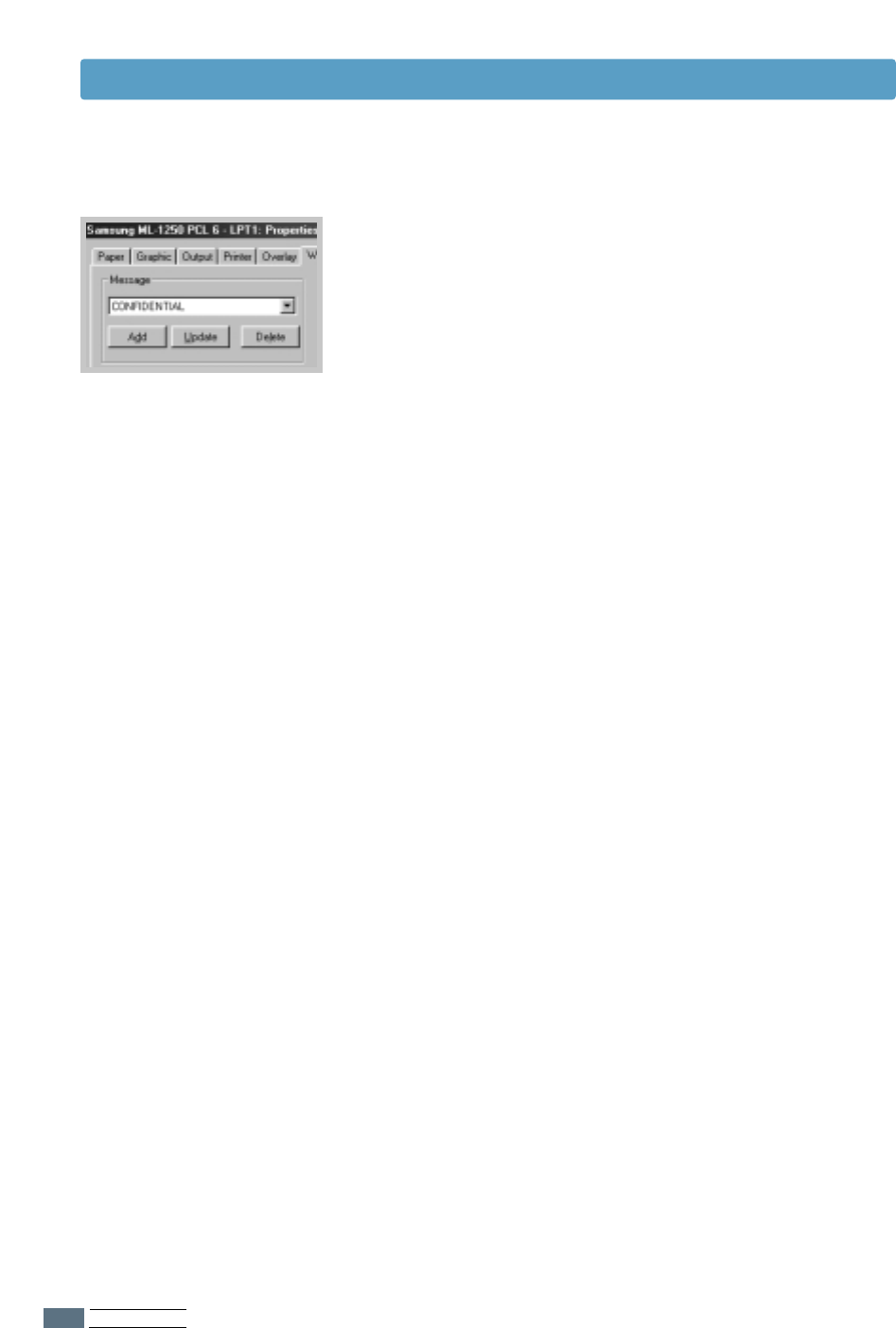
PRINTING TASKS
5.16
4
If you have created a new or edited an existing watermark,
the Add and Update button is enabled.
To add a new watermark to the list, click Add.
5
If you want to edit, select the desired watermark from the
list, edit, and then click Update.
6
When you complete the edit, click OK, and then start
printing.
To stop printing the watermark, select None in the Message
drop-down list.
1
When you change the print settings from your software
application, access the printer properties. See page 5.1 to
access the printer properties.
2
From the Watermark tab, select the watermark you want
to delete in the Message drop-down list.
3
Click Delete.
4
Click OK.
To delete a watermark
Printing Watermarks
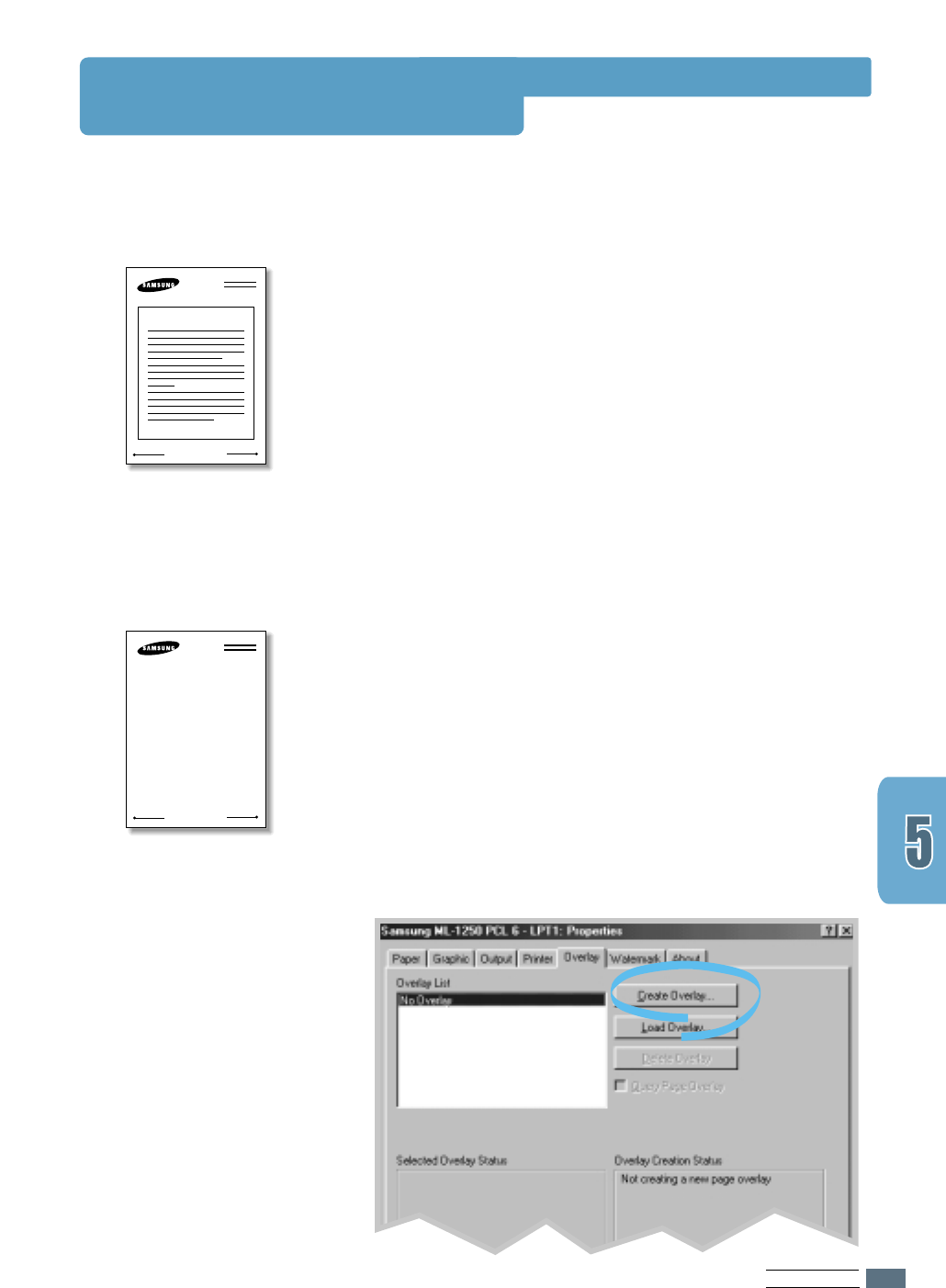
PRINTING TASKS
5.17
Using Page Overlay
An overlay is text and/or images stored in the computer HDD
as a special file format that can be printed on any document
you choose. Overlays are often used to take the place of
preprinted forms and letterhead paper. Rather than using
preprinted letterhead, for example, you can create an overlay
containing the exact same information that is currently on
your letterhead. Then when you want to print a letter with
your company’s letterhead, you do not need to load preprinted
letterhead paper in the printer. You need only tell the printer
to print the letterhead overlay on your document.
What is an Overlay?
WORLD BEST
Dear ABC
Regards
To use a page overlay, you must create a new page overlay
containing your logo or image.
1
Create or open a document containing a text or image you
want to use for page overlay. Position the items exactly as
you wish them to appear when printed as an overlay. If
needed, save the file for later use.
2
Select Print from the File menu. Then click Properties in
the application’s Print dialog box to access the printer
properties. For details, see page 5.1.
3
Click the Overlays tab, and click Create Overlay.
Creating a New Page
Overlay
WORLD BEST
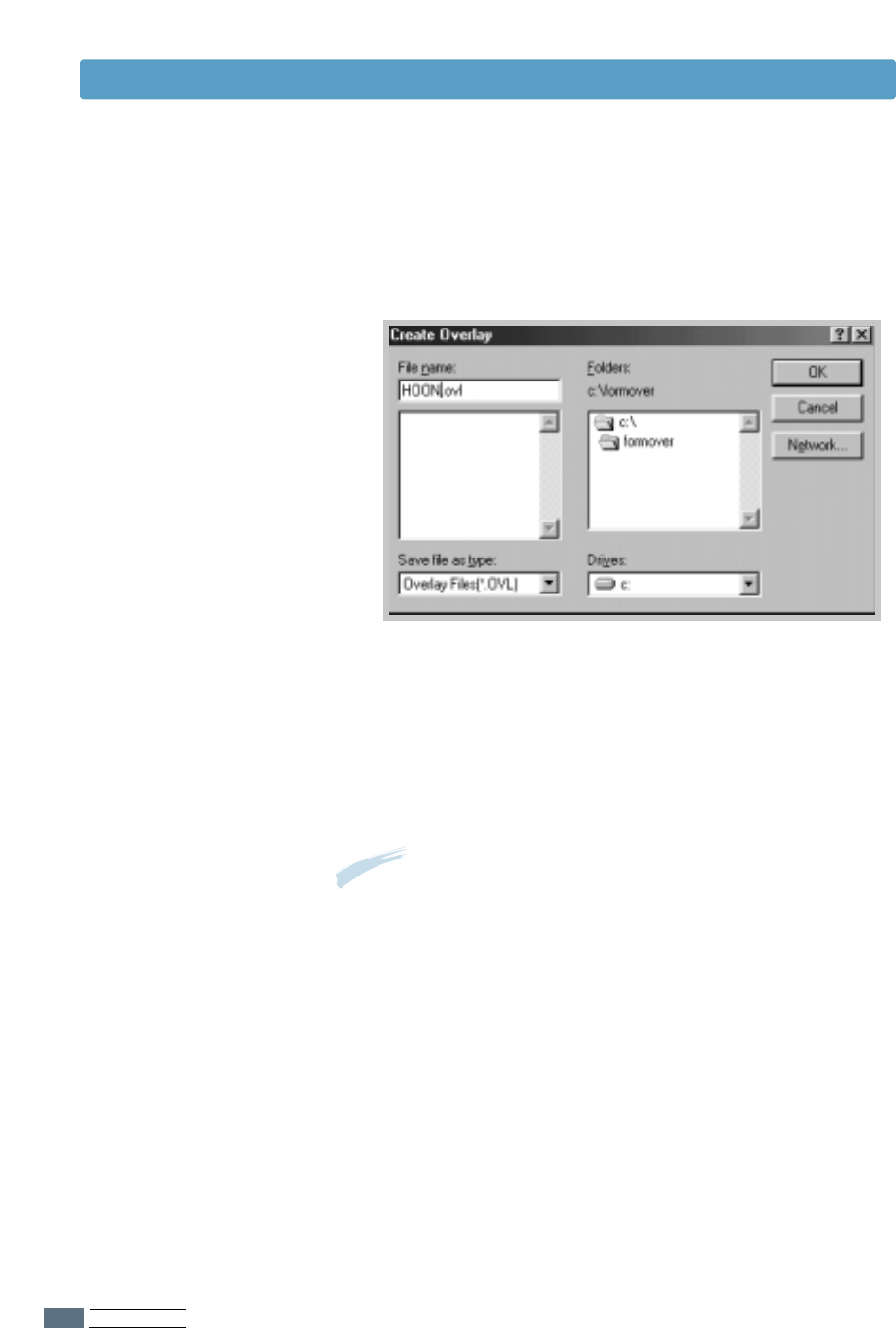
PRINTING TASKS
5.18
4
In the Create Overlay dialog box, type a name of up to
eight characters in the File name box. Select the
destination path if necessary. (The default is
C:\FORMOVER).
5
Click OK. You will see the name in the Overlay List box.
6
Click OK or Yes until you complete the creation.
The file is not printed out. Instead it will be stored on your
computer HDD disk.
Note: The overlay document size must be the same as
documents you will print with the overlay.
Using Page Overlay
After an overlay has been created, it is ready to be printed
with your document. To print an overlay with a document:
1
Create or open the document you want to print.
2
When you change the print settings from your software
application, access the printer properties. See page 5.1 to
access the printer properties.
3
Click the Overlays tab, and select the desired overlay from
the Overlay List box.
Using Page Overlay
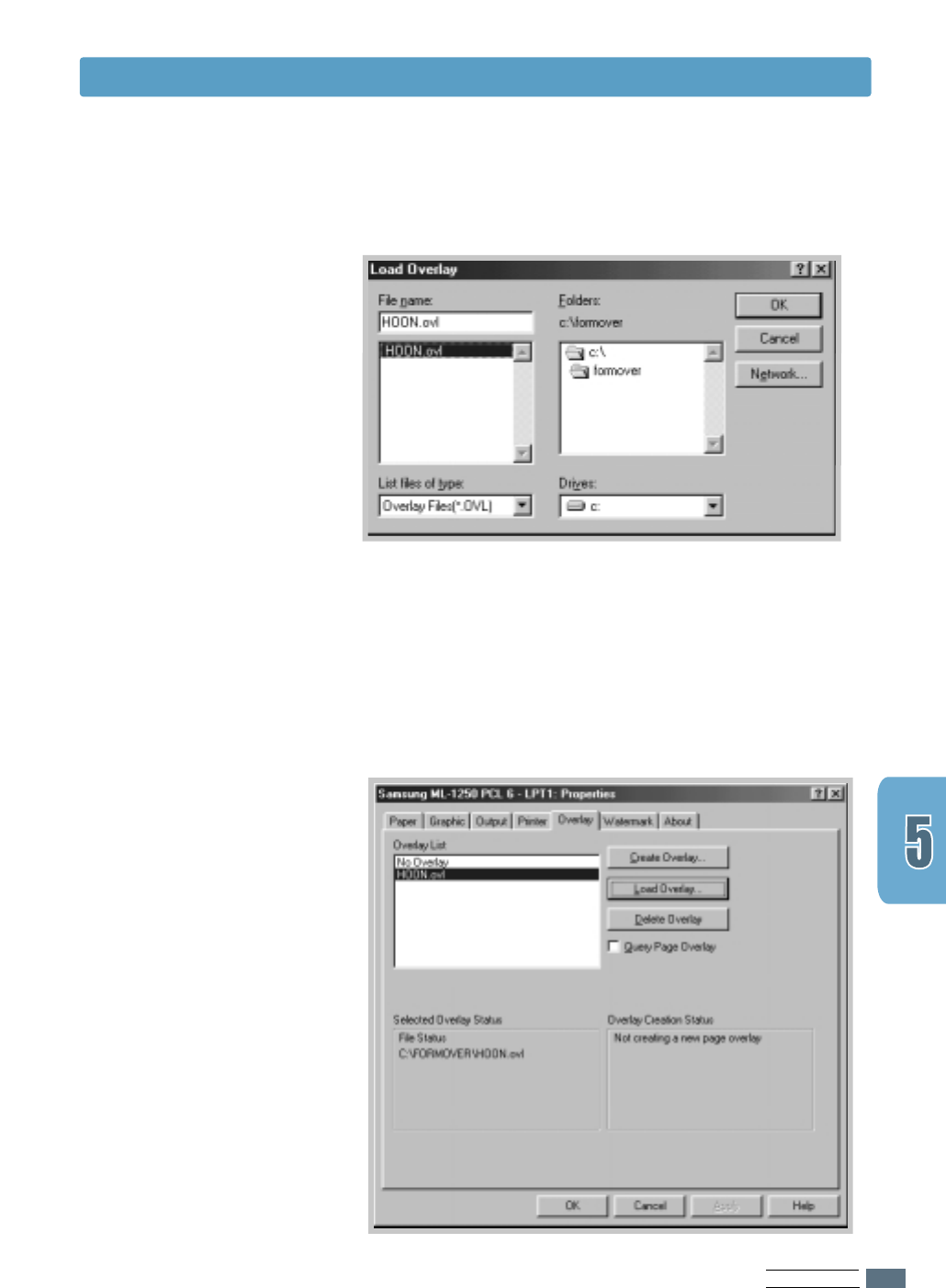
PRINTING TASKS
5.19
Using Page Overlay
4
If the desired overlay file does not appear in the Overlay
List box, click Load Overlay, and select the overlay file.
If you have stored the overlay file you want to use into an
external source, you can also load the file when you access
this Load Overlay window.
After you select the file, click OK. The file is now shown in
the Overlay List box and is available for printing. Select
the overlay from the Overlay List box.

PRINTING TASKS
5.20
You can delete page overlays that are no longer used.
1
In the printer properties dialog box, click the Overlays tab.
2
Select the overlay you want to delete from the Overlay
List box.
3
Click Delete Overlay.
4
Click OK until you exit the Print dialog box.
Deleting a Page Overlay
5
If necessary, click Query Page Overlay. If this box is
checked, a message box will appear each time you submit a
document for printing, asking you to confirm your wish to
print an overlay on your document.
Answering Yes to the message box means that the selected
overlay will be printed with your document.
Answering No to the message box cancels overlay printing.
If this box is empty, and an overlay has been selected, the
overlay will be automatically printed with your document.
6
Click OK or Yes until the printing starts.
The selected overlay will be downloaded with your print job
and printed on your document.
Using Page Overlay
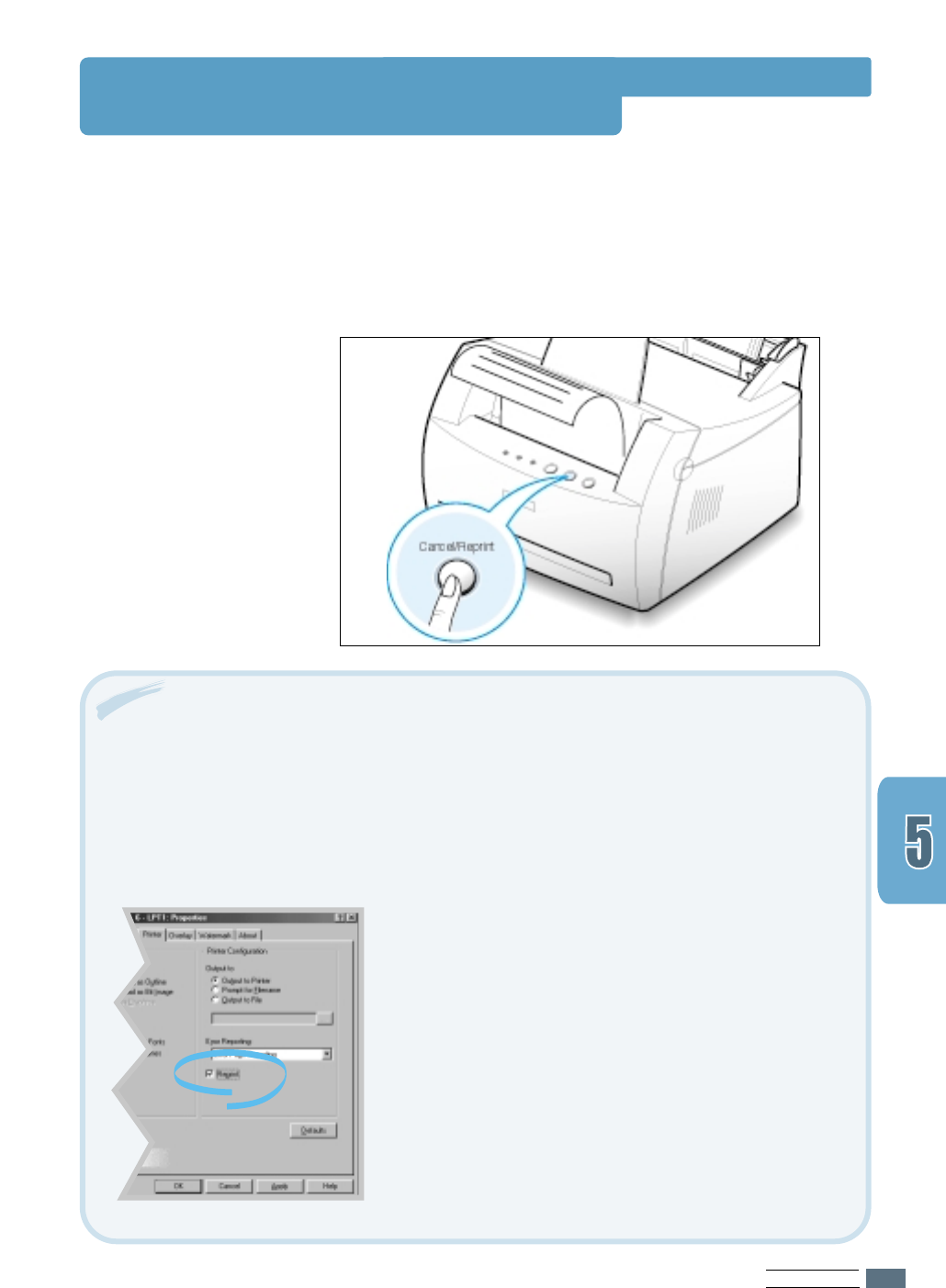
PRINTING TASKS
5.21
Reprinting the Last Page
The Samsung ML-1250 printer’s memory always keeps the last
page of the last job. If you canceled a print job due to a paper
jam or other problems and you want to know which page was
printed last, reprint the last page.
Press Cancel/Reprint briefly in Ready mode.
To disable this feature:
1. From the Start menu, select Settings and then Printers.
2. Click the right mouse button on the Samsung ML-1250
PCL 6 printer icon and select Properties to open the
properties window.
3. From the Printer tab, click Reprint to empty the
checkbox.
With the box empty, you cannot reprint the last page
from the control panel.
When you want to reprint the last page on the control
panel, you must put a check mark on this check box.
4. Click OK.
Note: If you want to prevent somebody from reprinting your document, you can turn the
Reprinting feature off in the printer’s properties dialog box. When you turn the feature
off in the printer’s properties, the Cancel/Reprint button on the control panel does not
perform the reprinting operation.
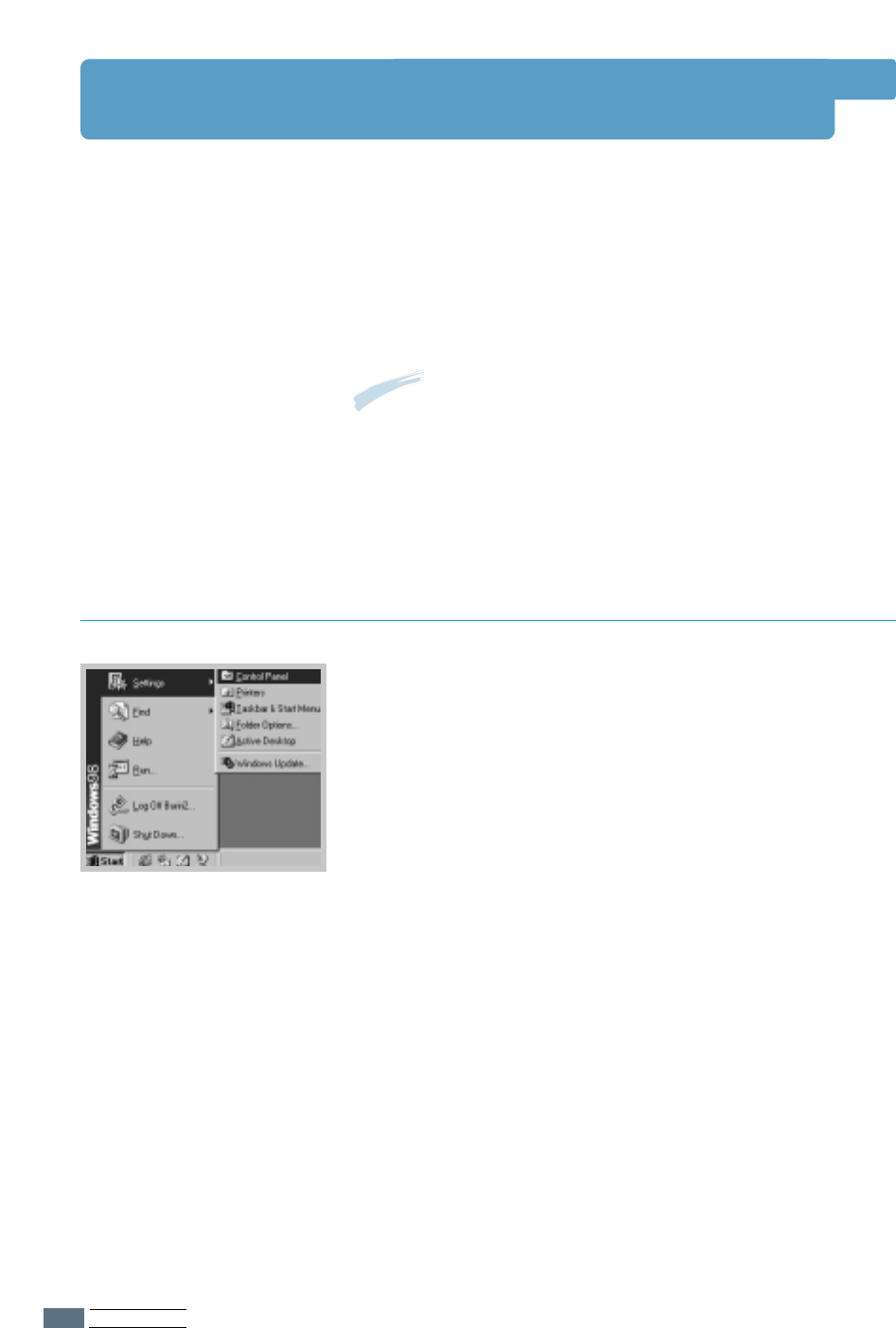
PRINTING TASKS
5.22
Printing on a Network Environment
If you work in a network environment, you can connect your
ML-1250 printer directly to a selected computer (called the
“host computer”) on the network. The printer can then be
shared by other users on the network through a Windows
9x, Me, NT 4.0 or 2000 network printer connection.
Note: You need to install the Samsung ML-1250 printer driver
on each computer that will print documents to the printer.
1
Start Windows.
2
From the Start menu, select Control Panel, and
double-click on the Network icon.
3
Check the File and Print Sharing box, then click OK.
Close the window.
4
Click Start and select Printers from Settings, then
double-click your printer name.
5
Select Properties in the Printers menu.
6
Click the Sharing tab, then check the Shared As box.
Fill in the Shared Name field, then click OK.
Setting Up Host Computer